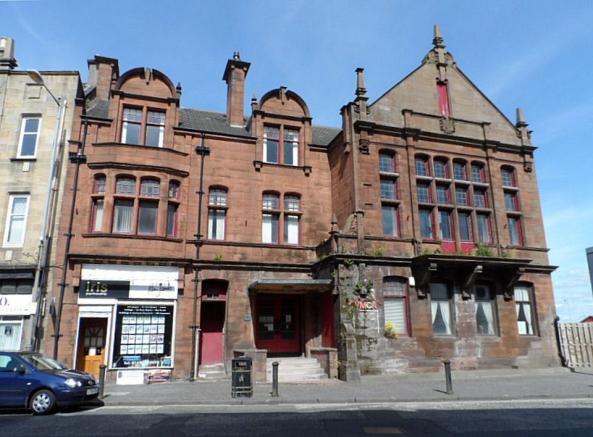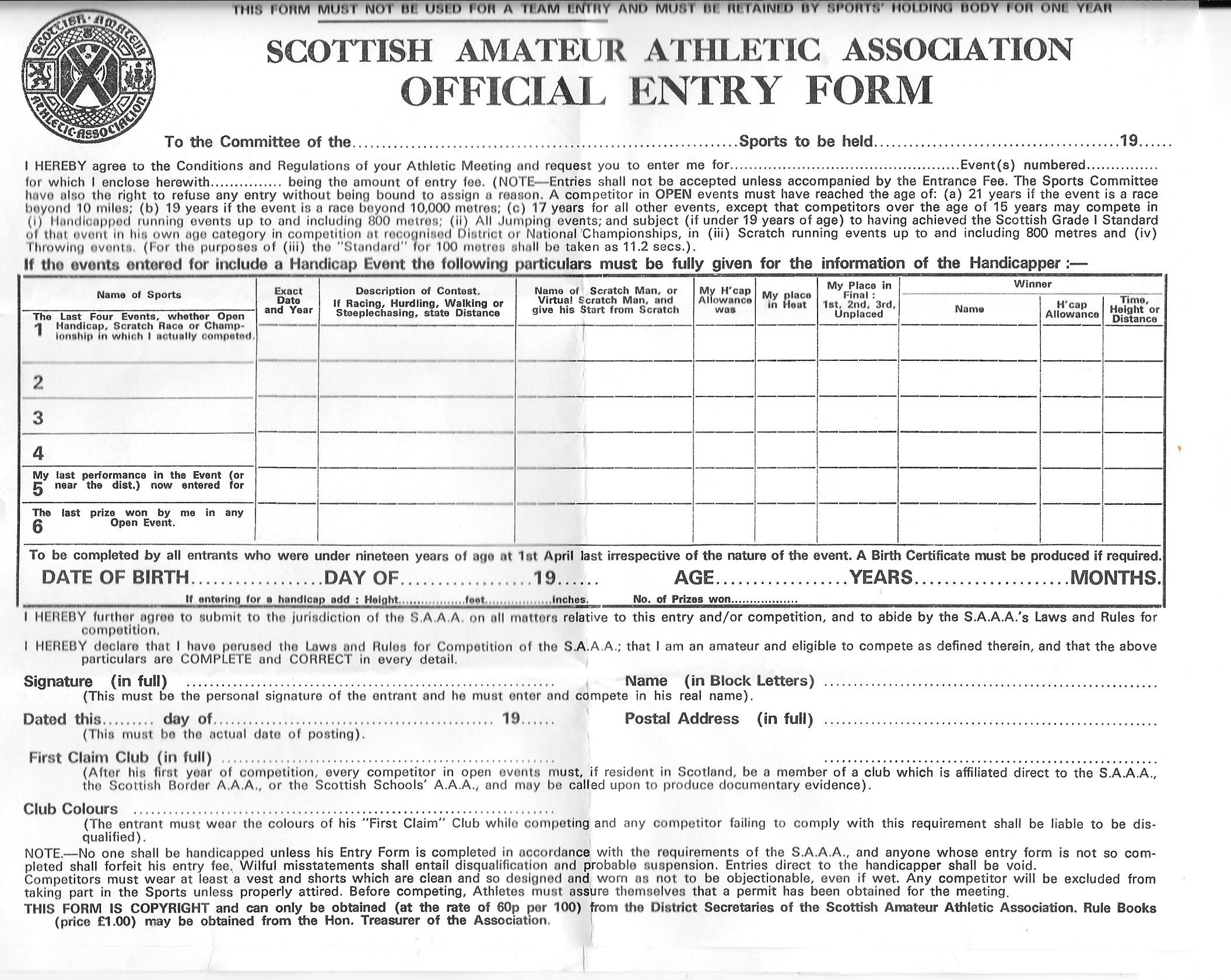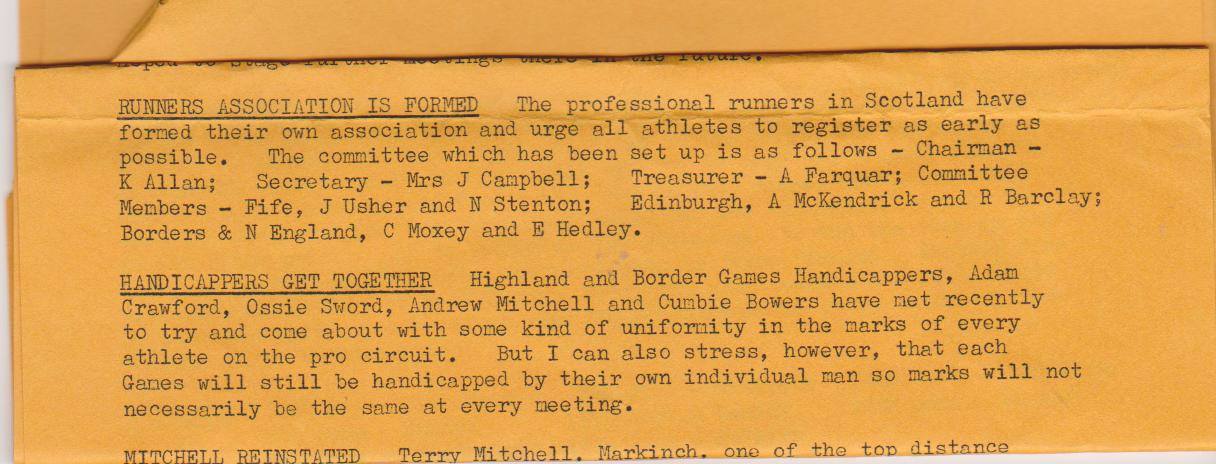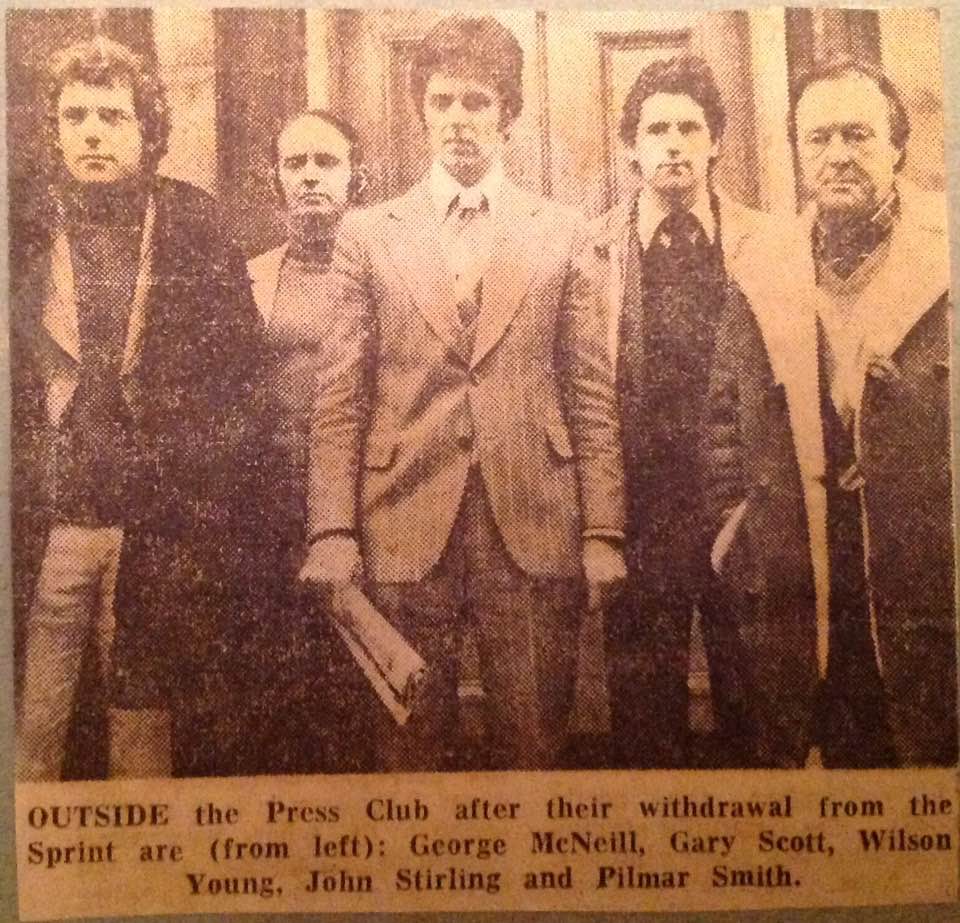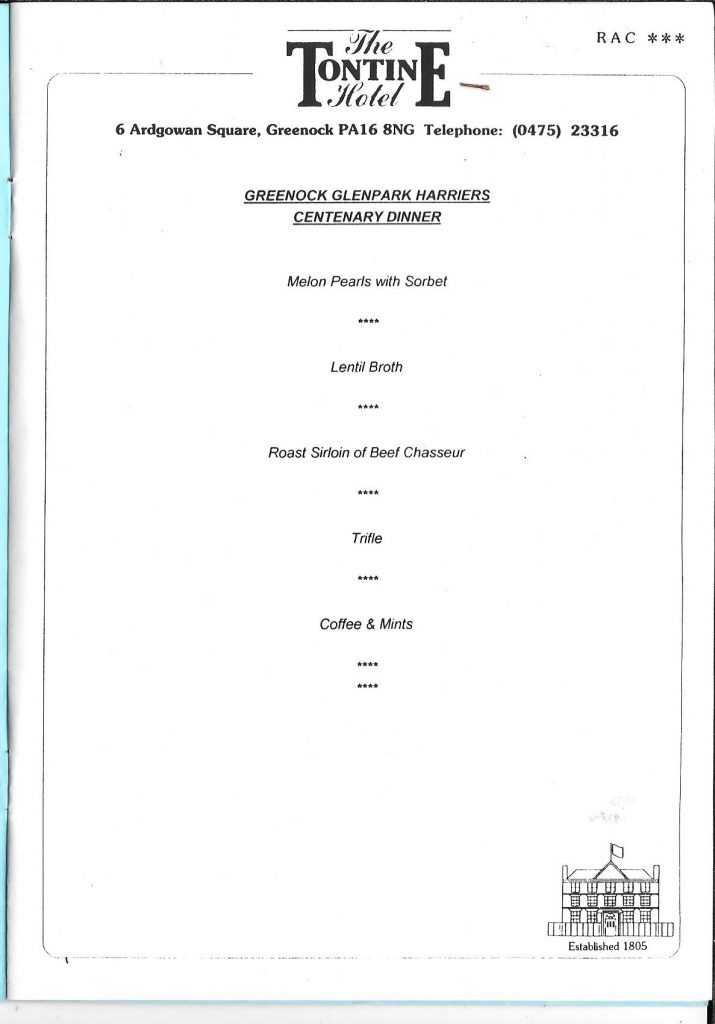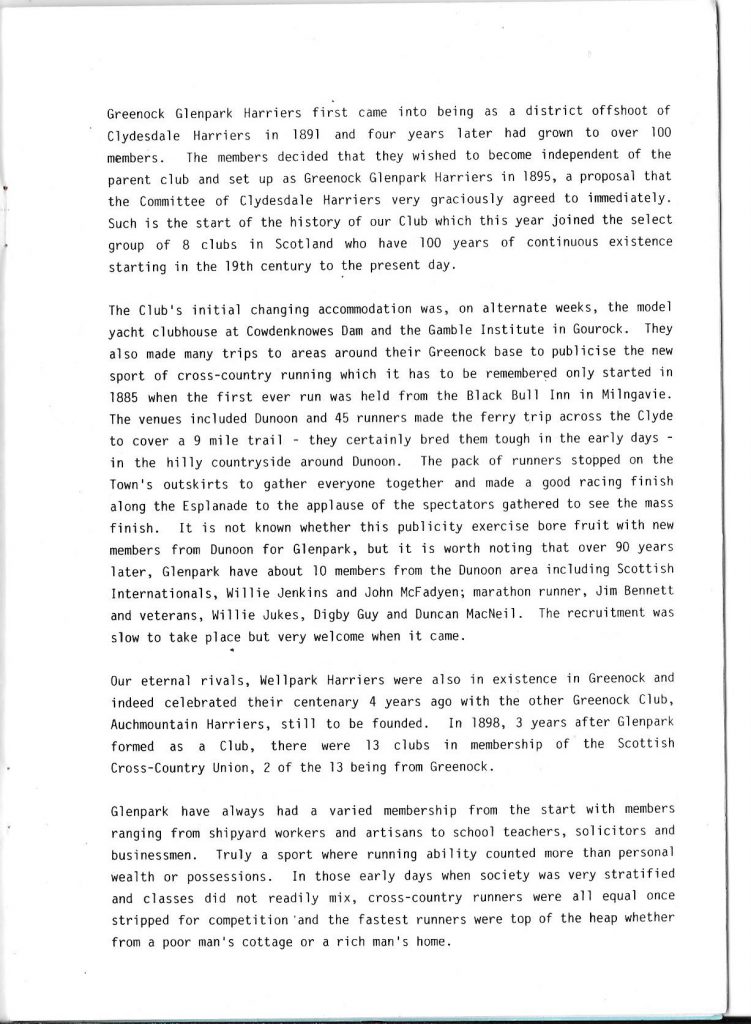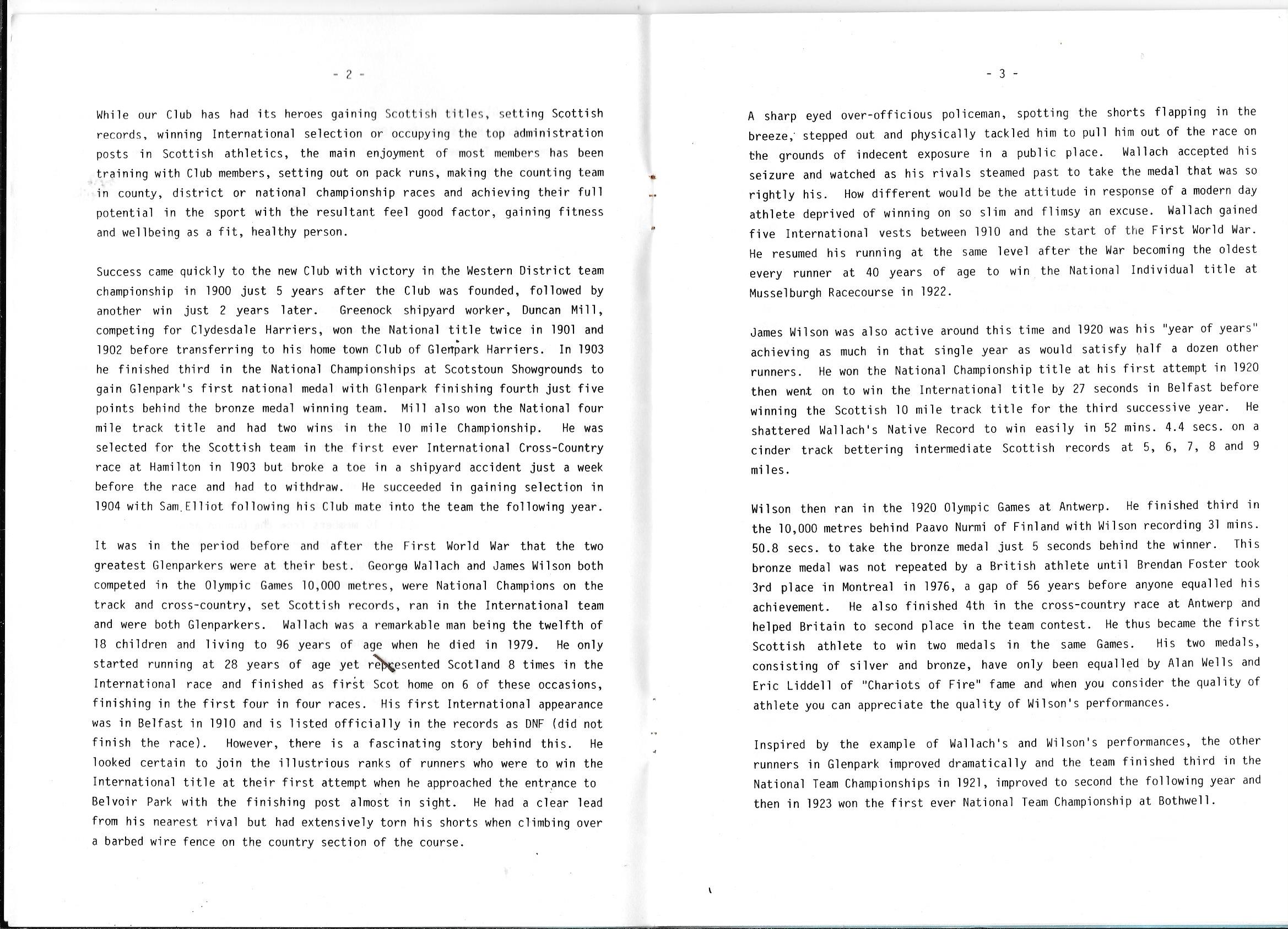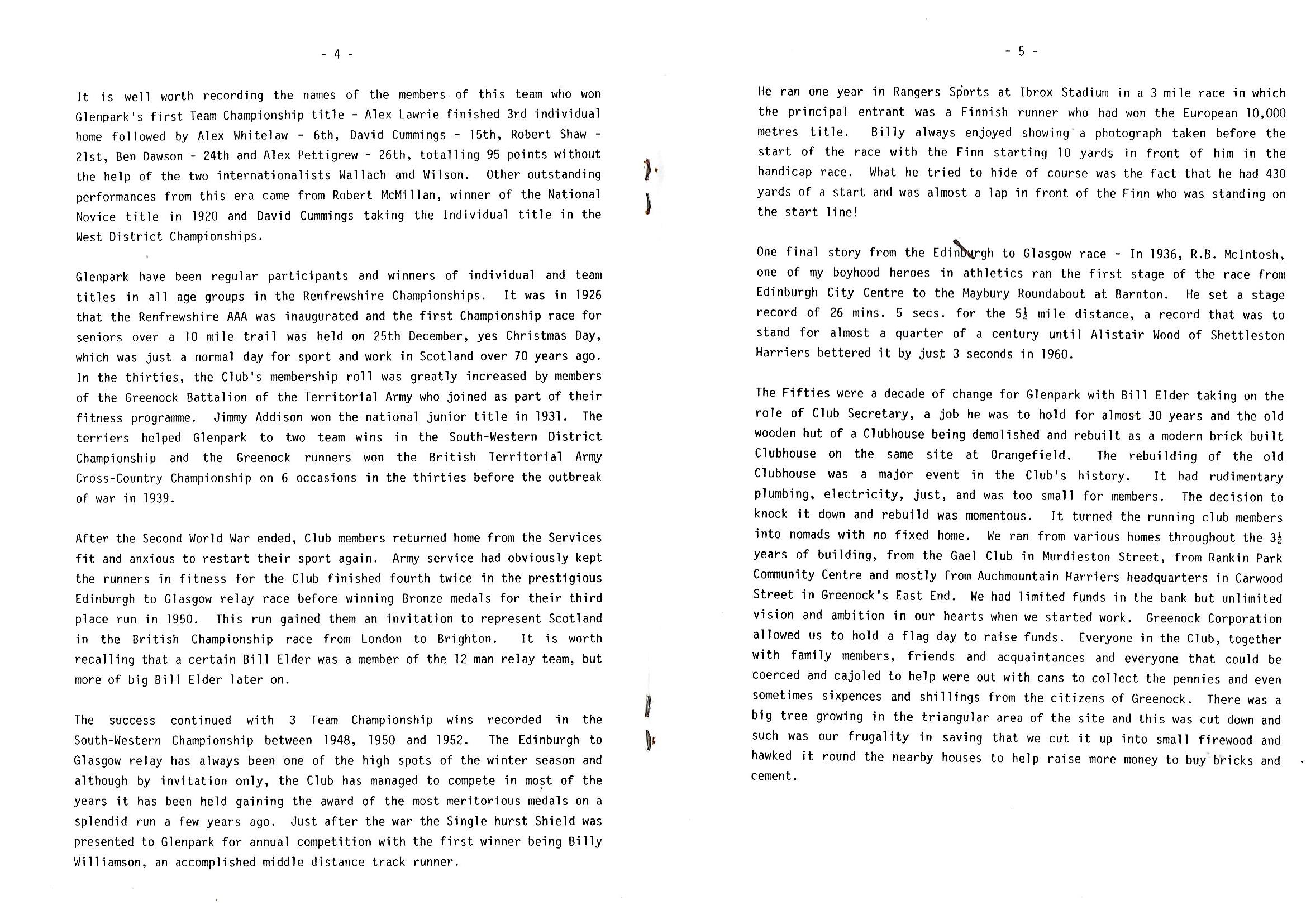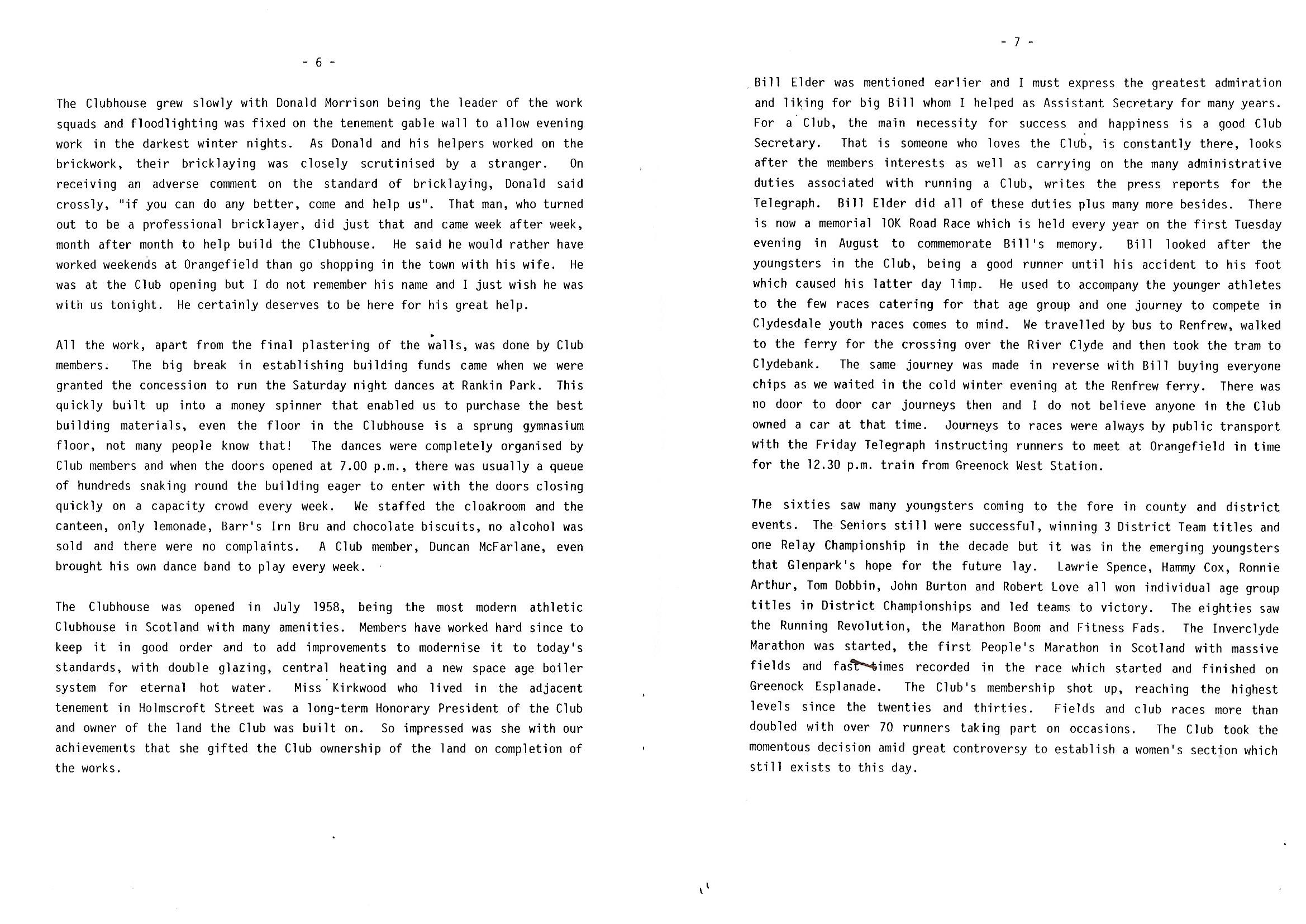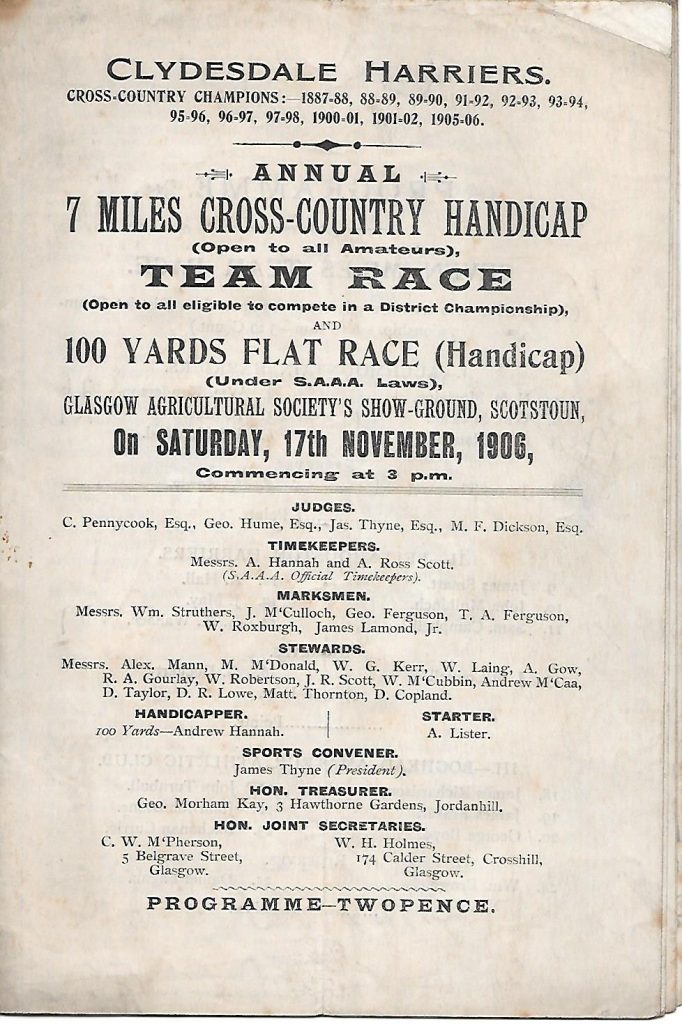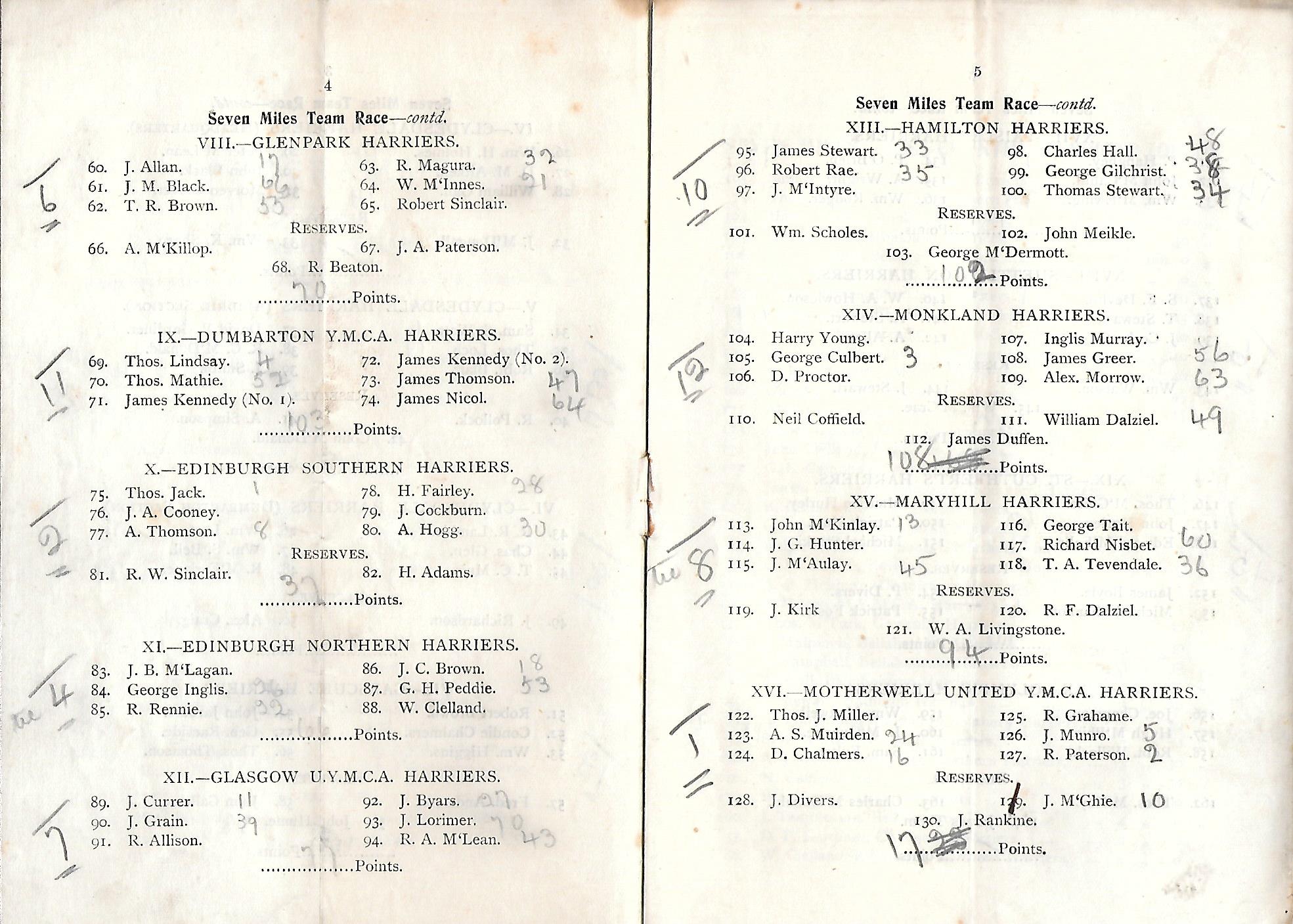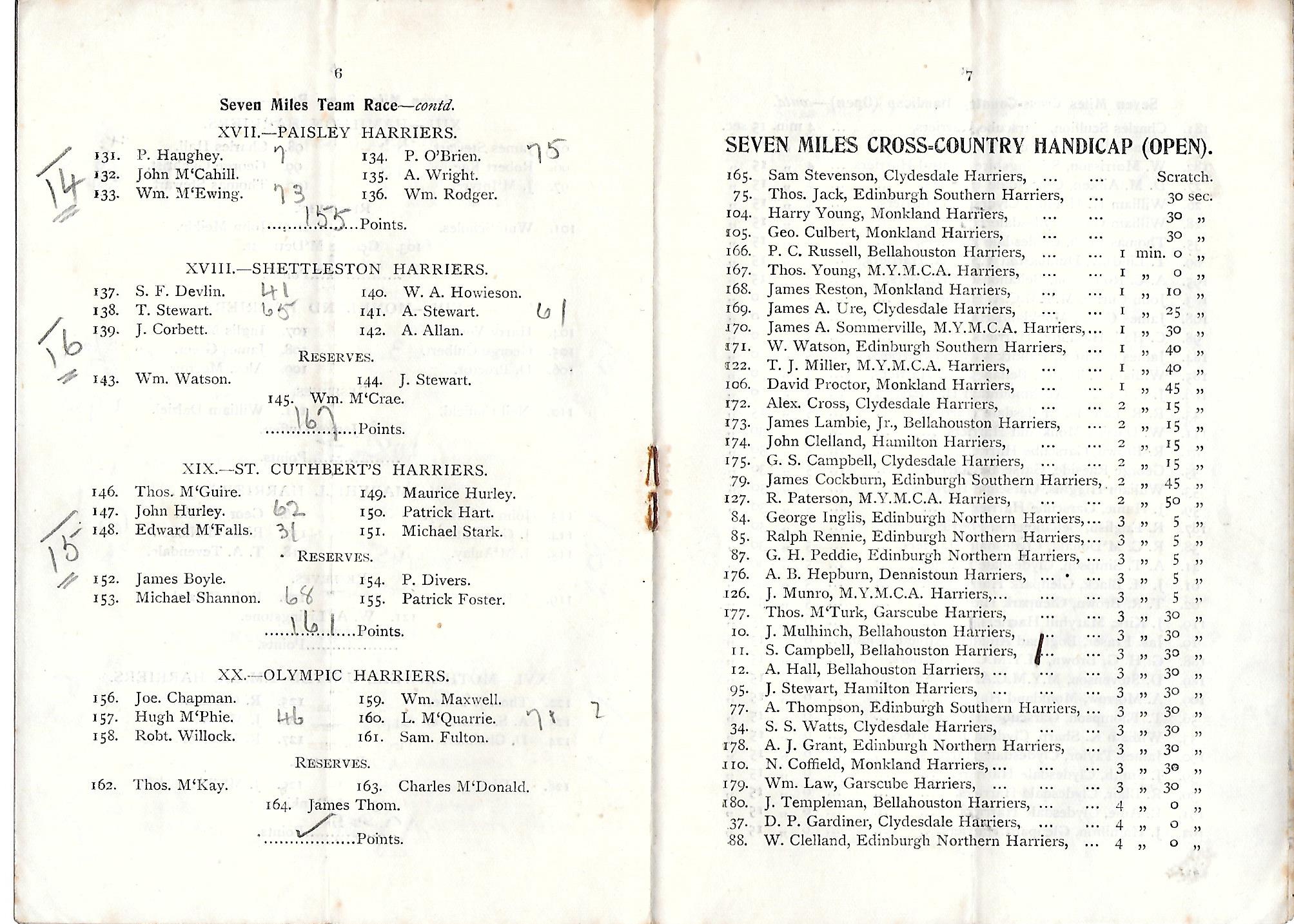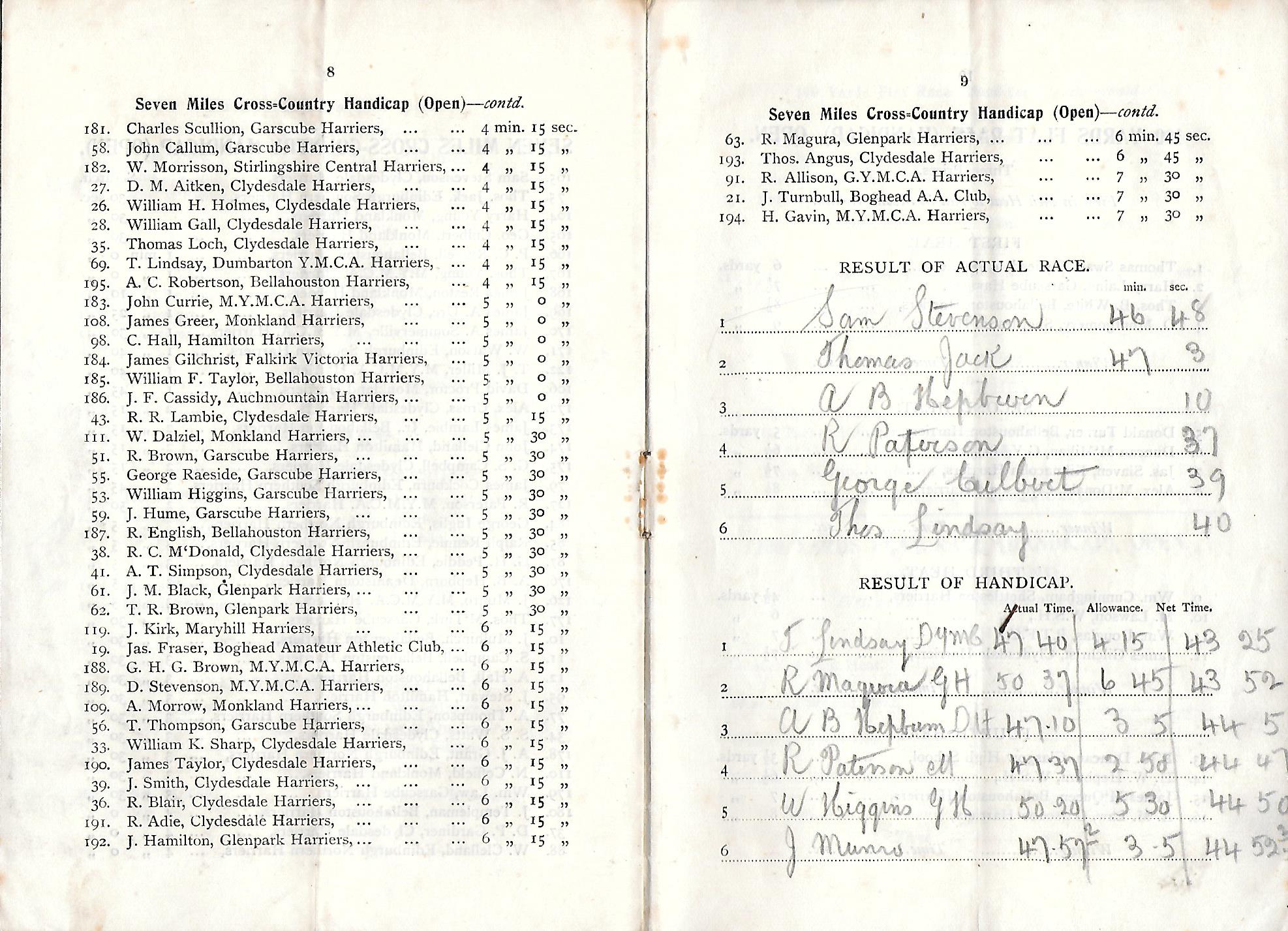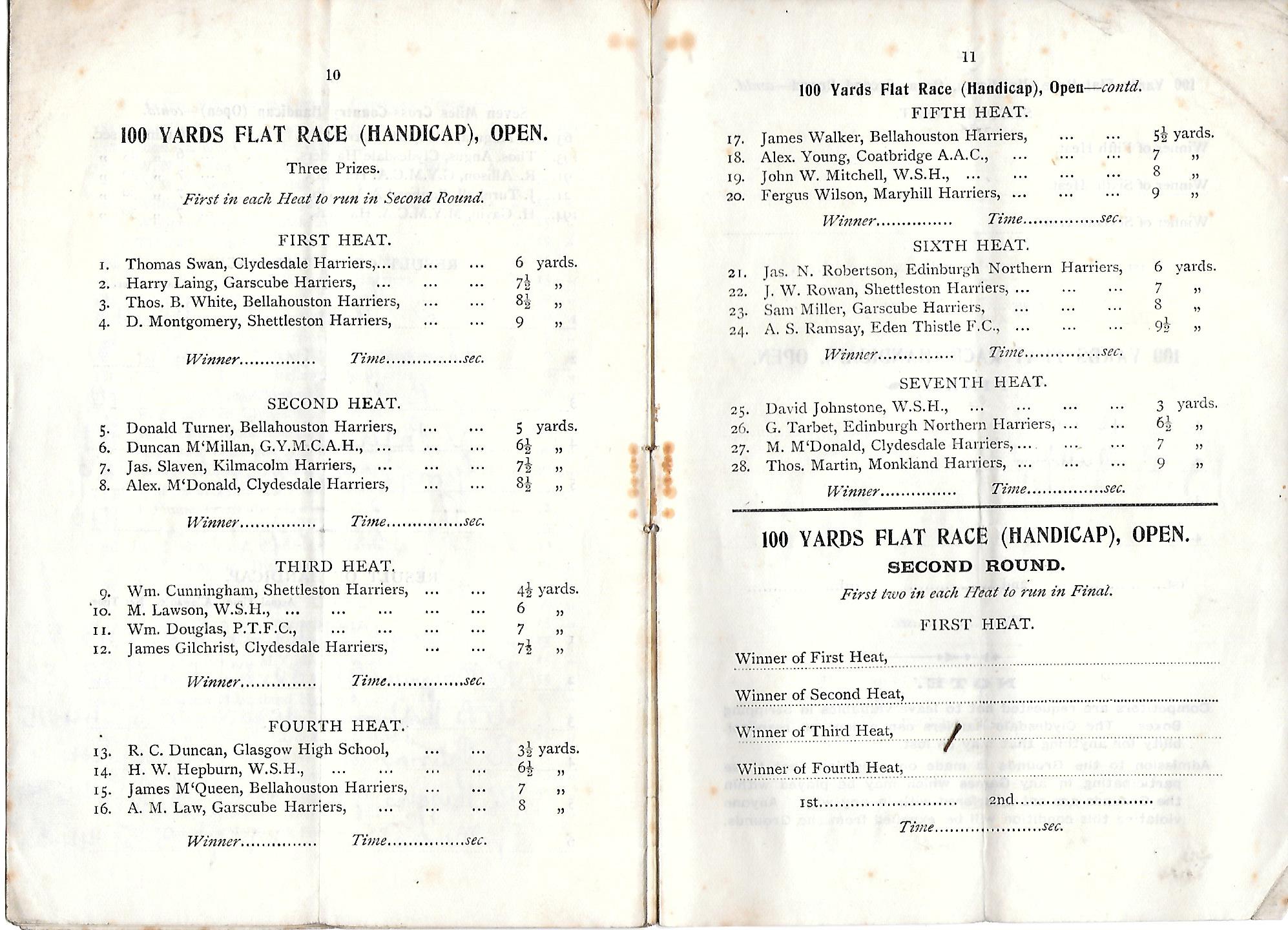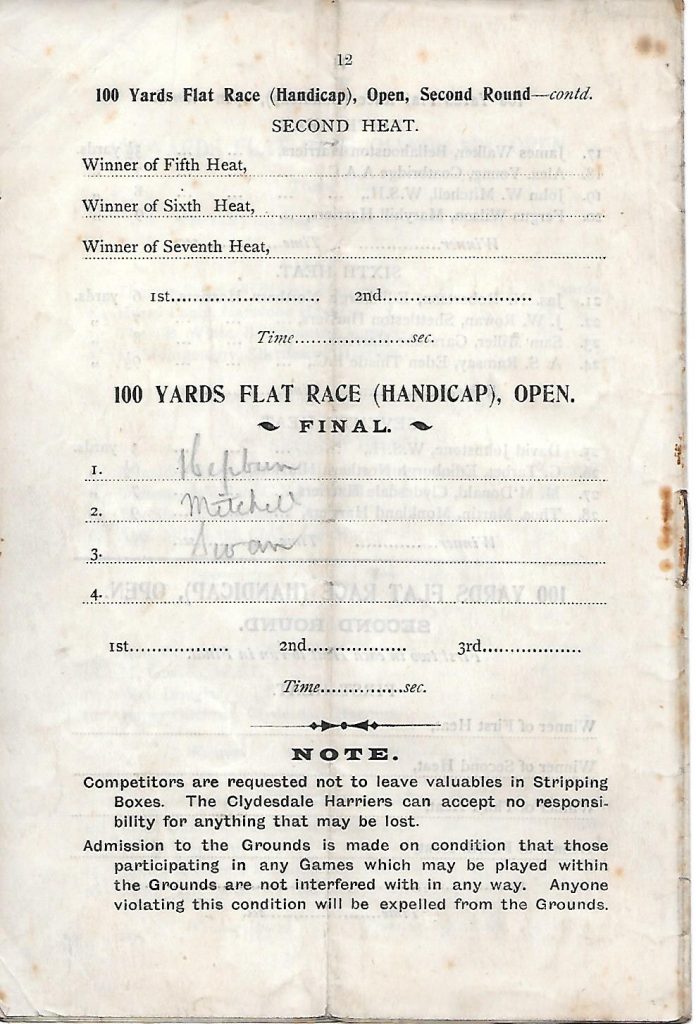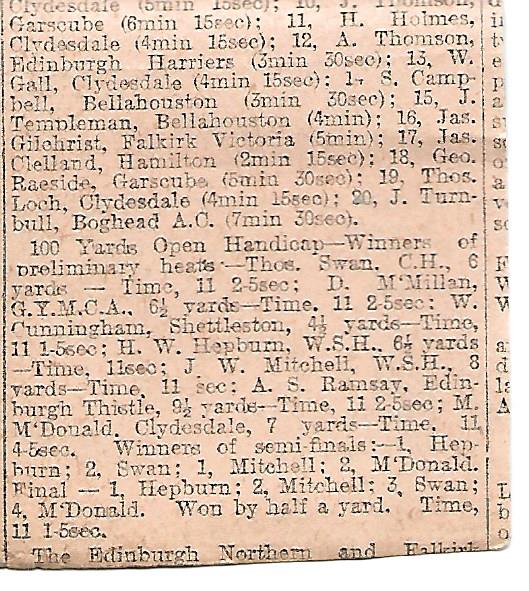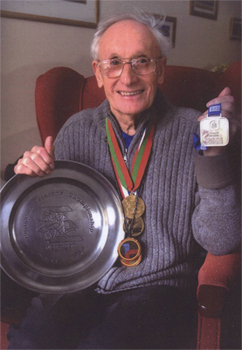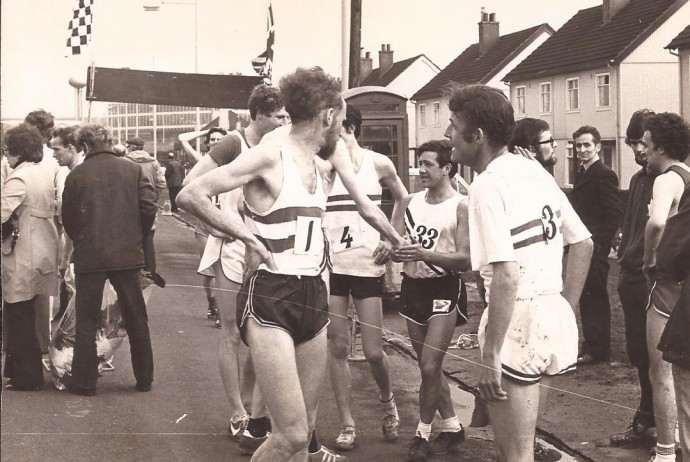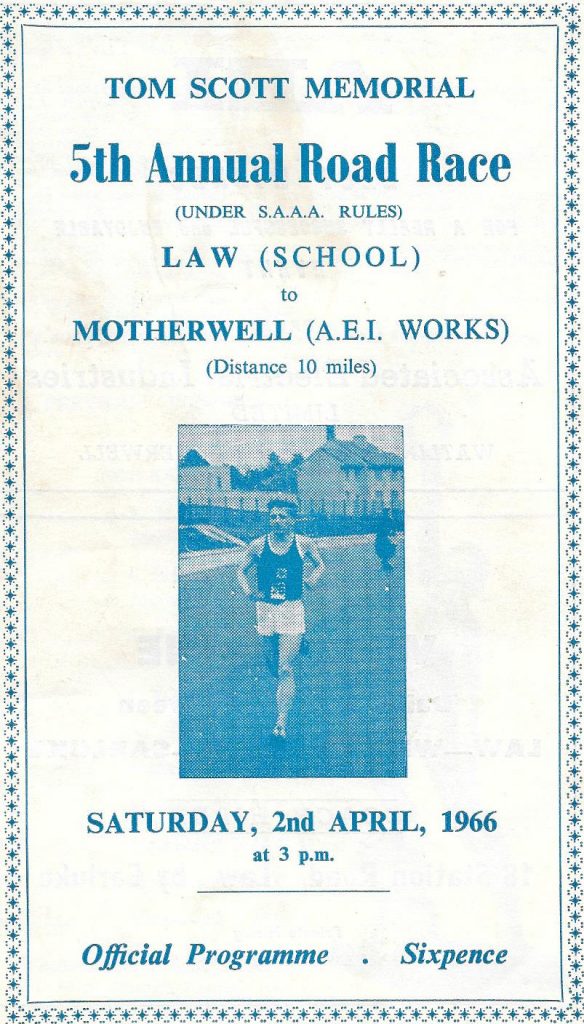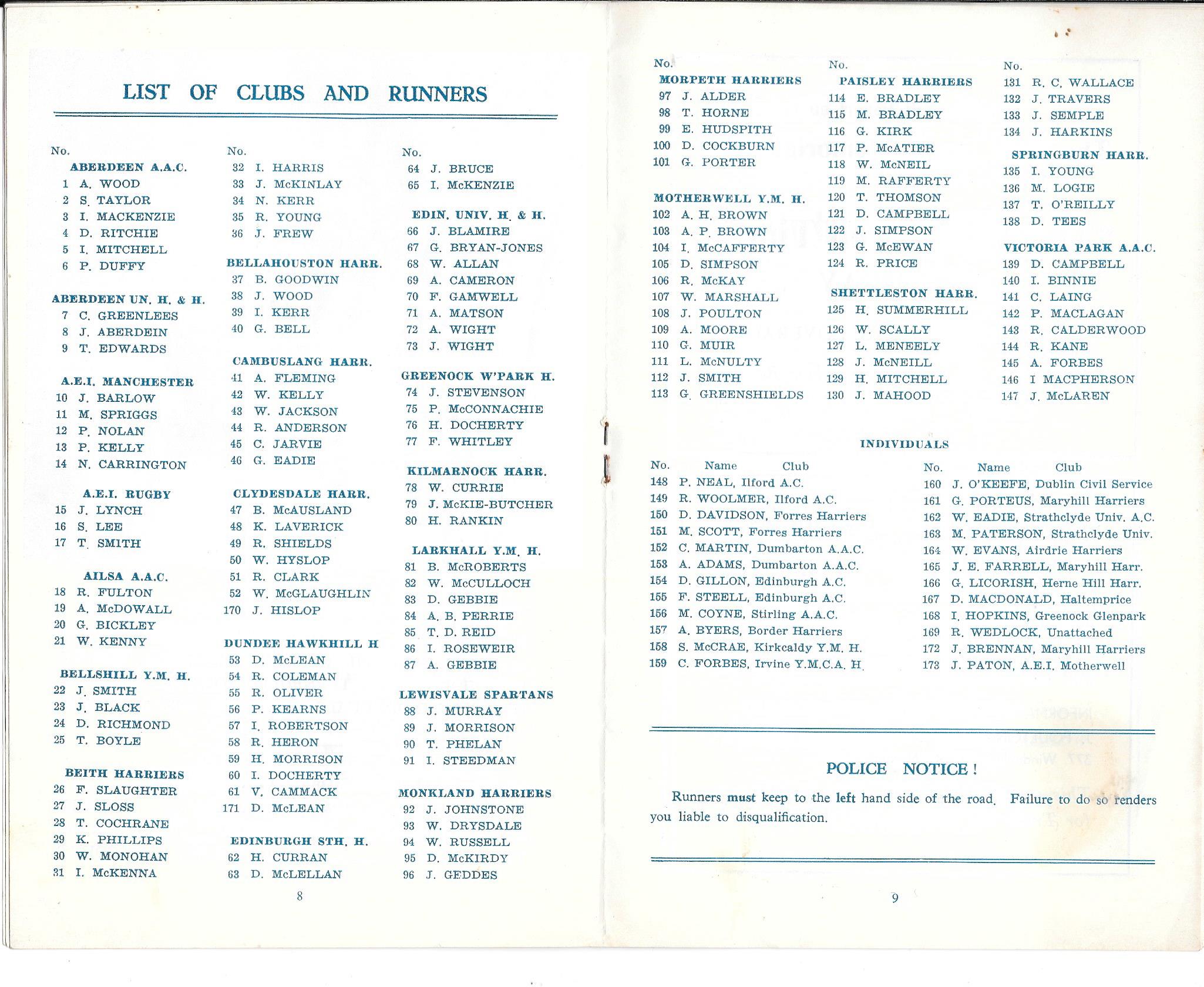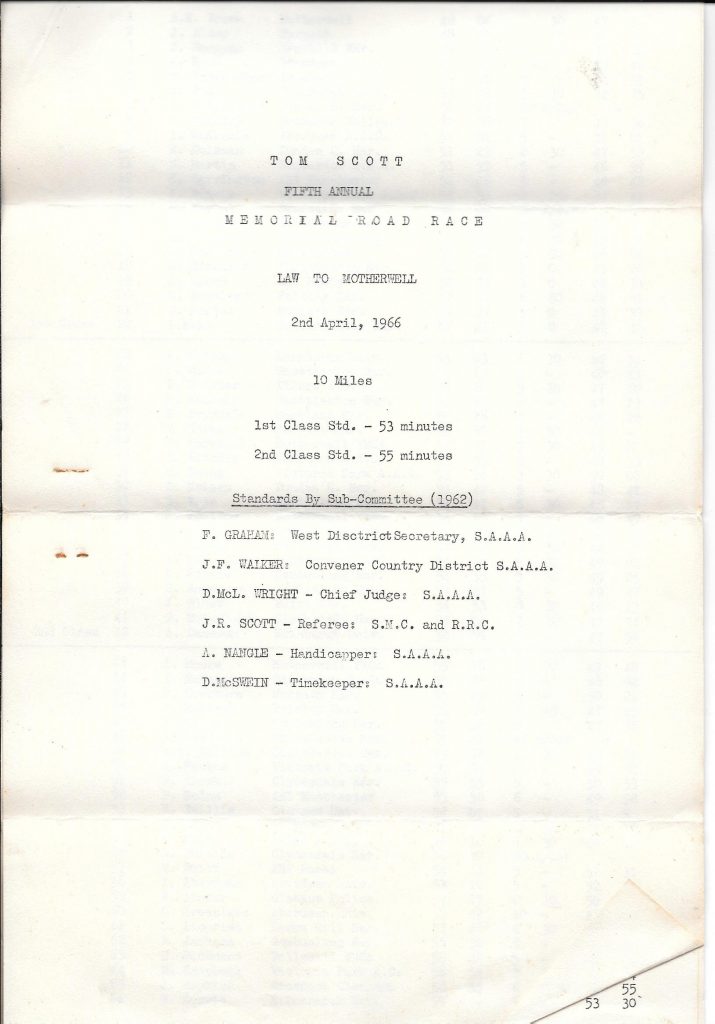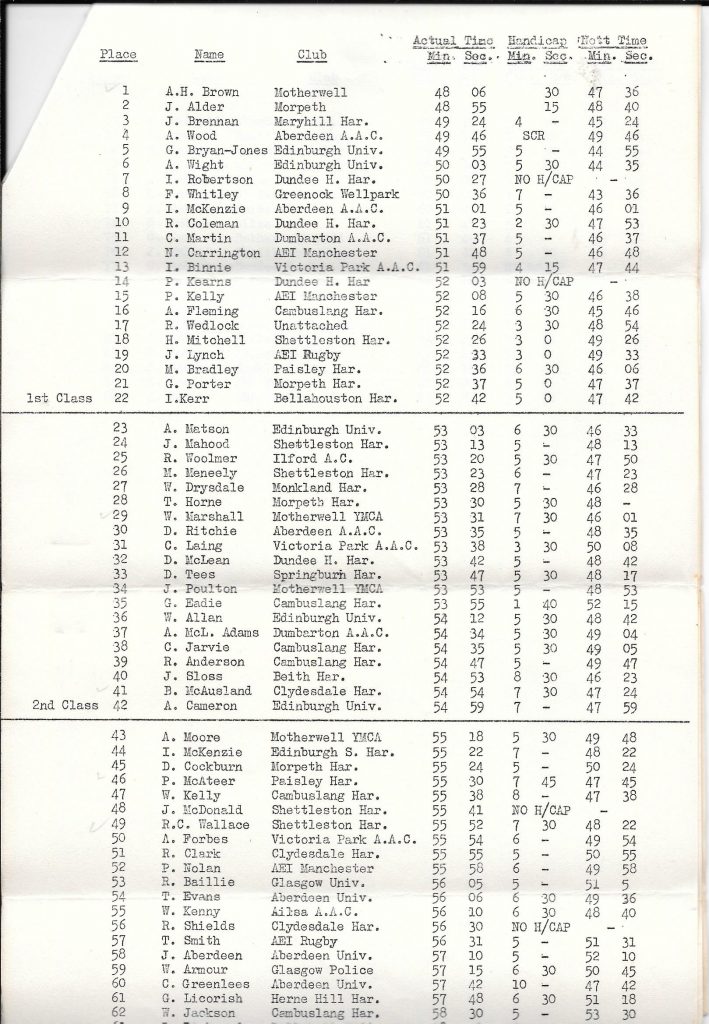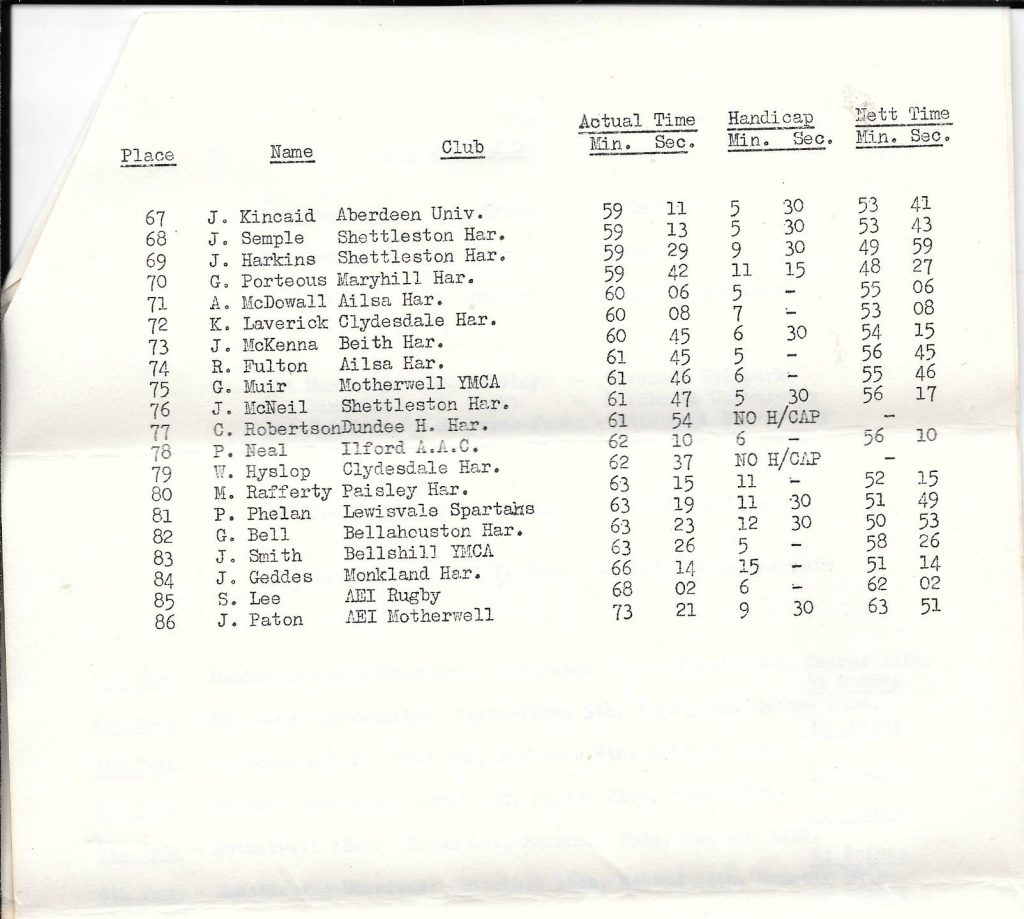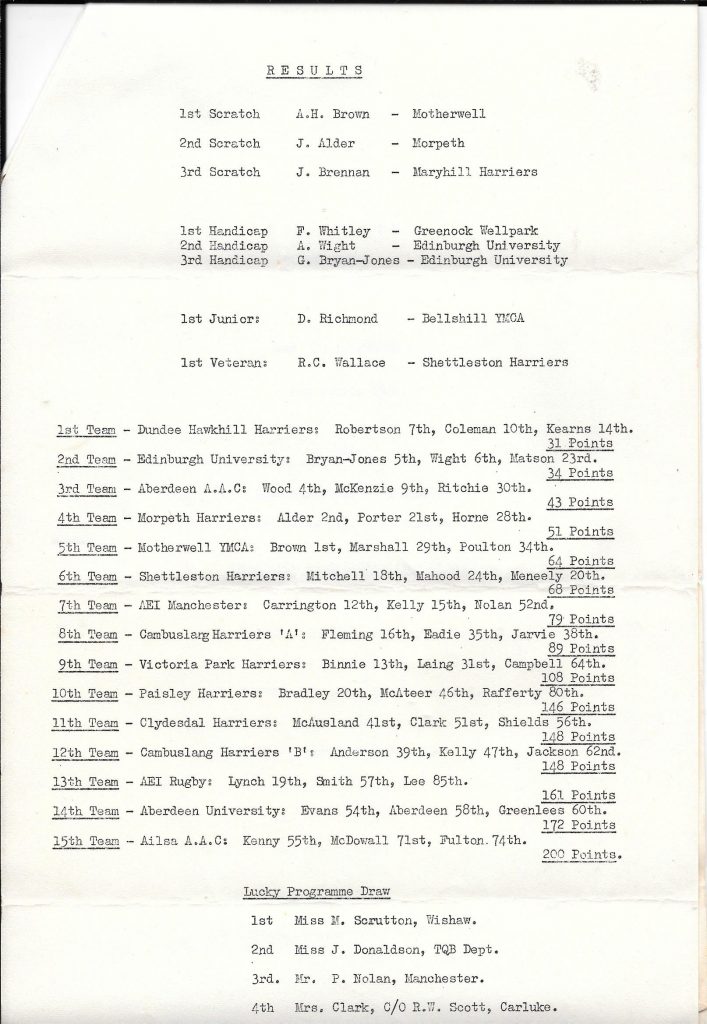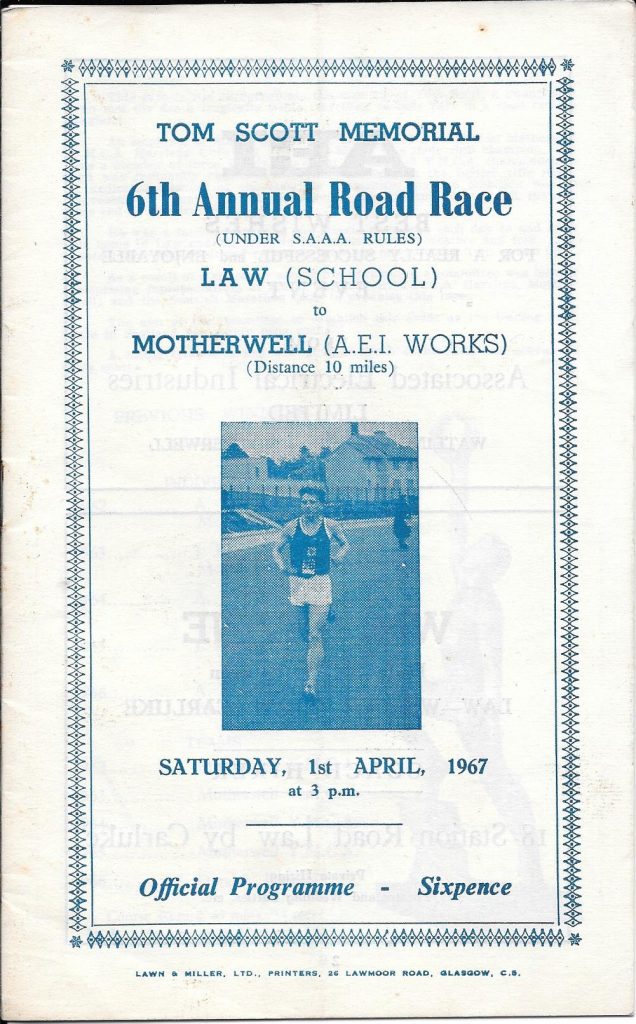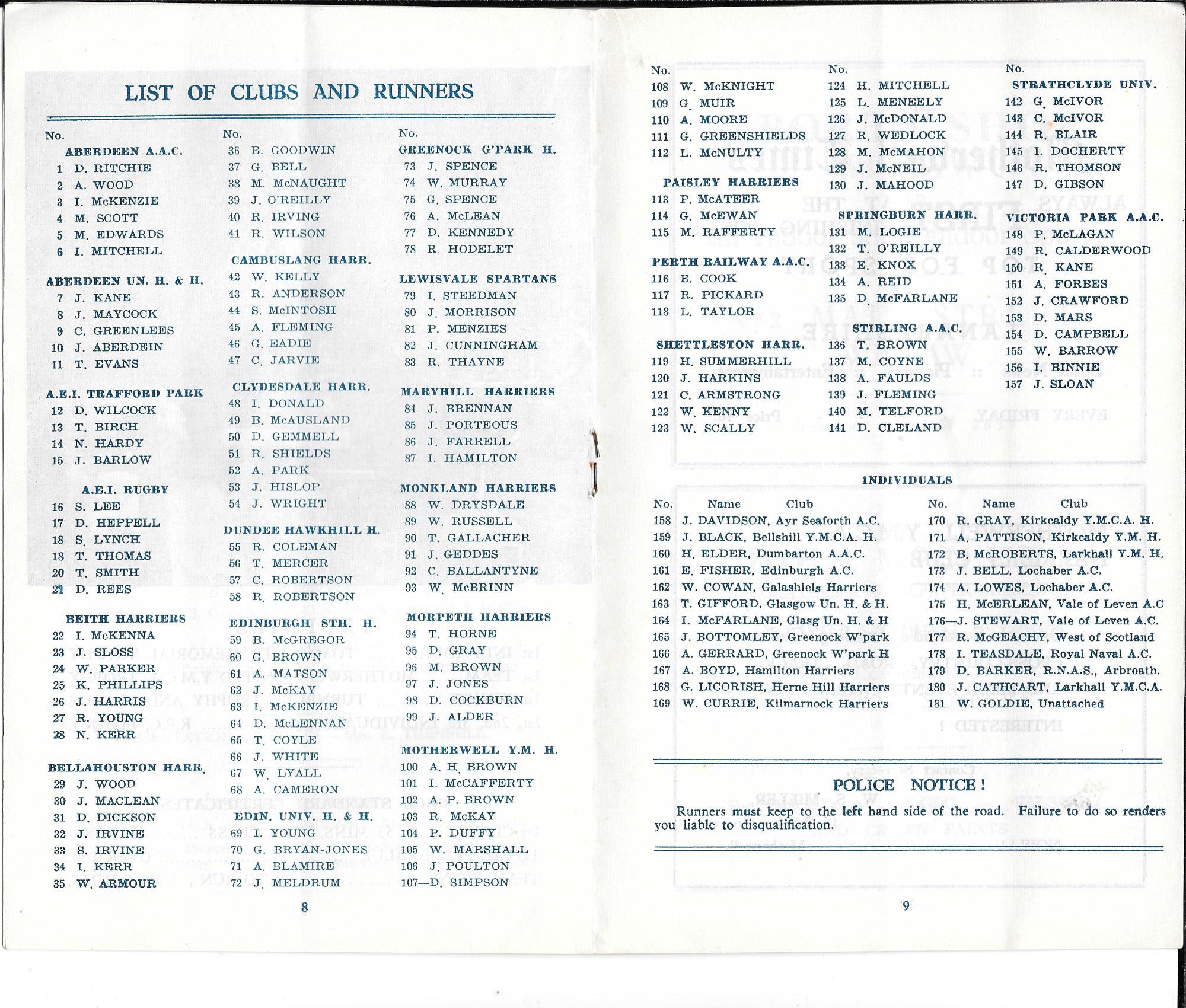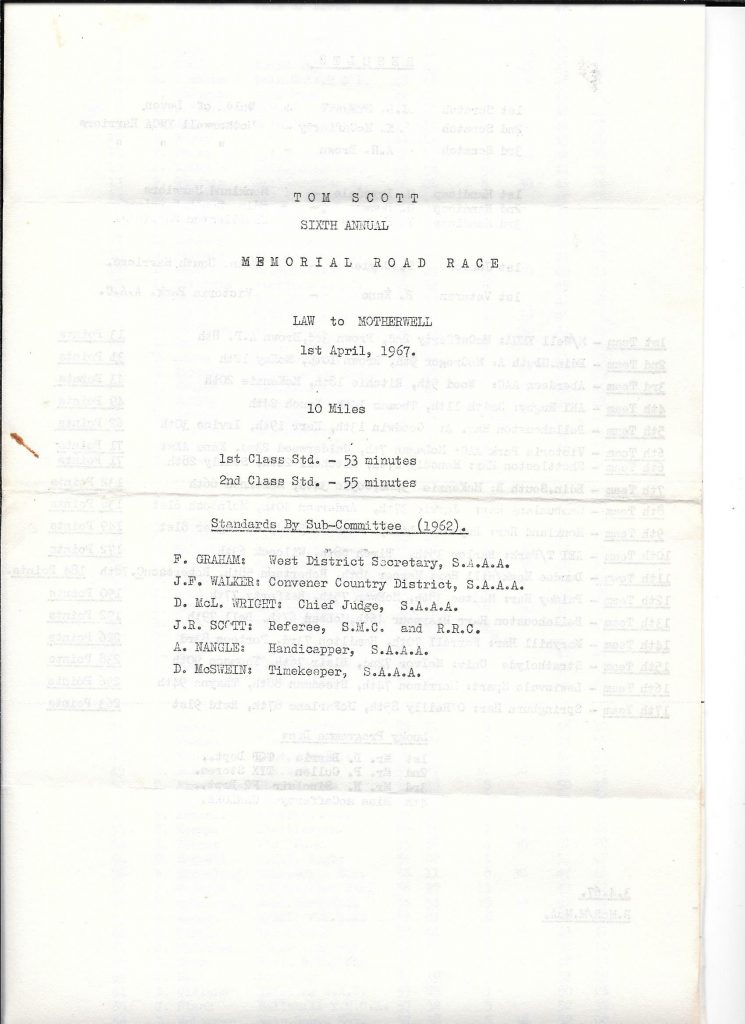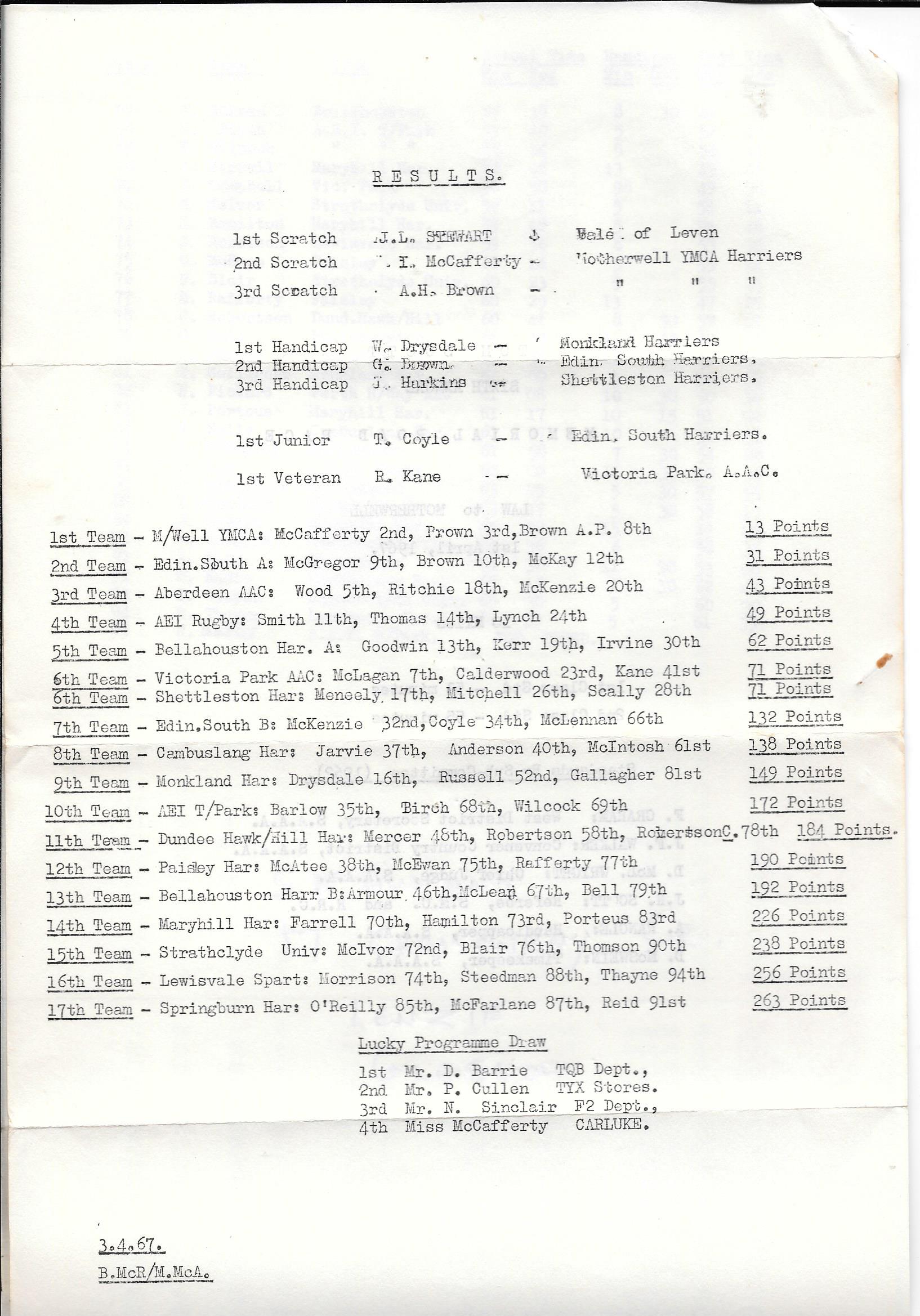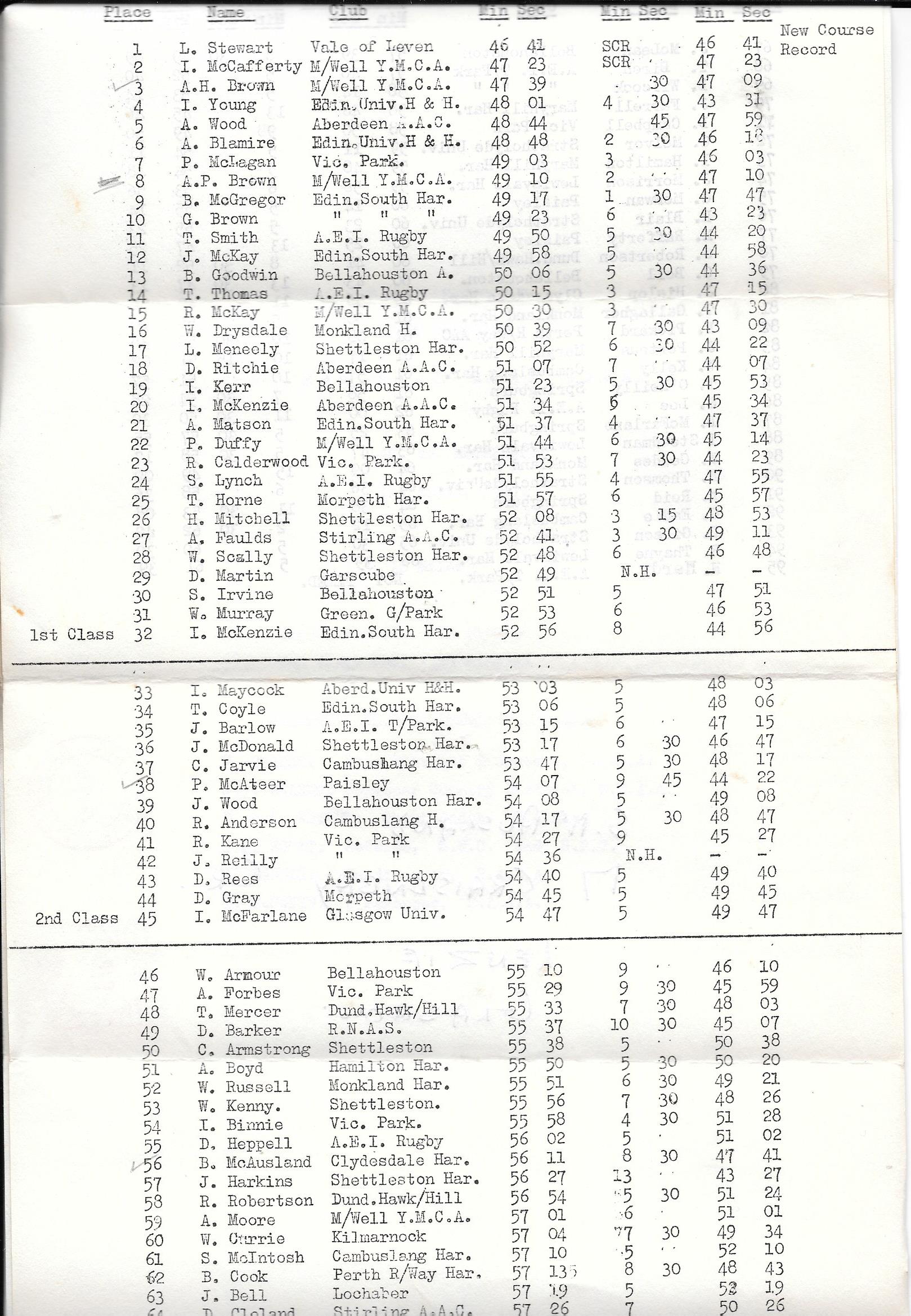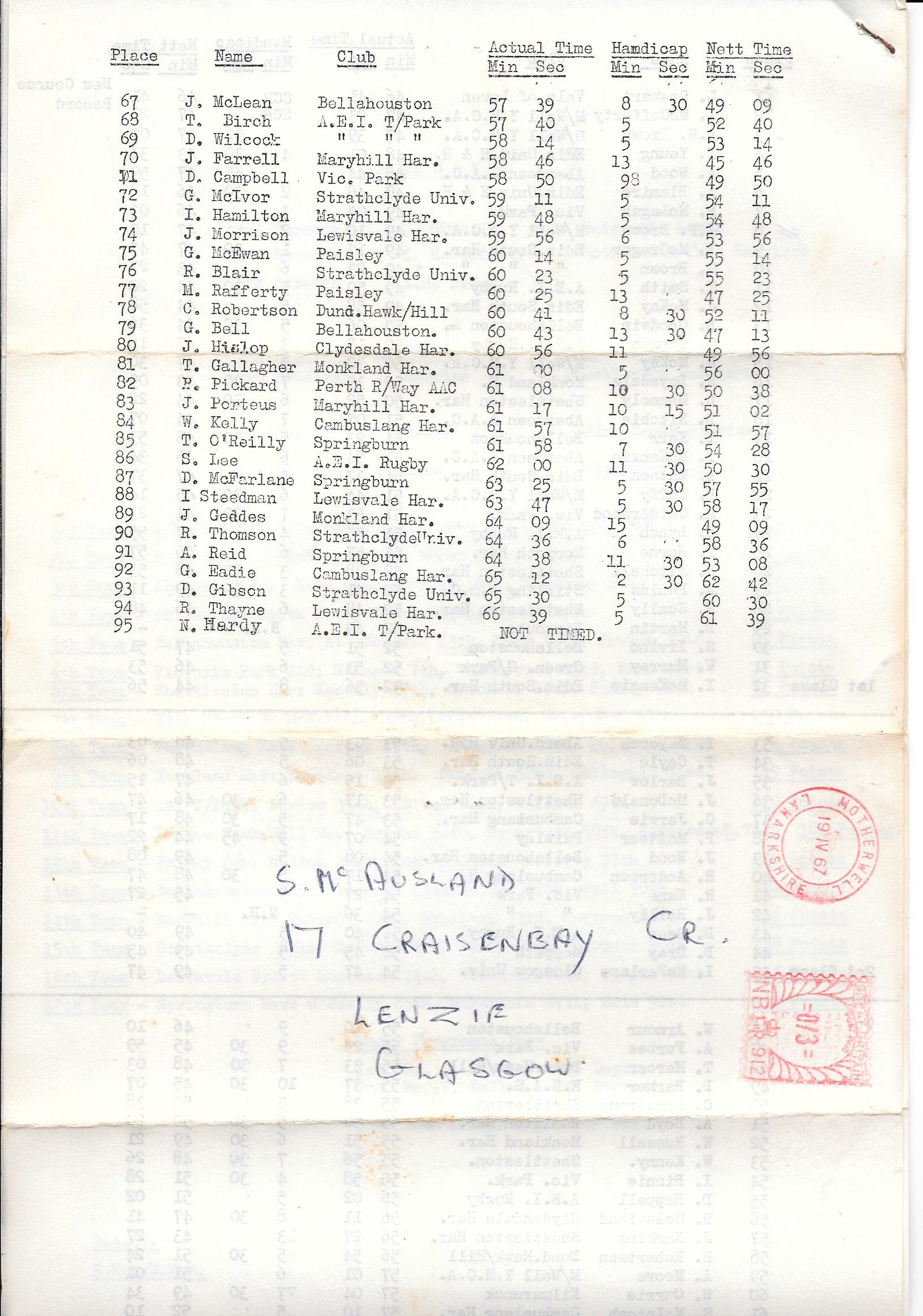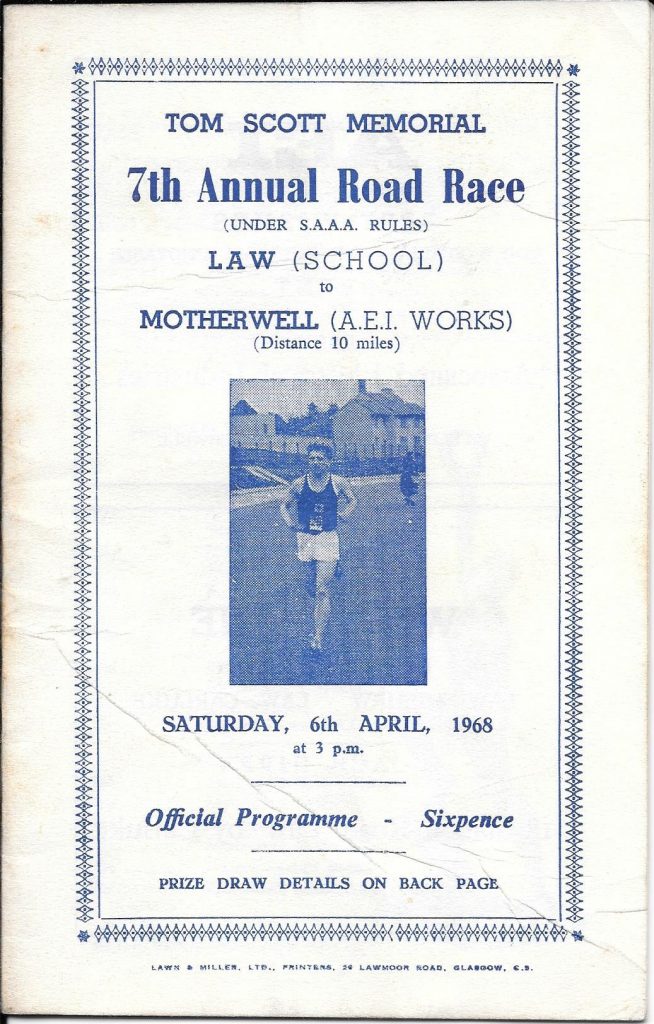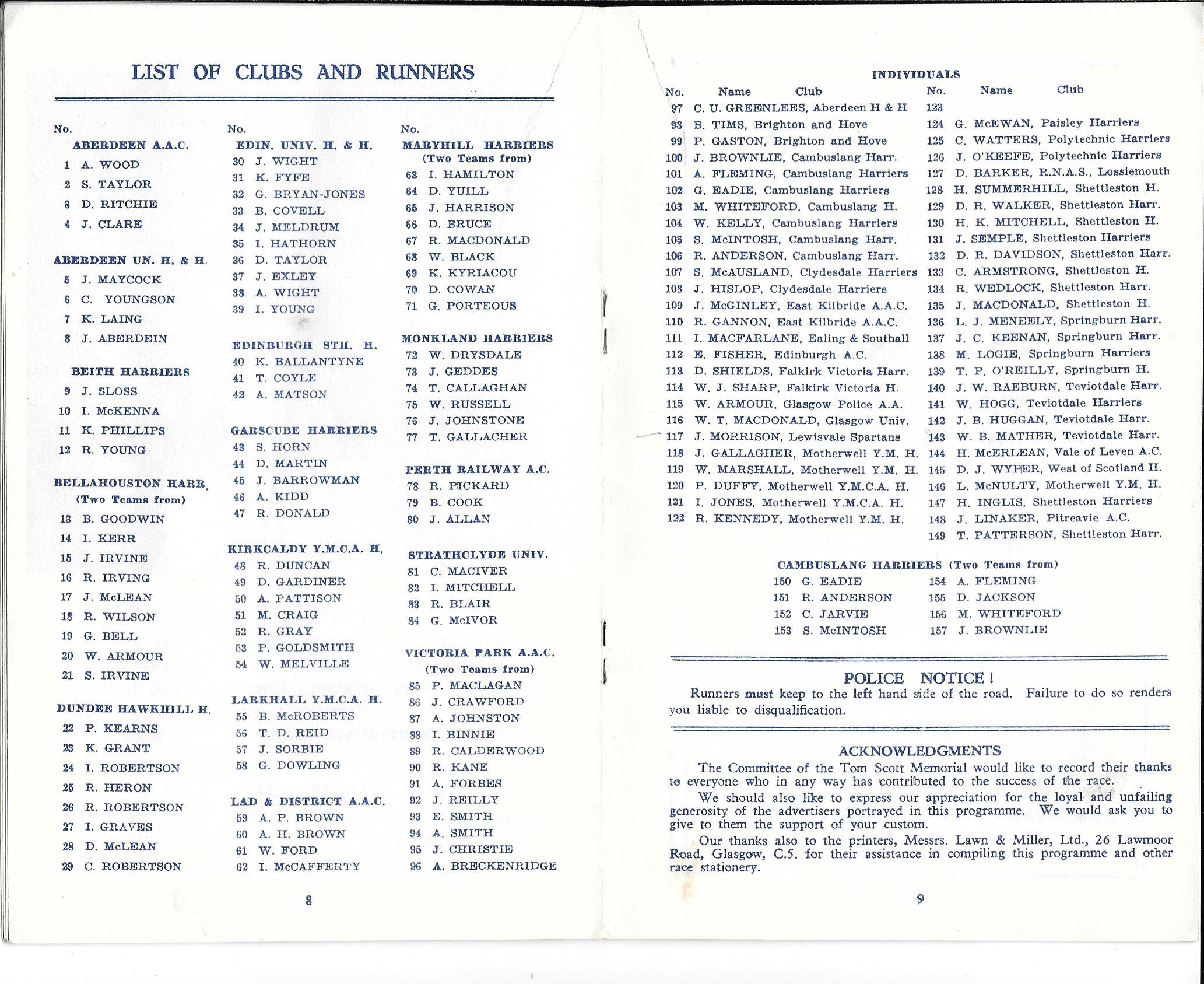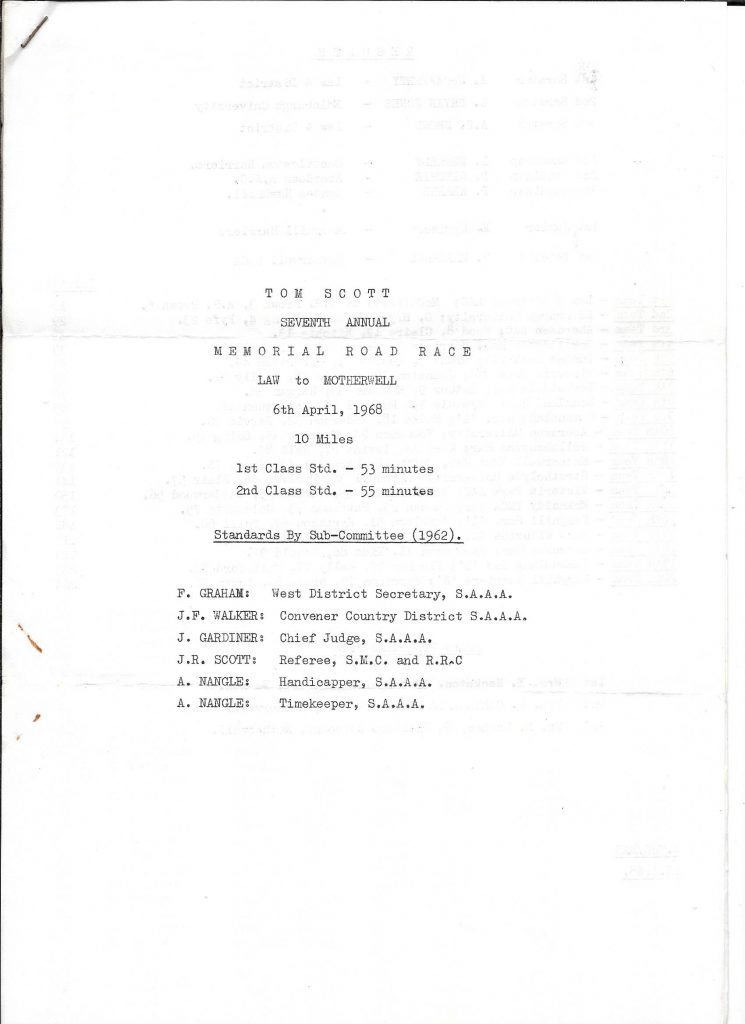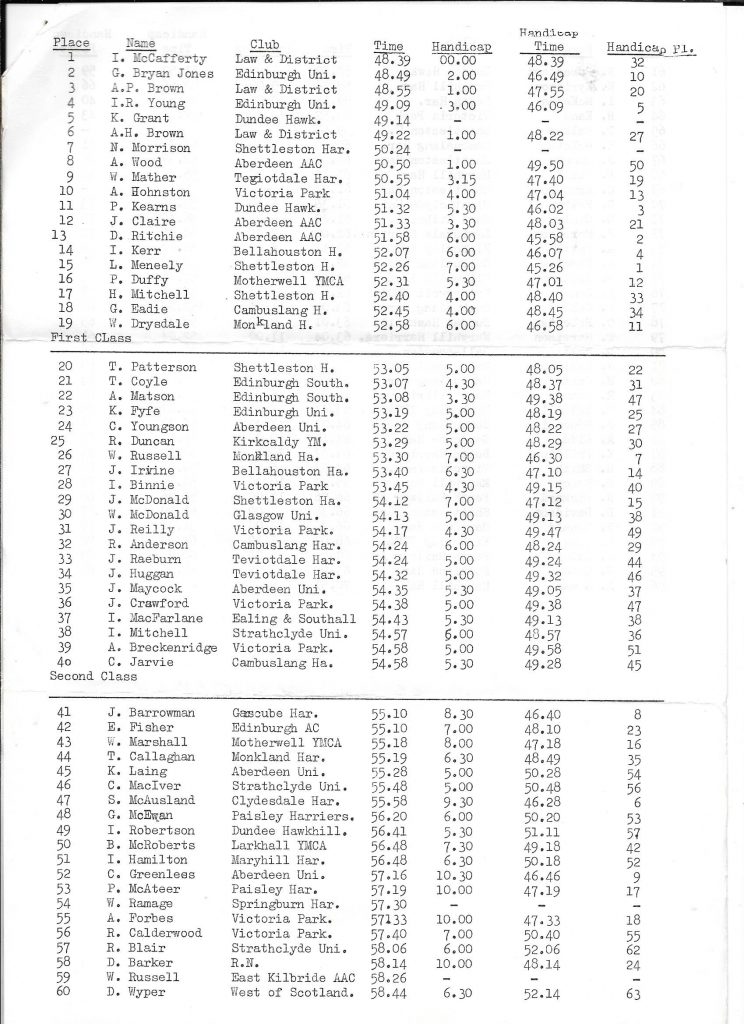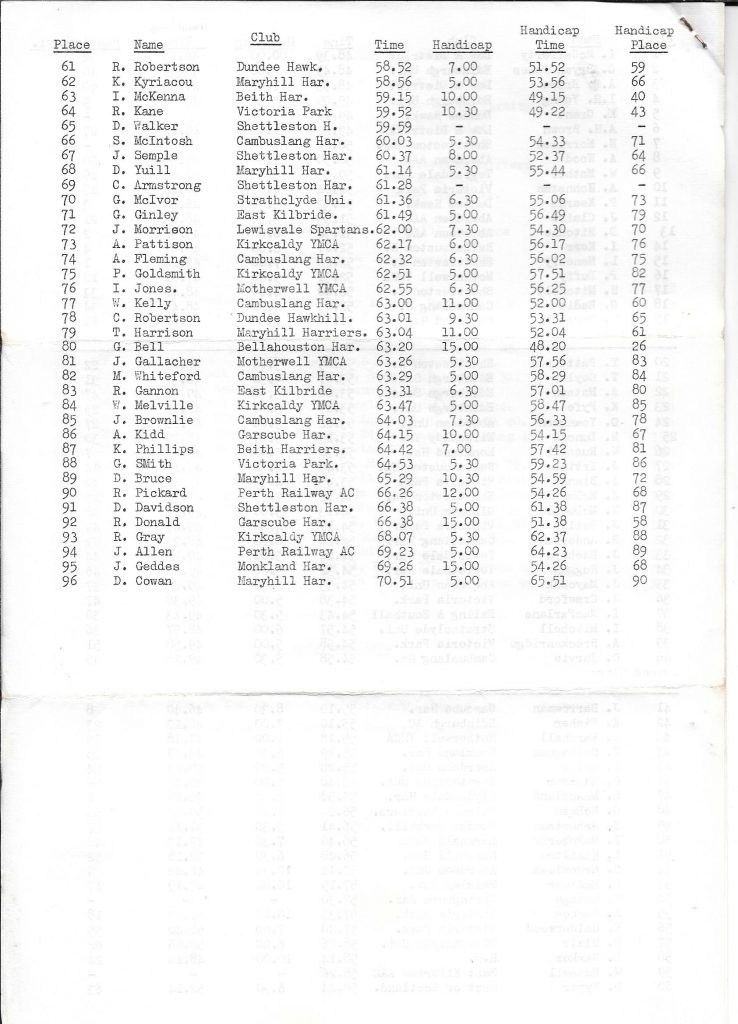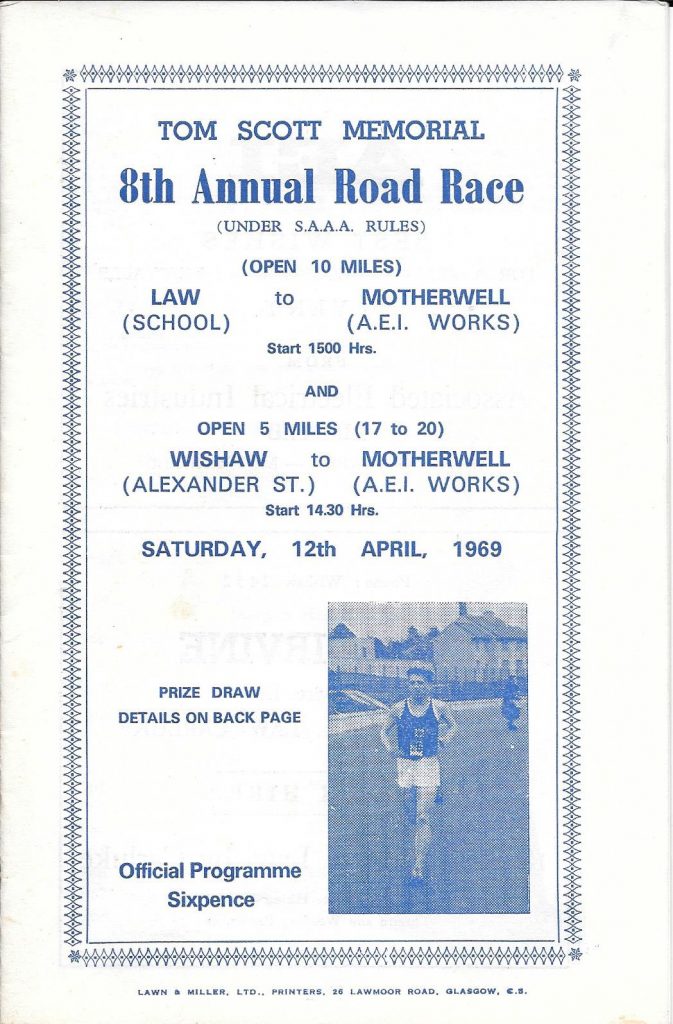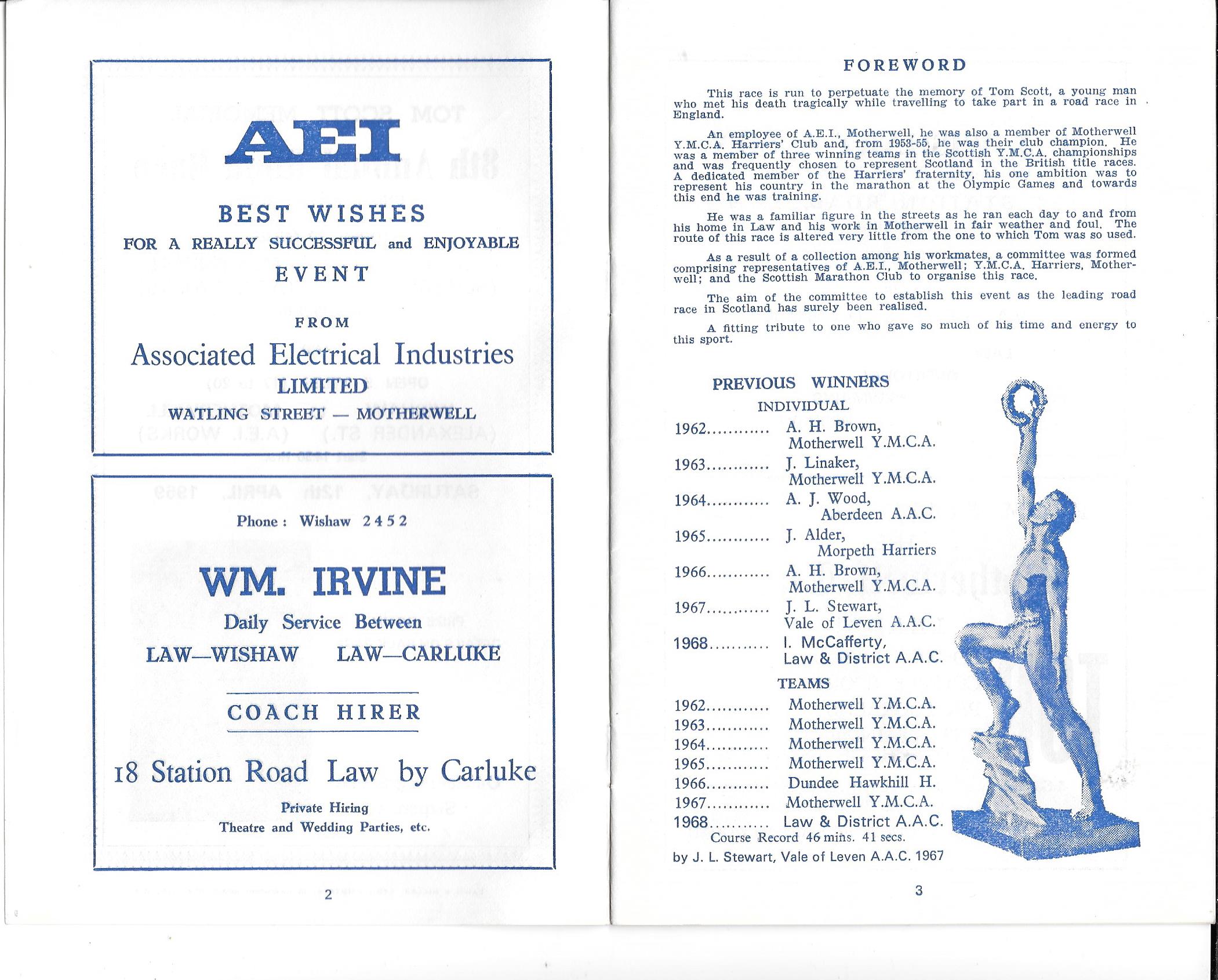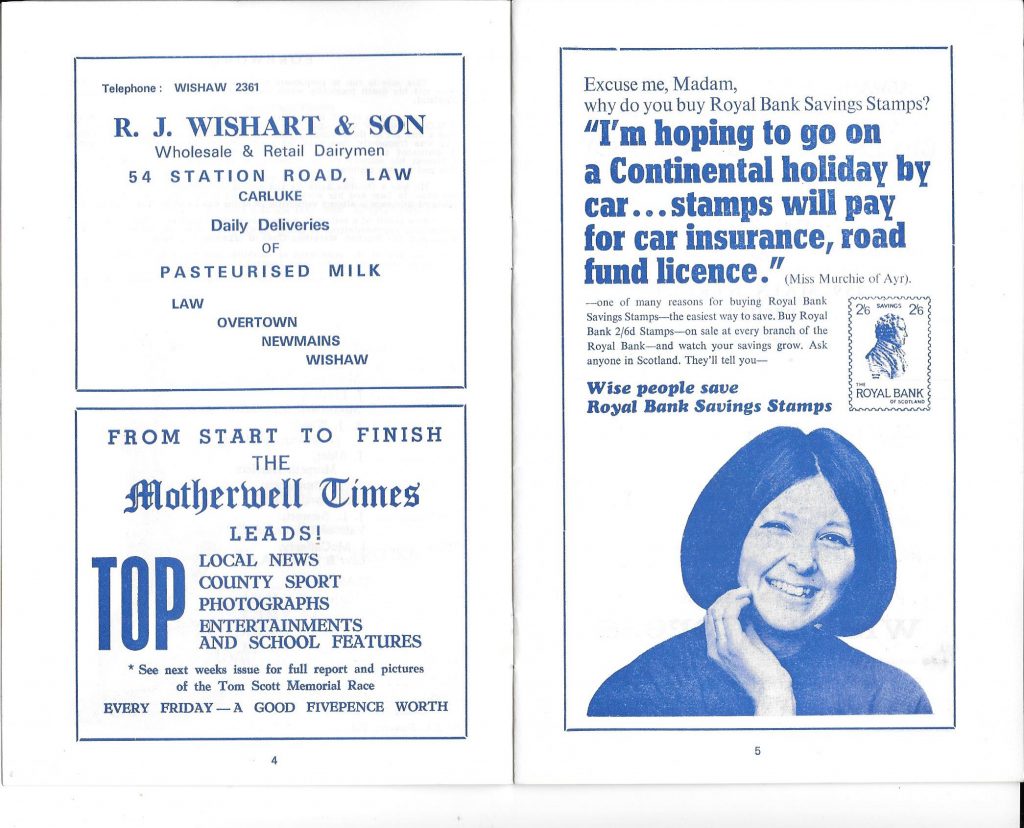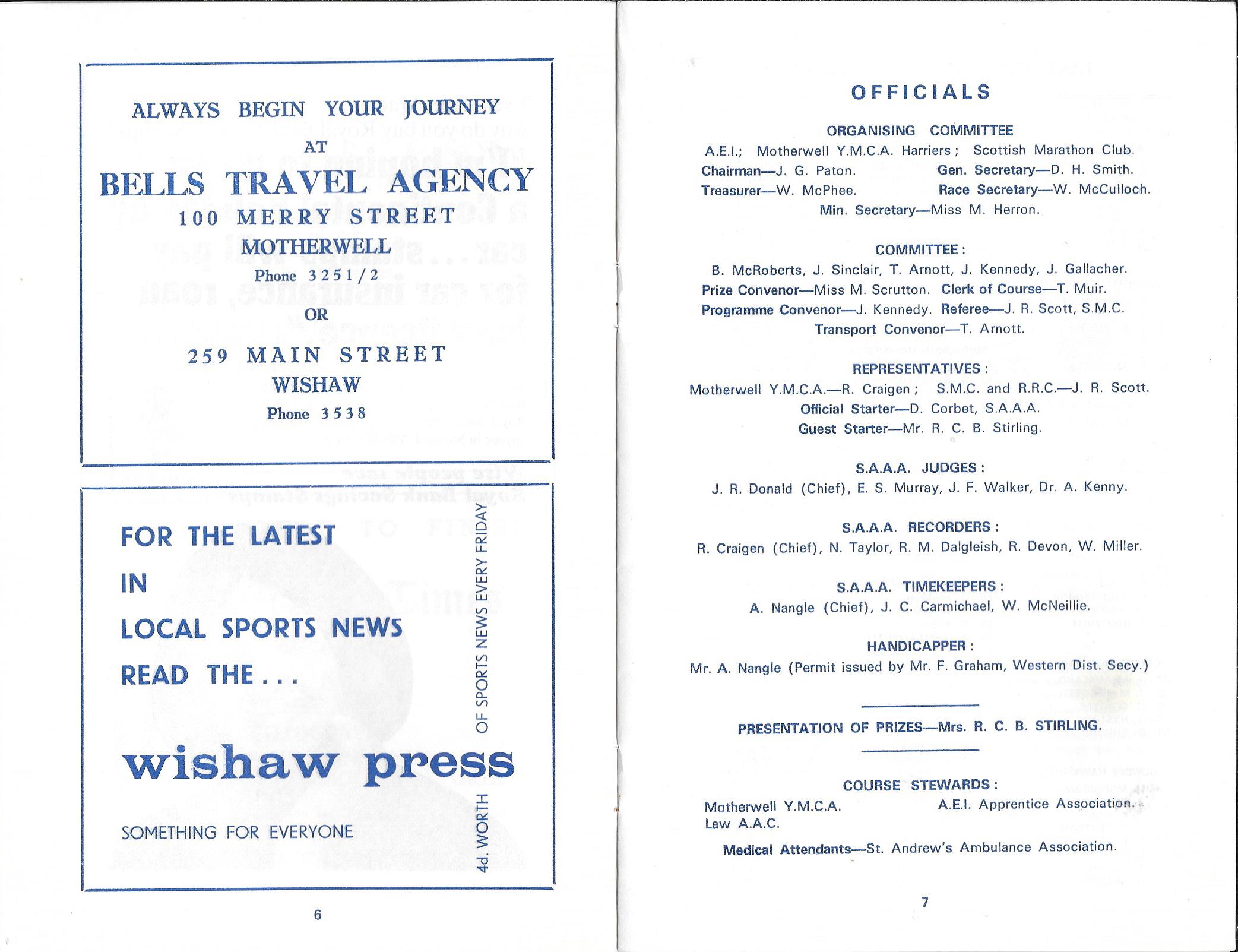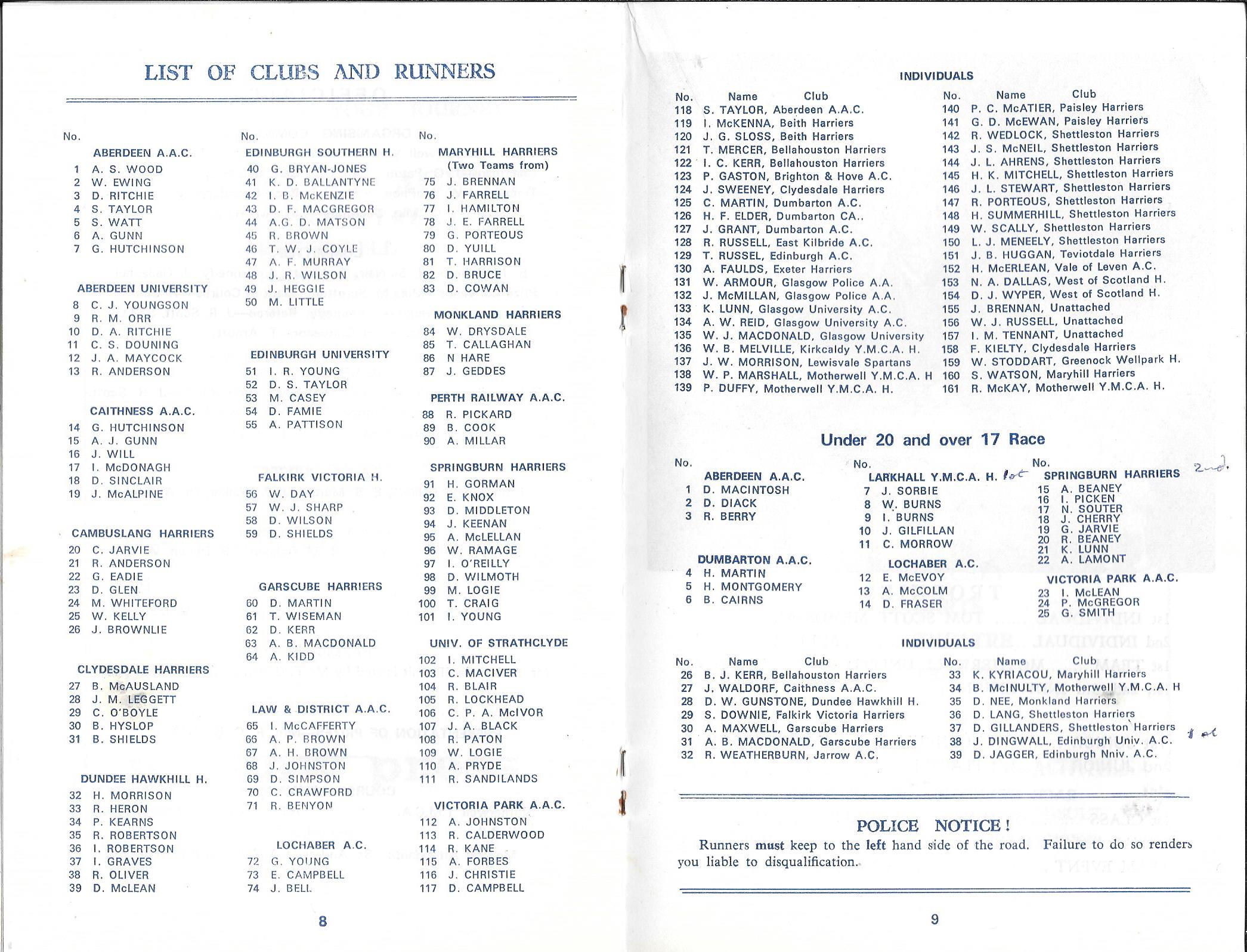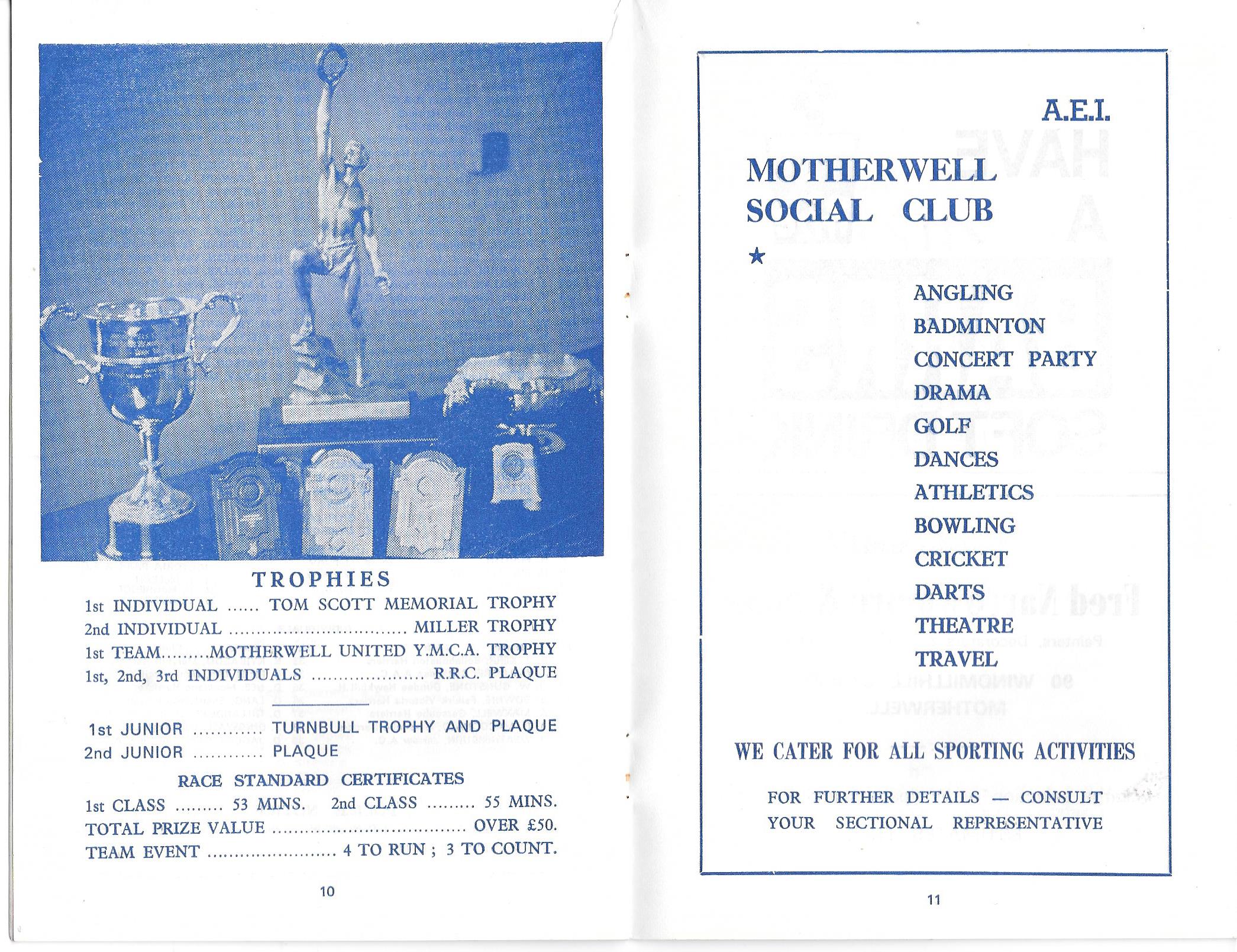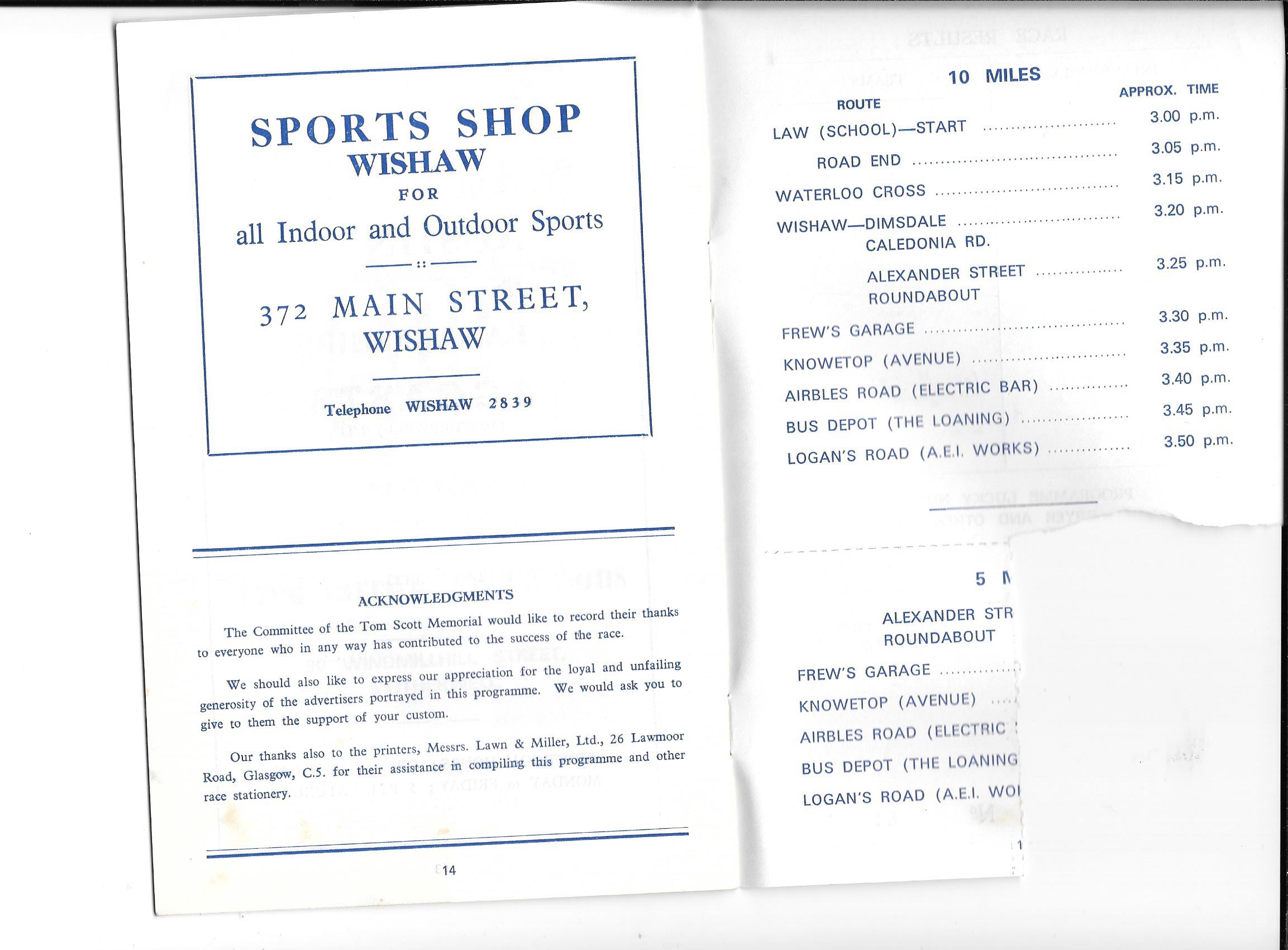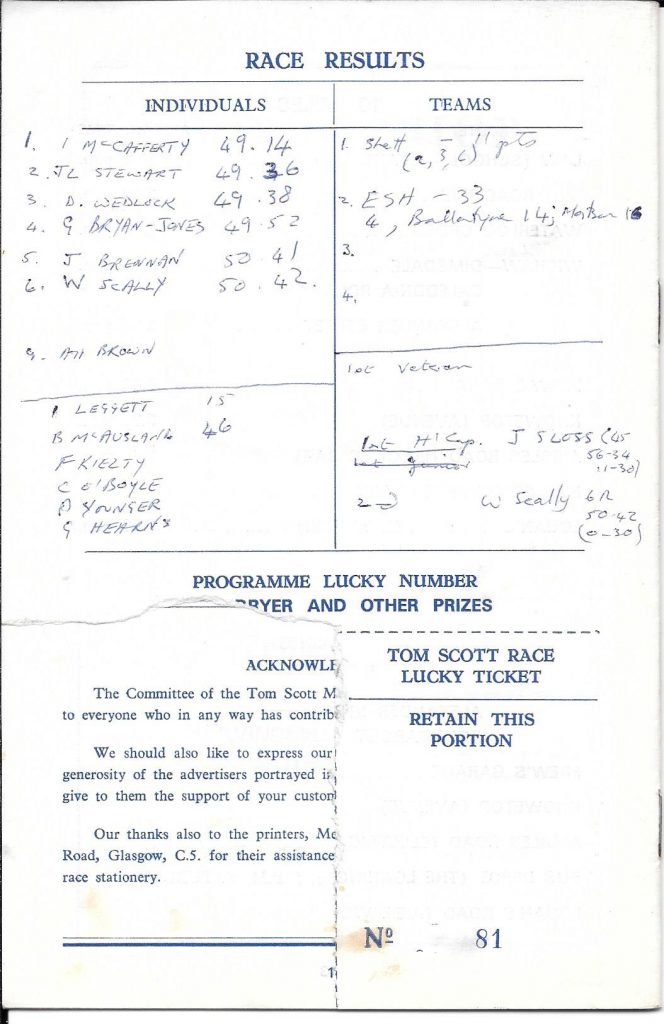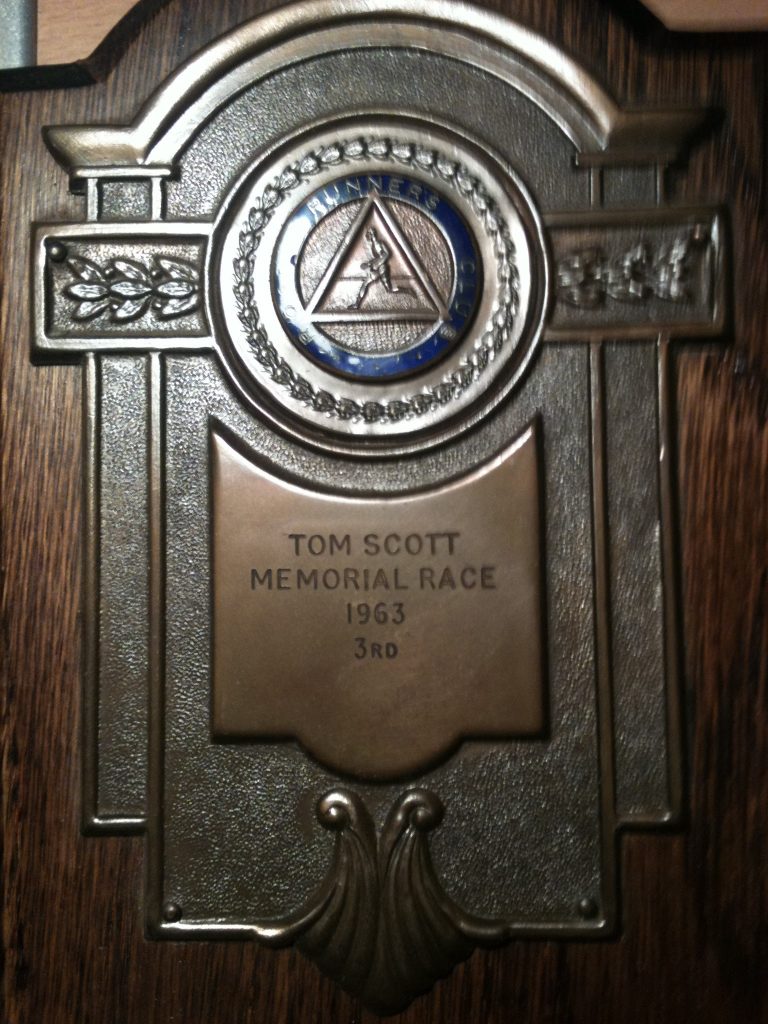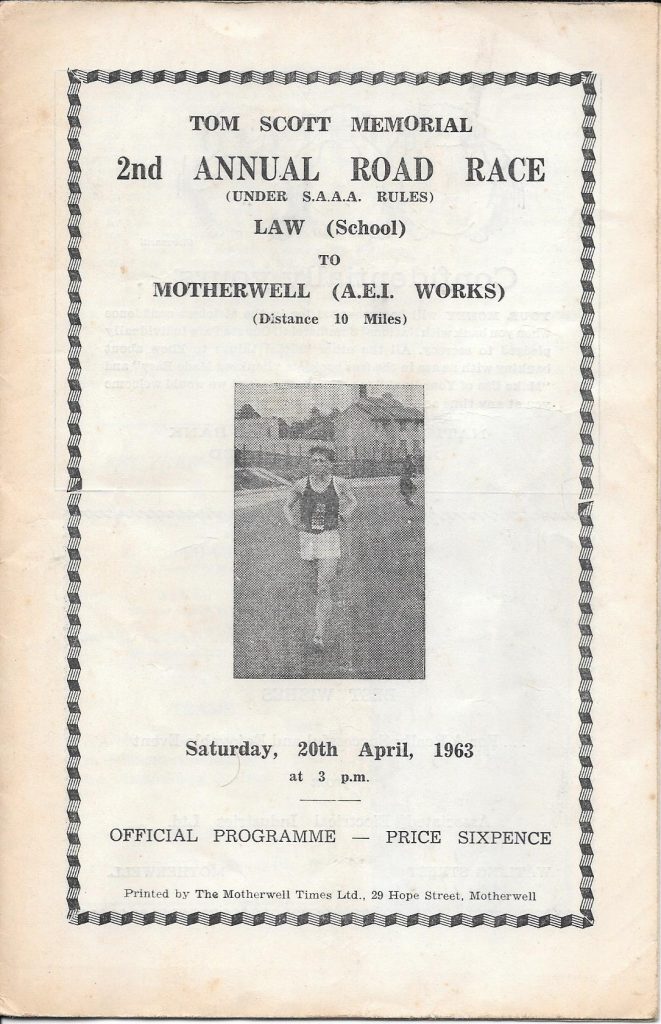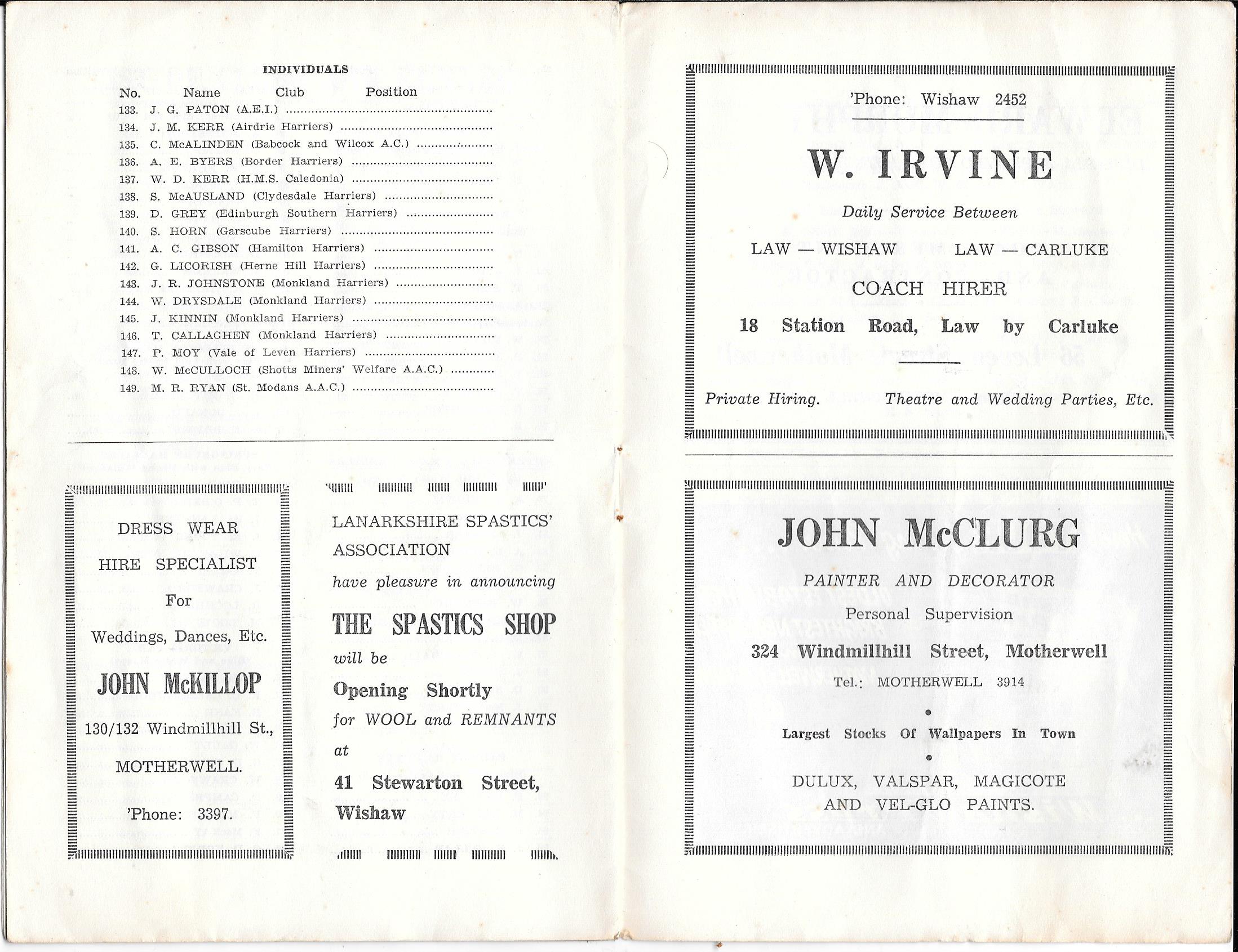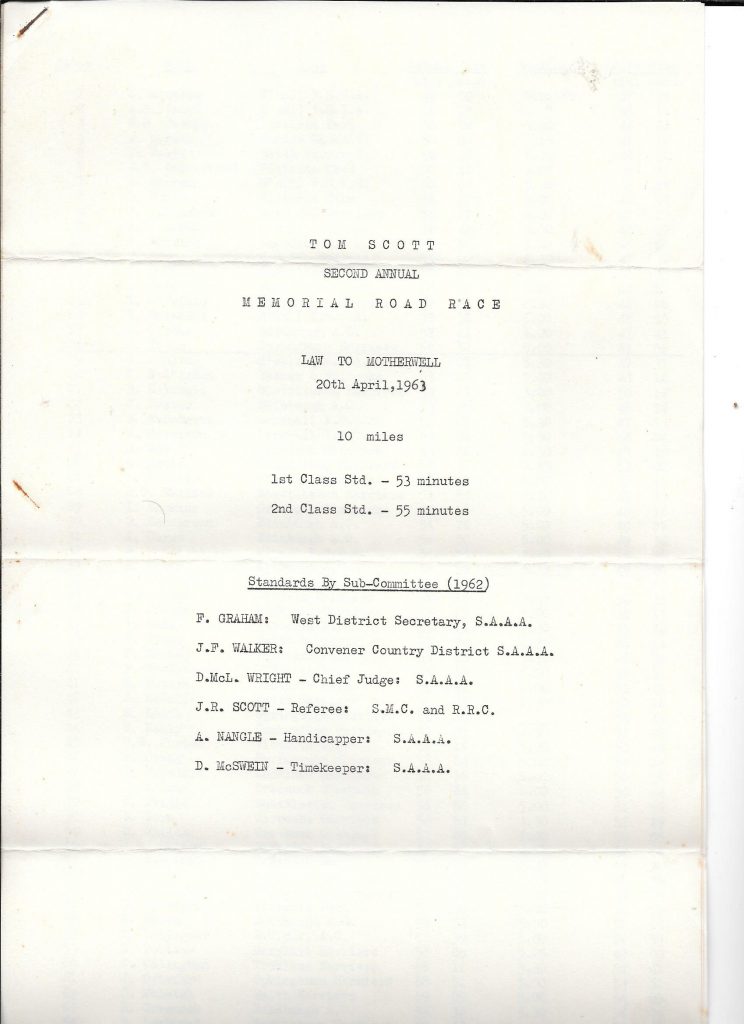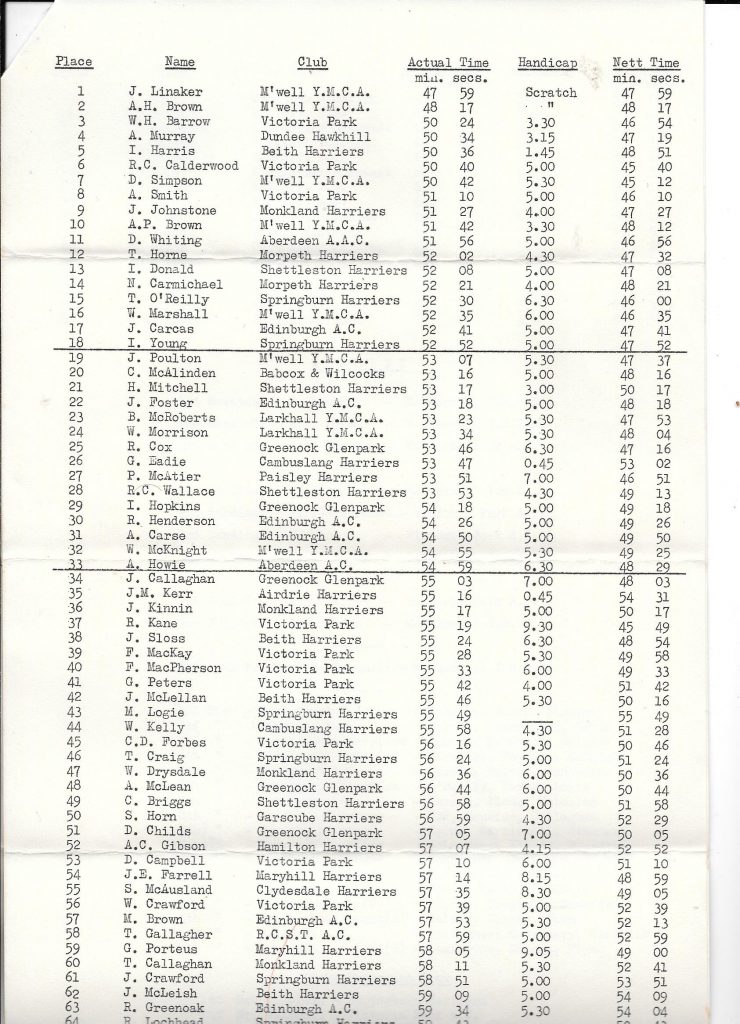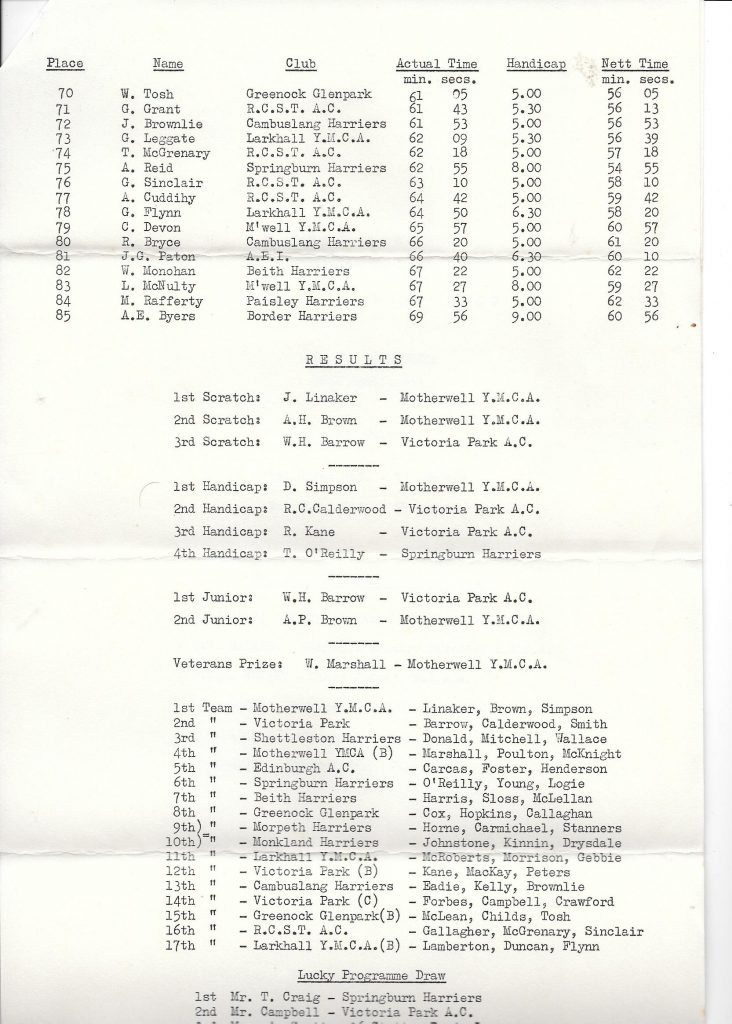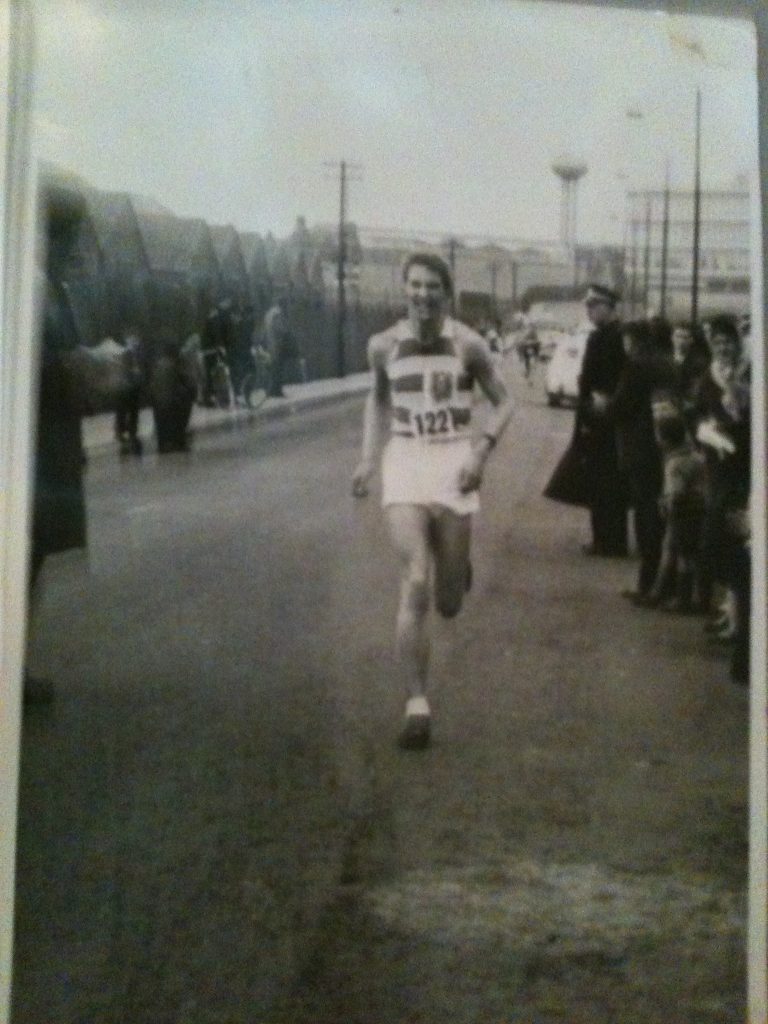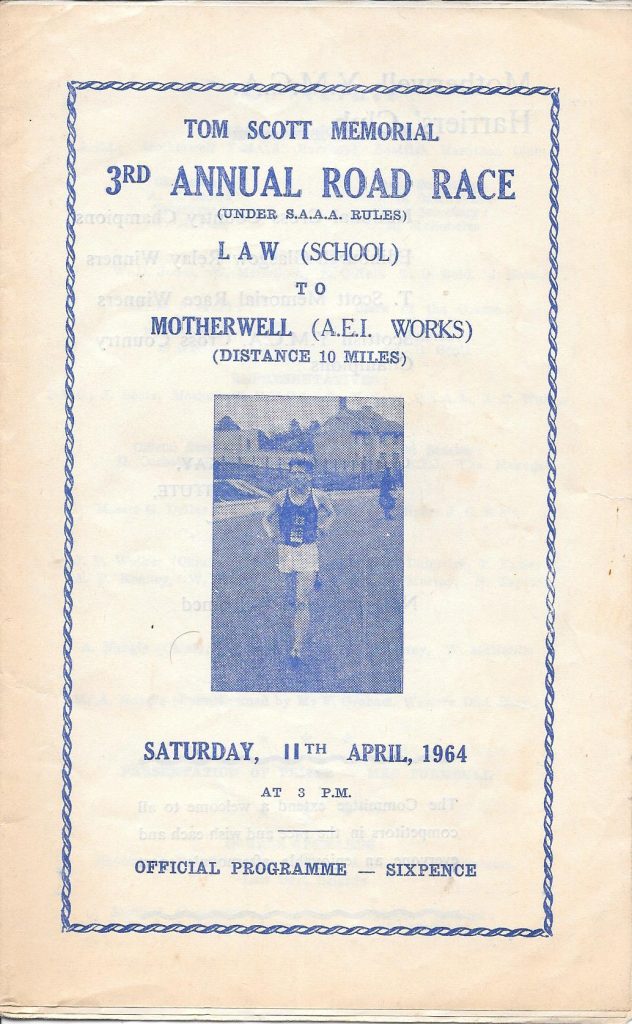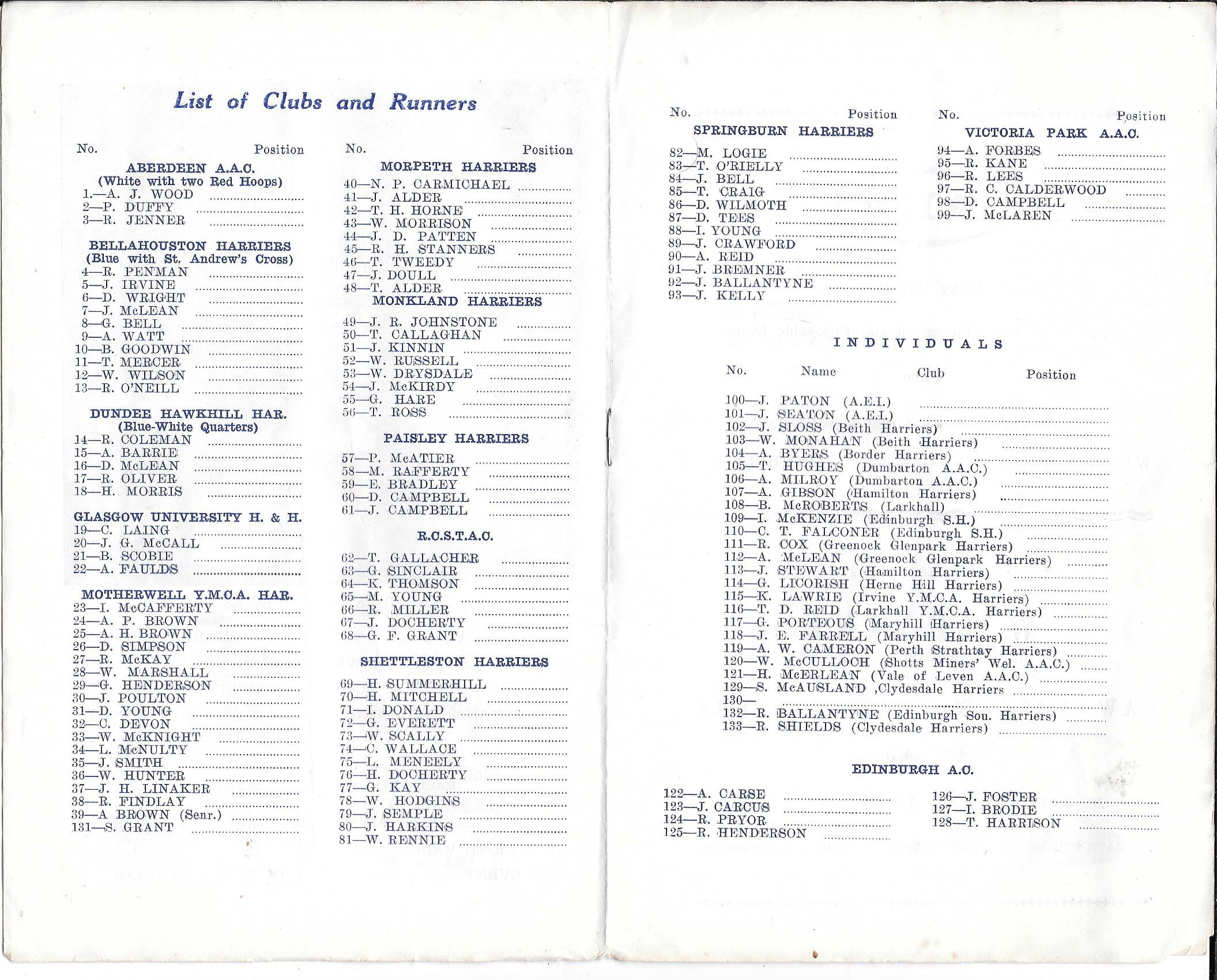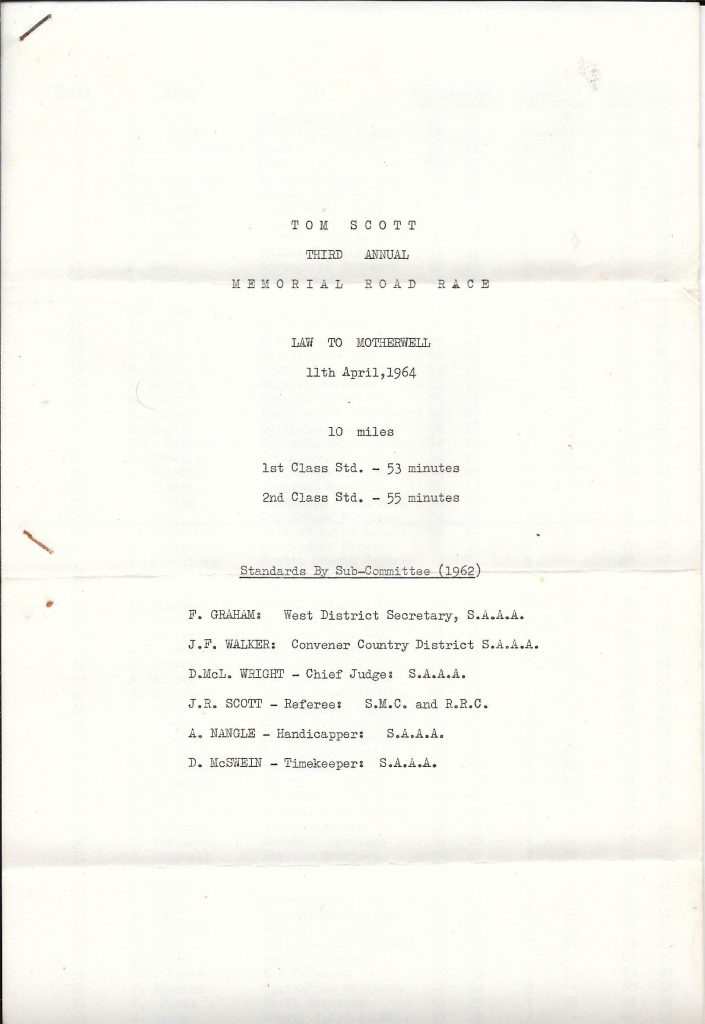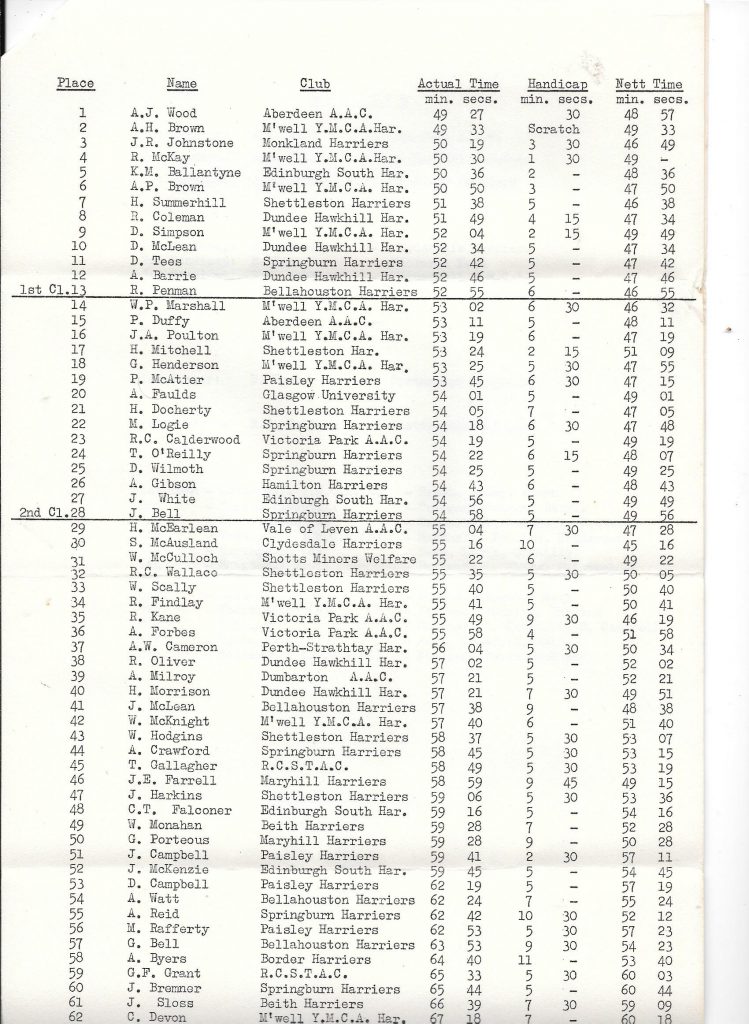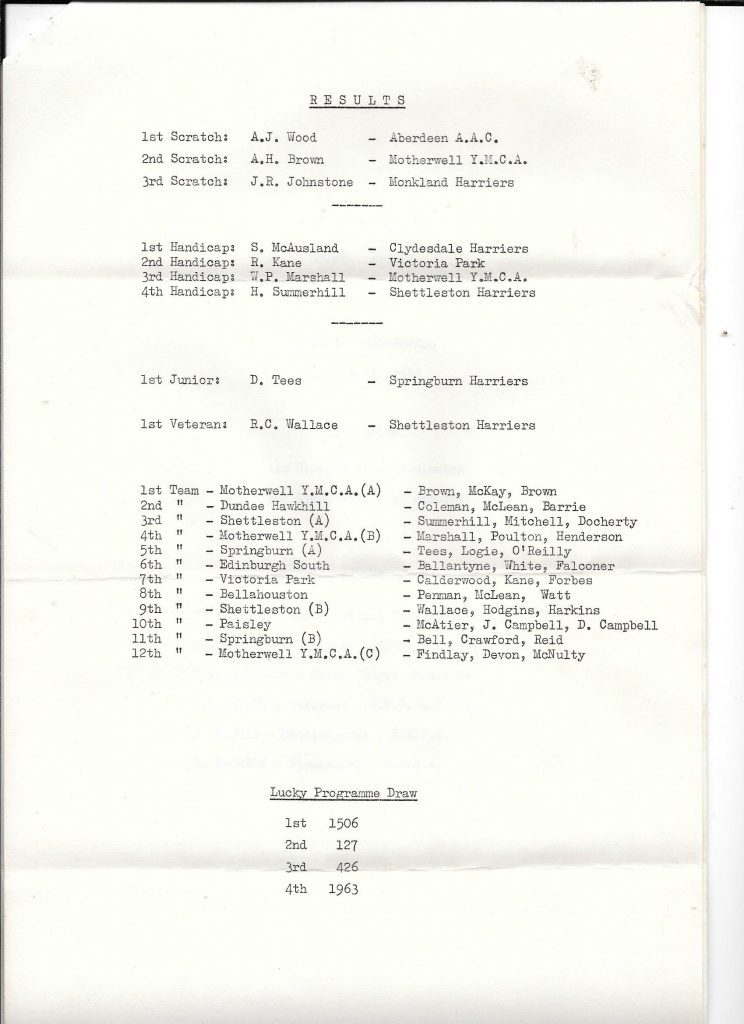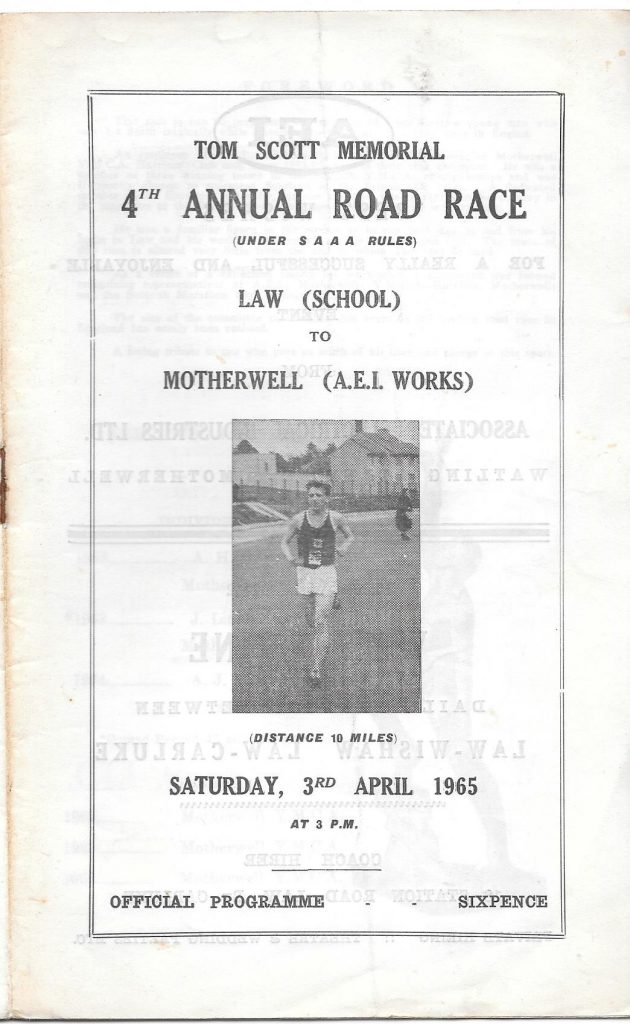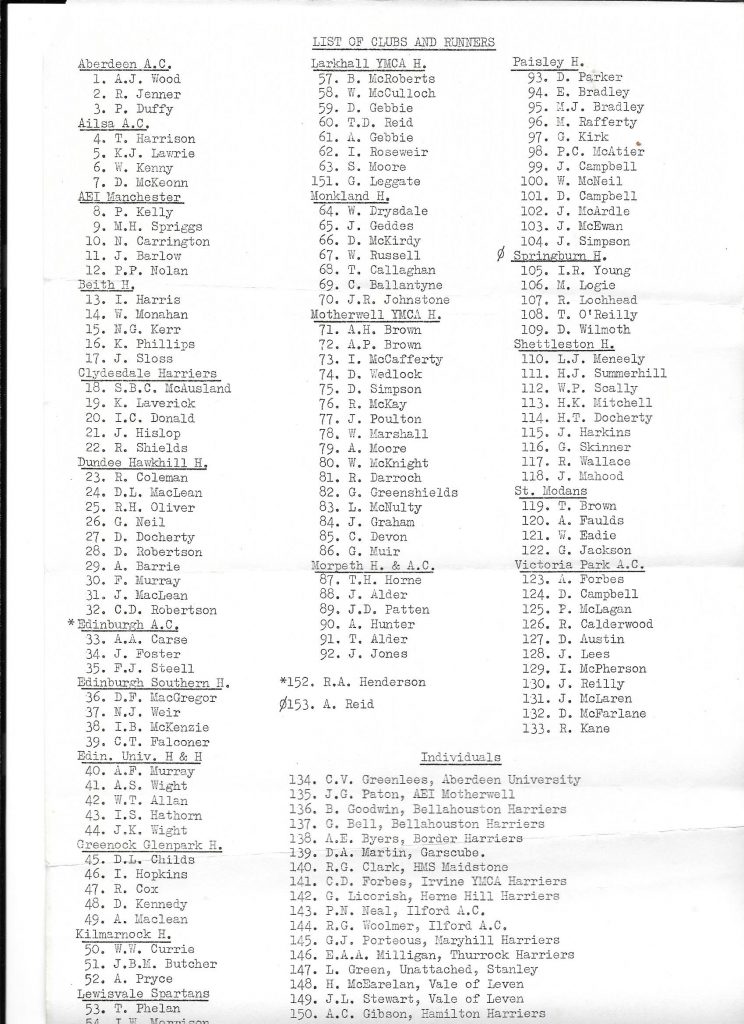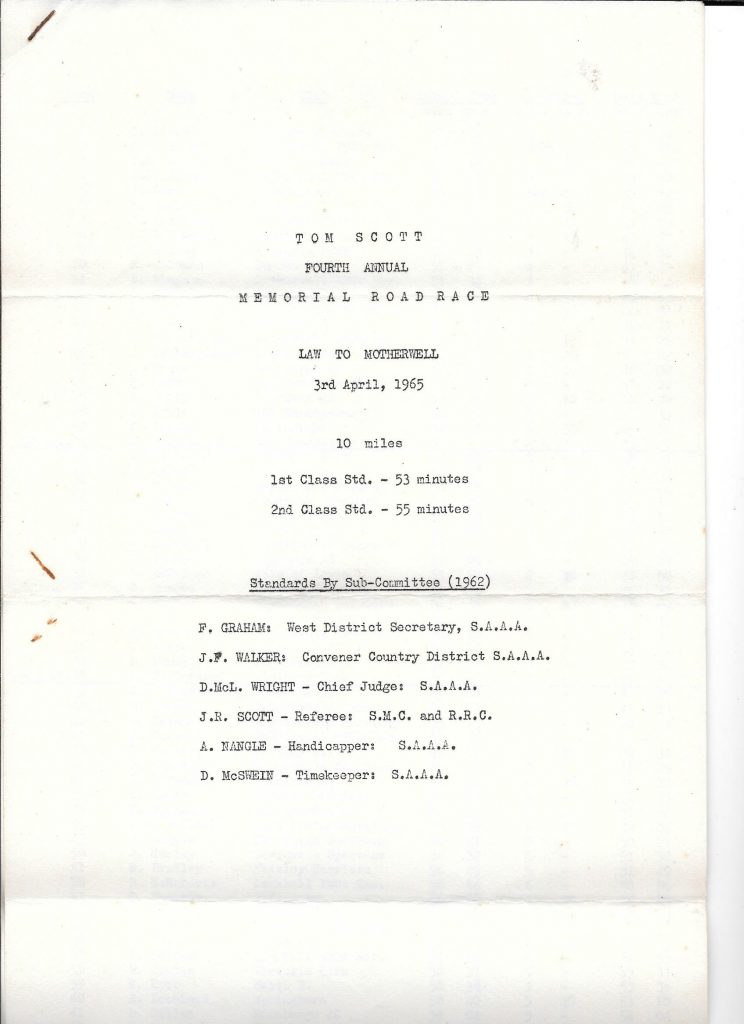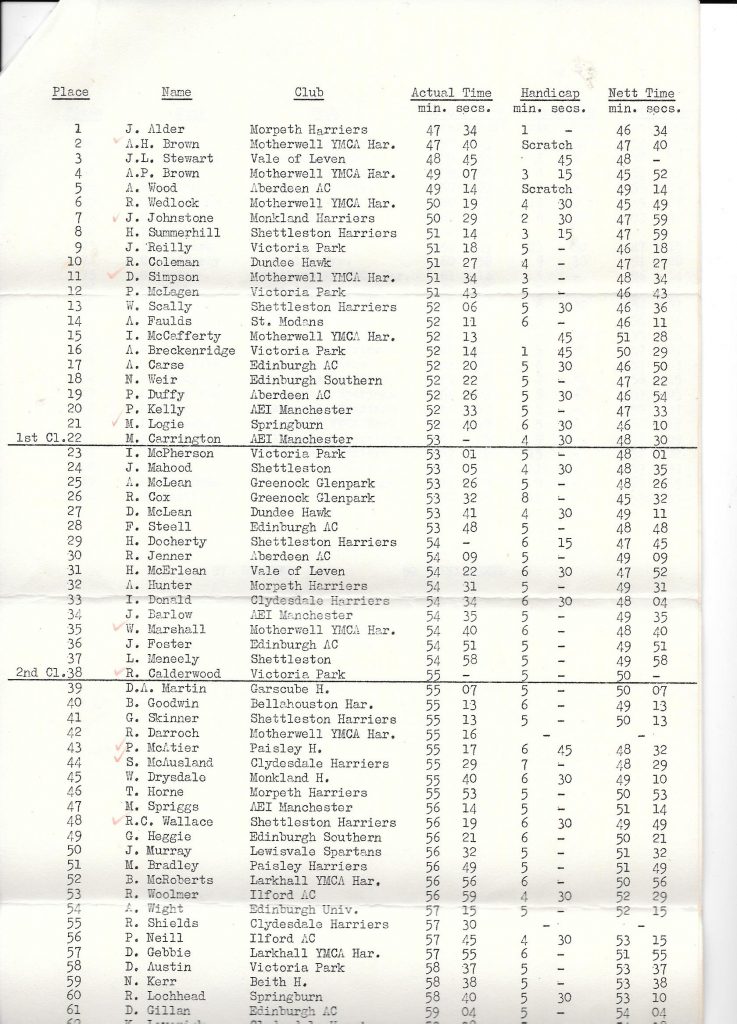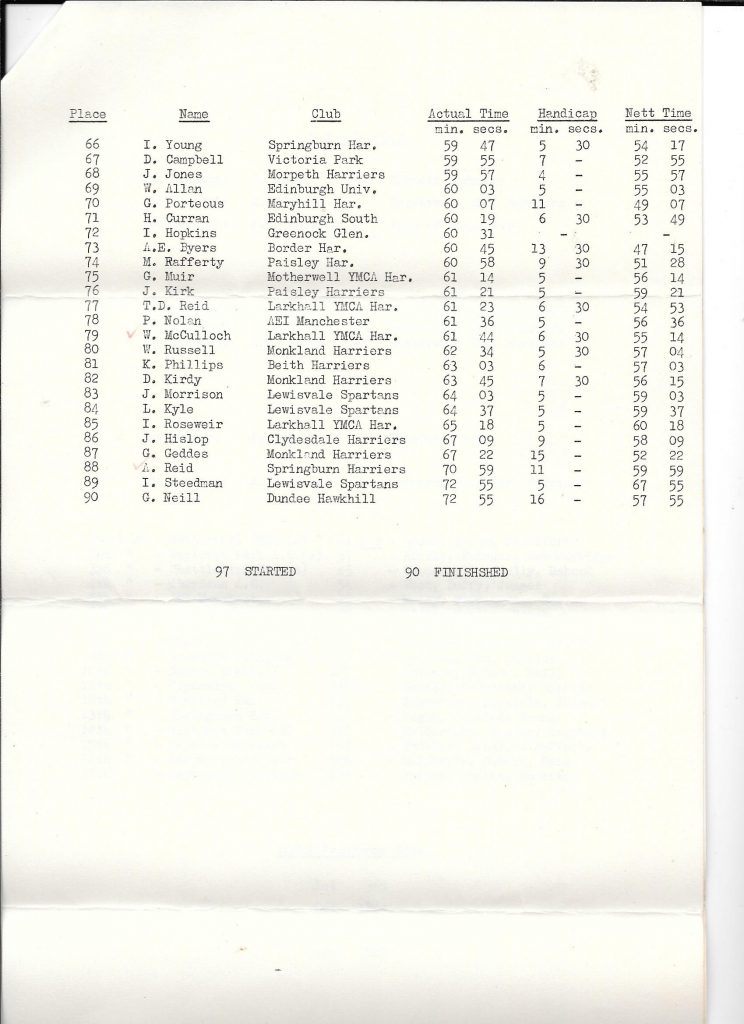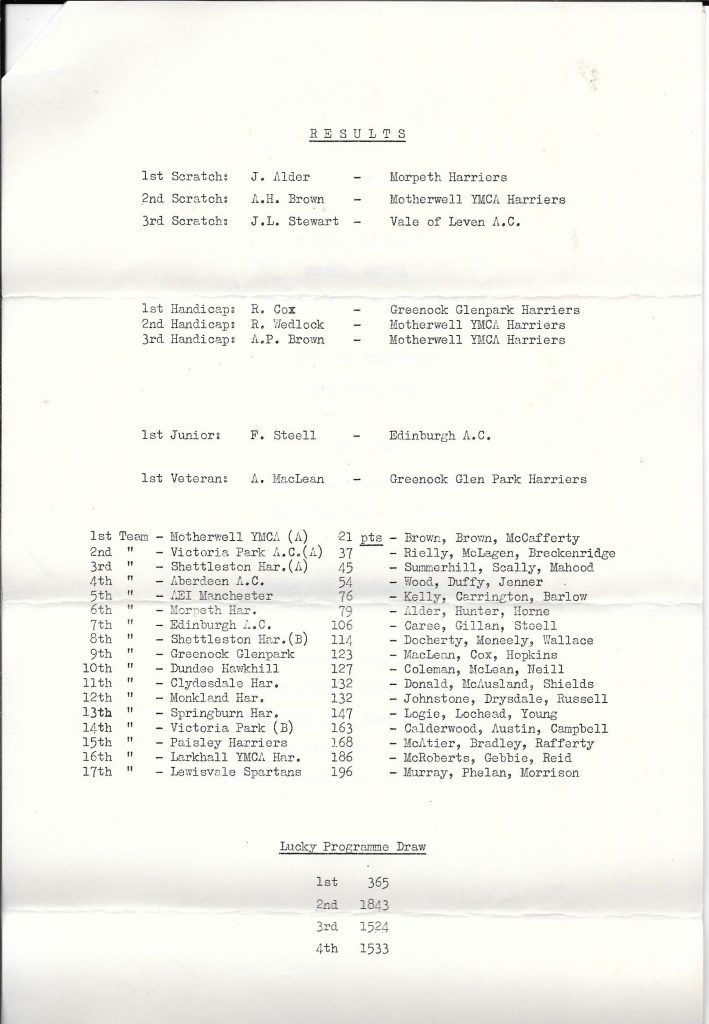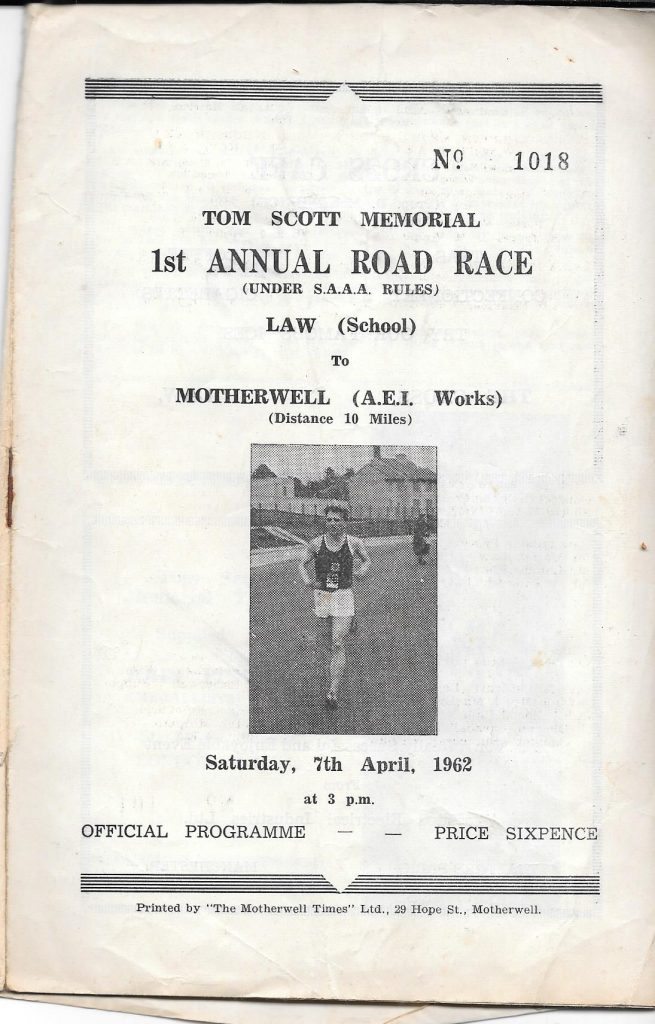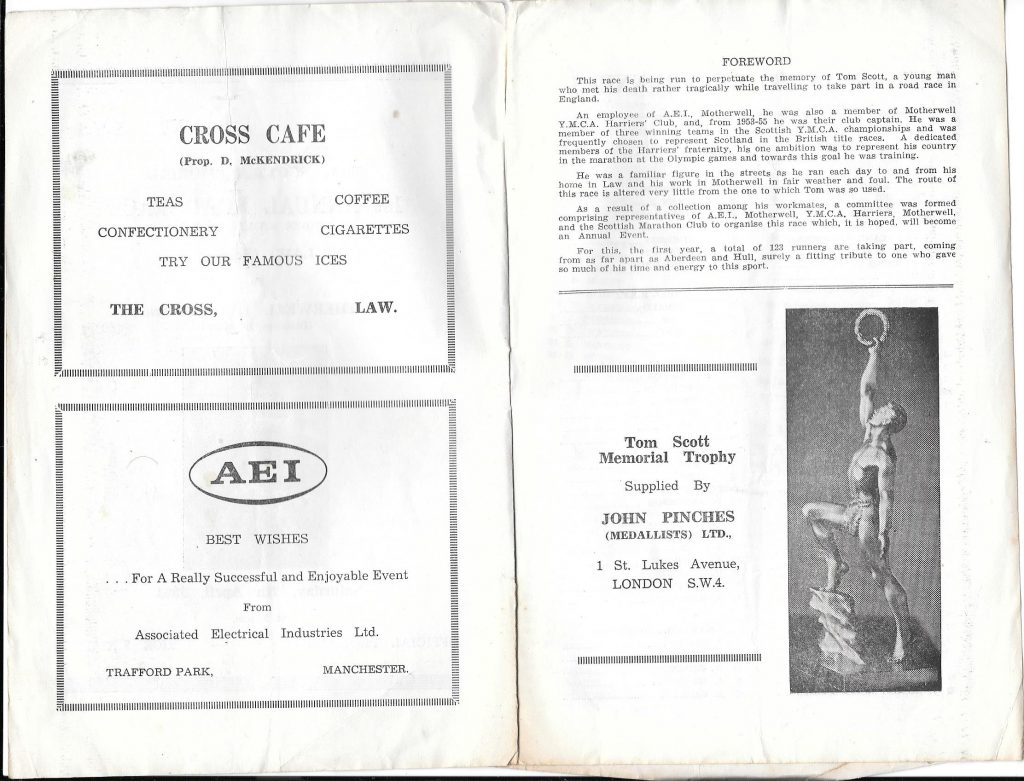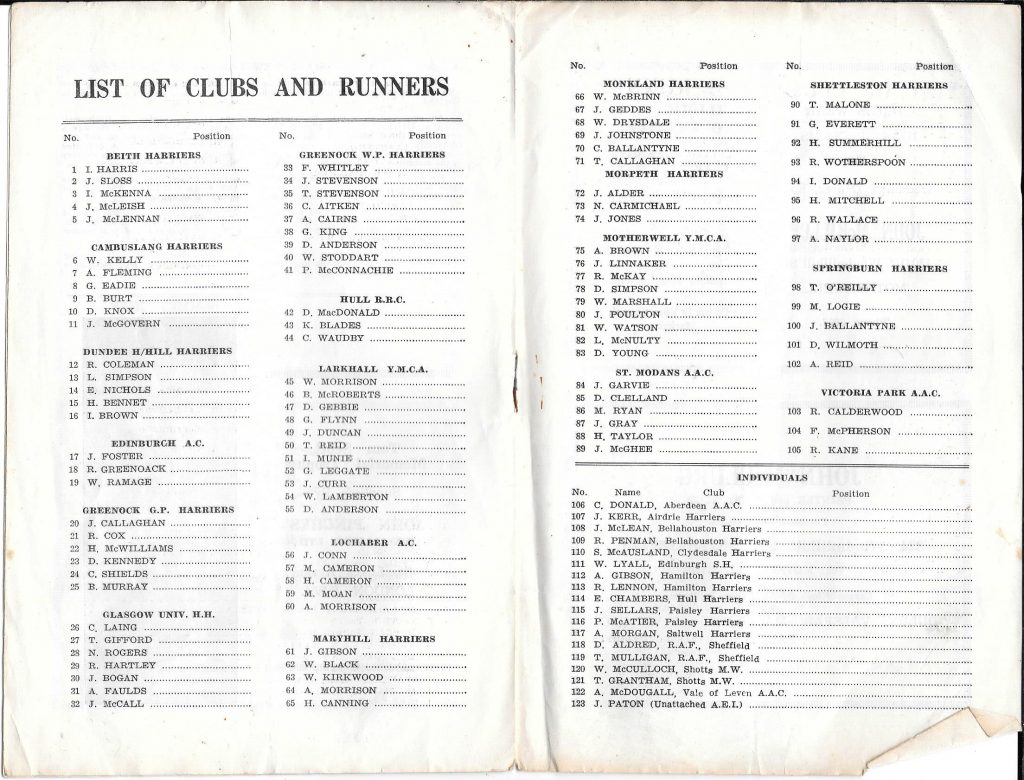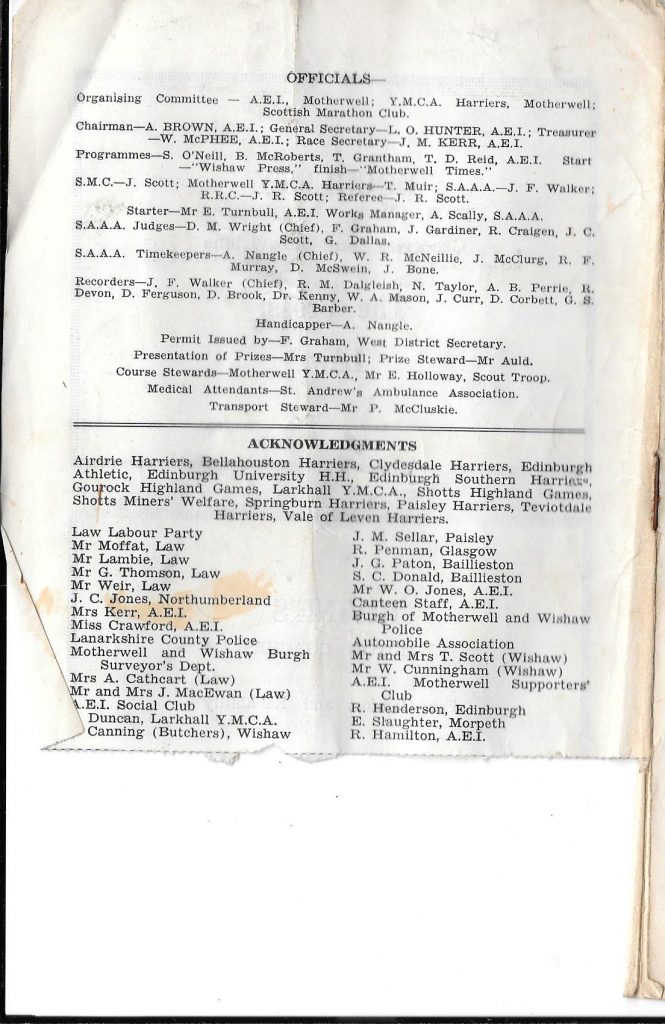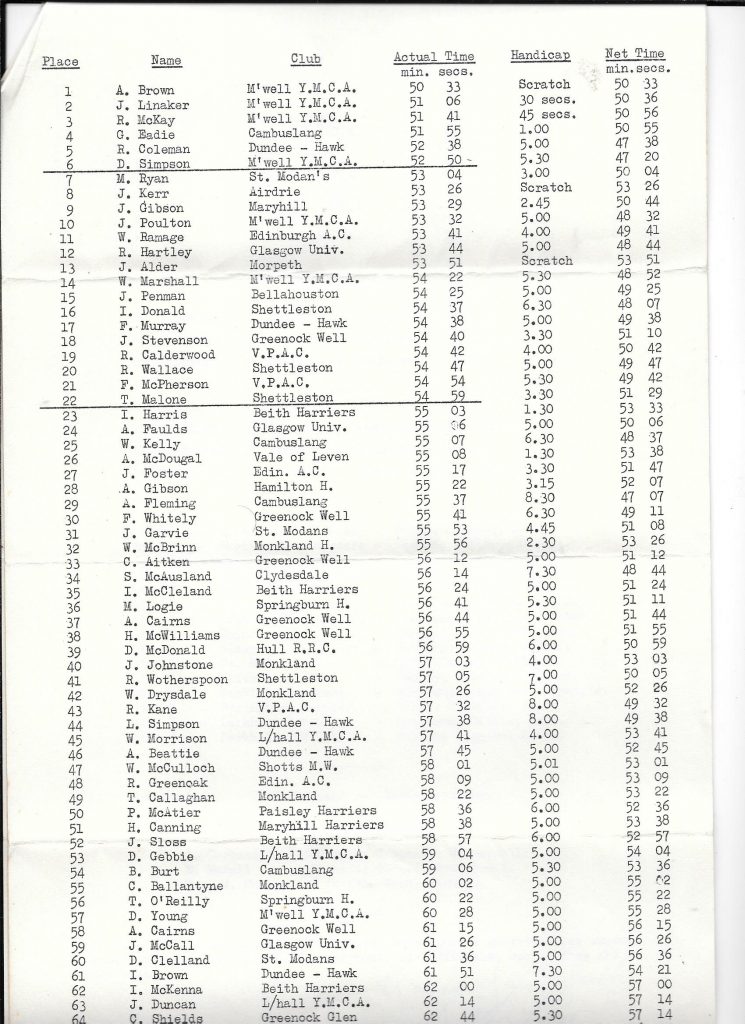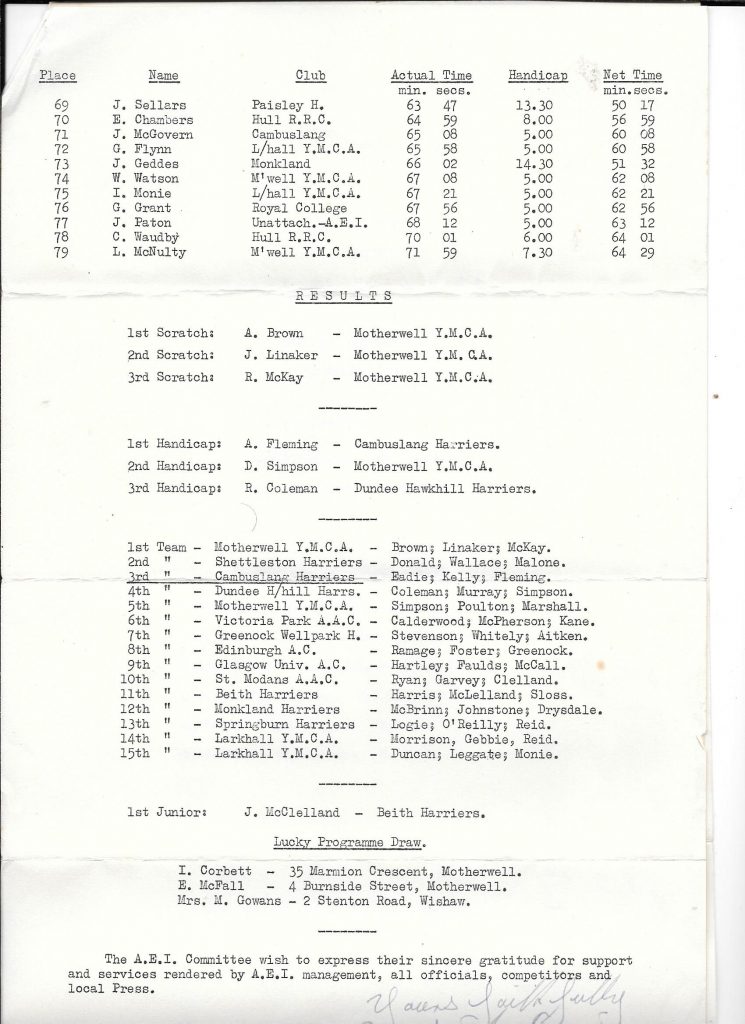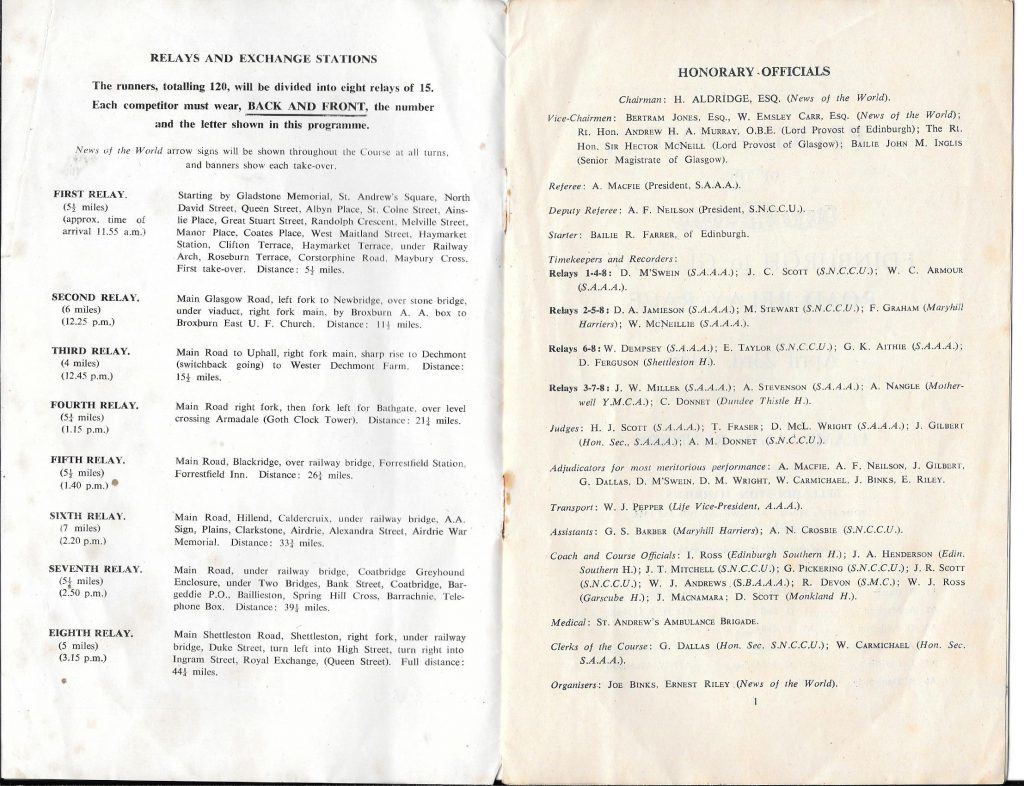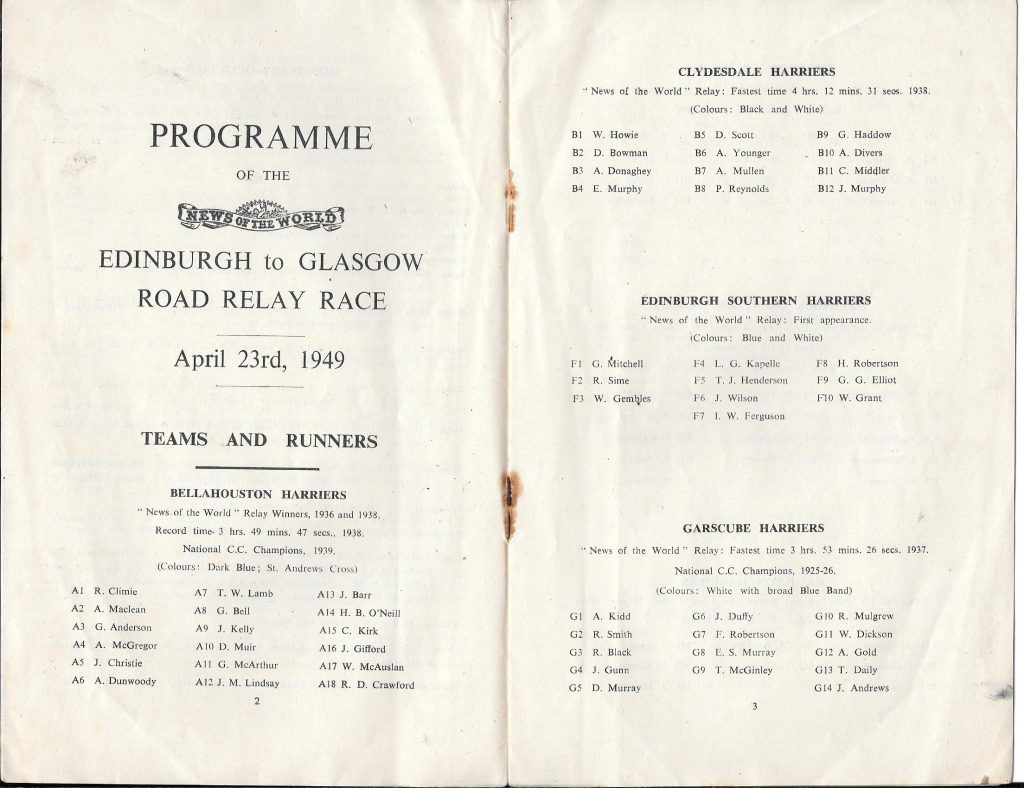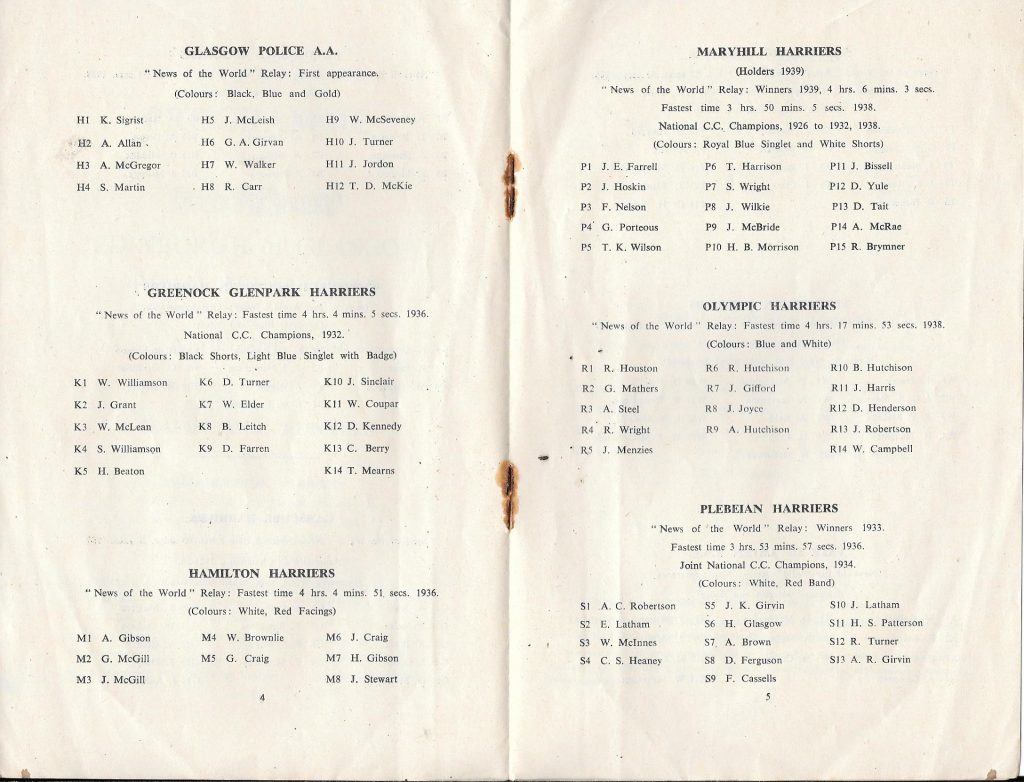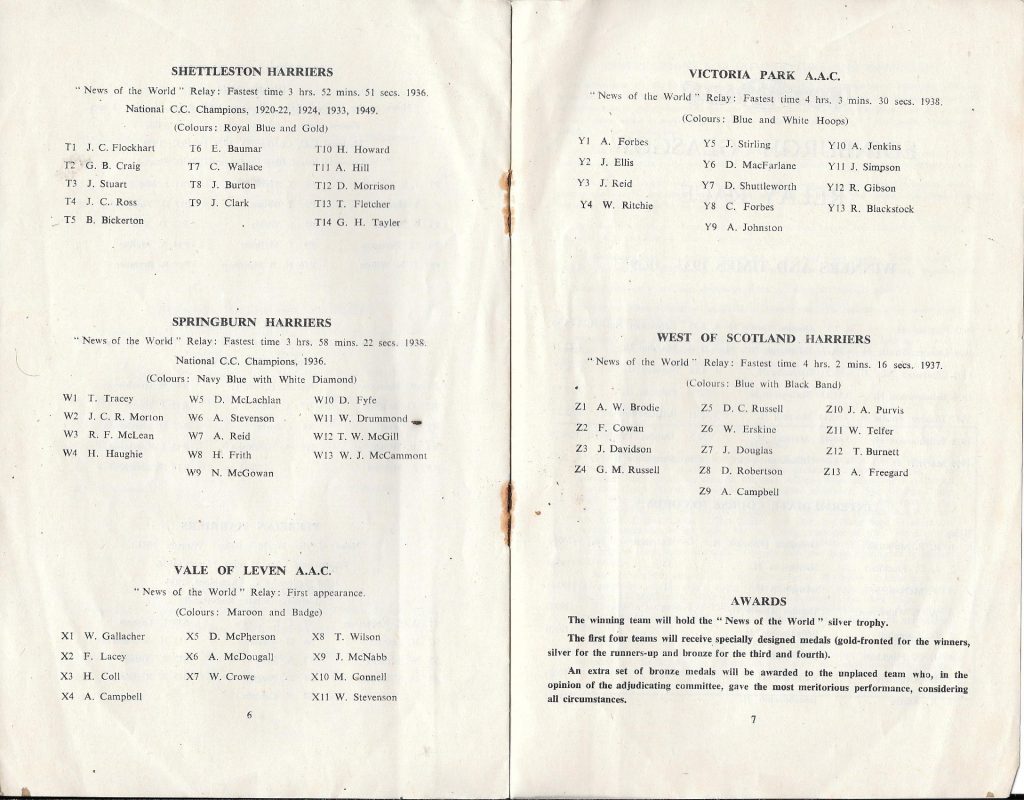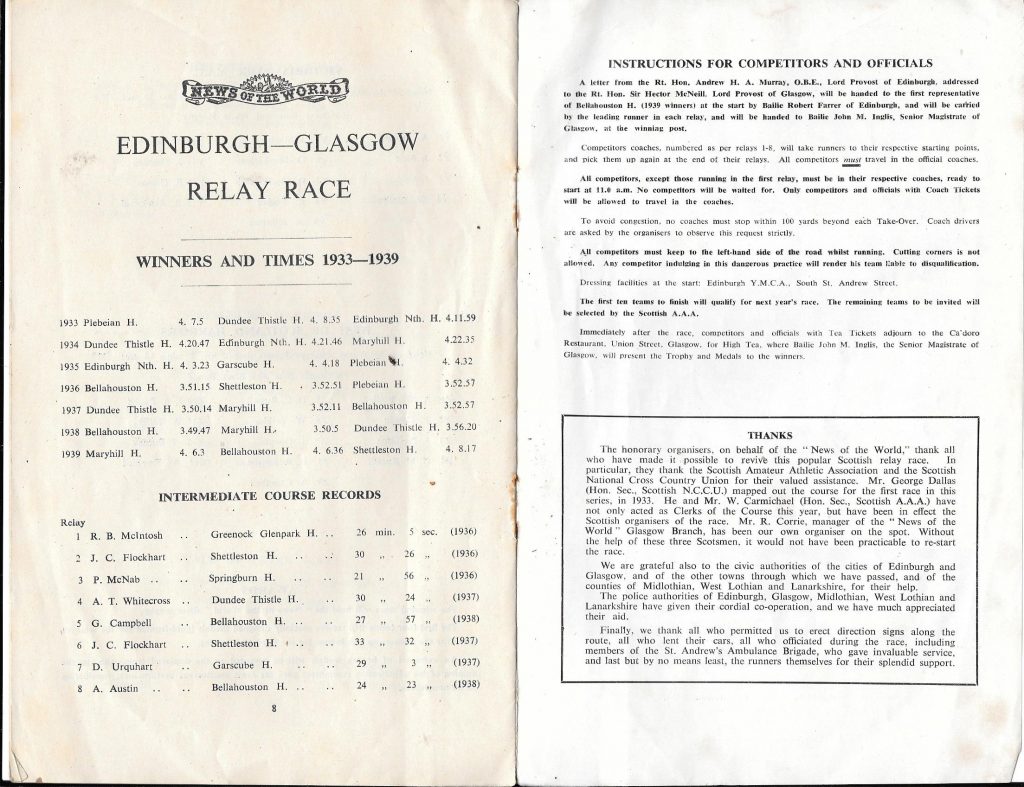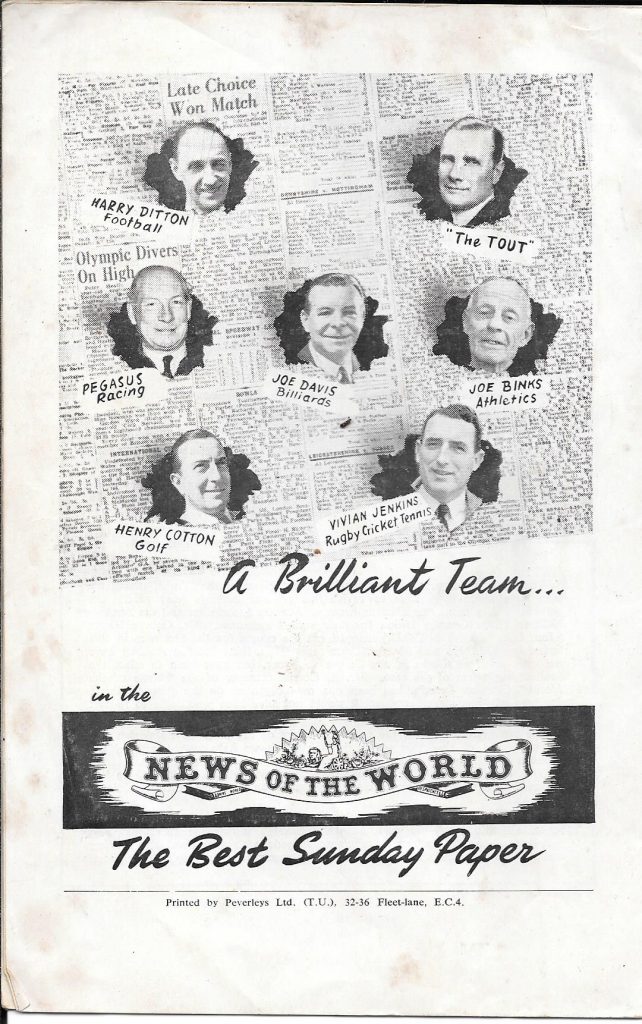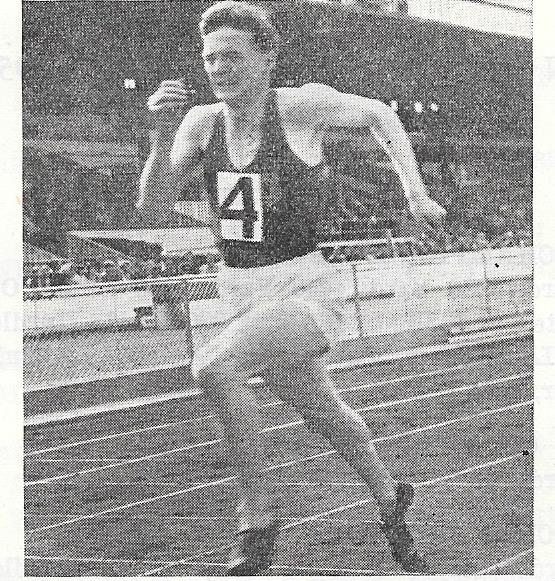
DK Gracie: One of Scotland’s best ever hurdlers
The YMCA movement had a significant place in the development of athletics in Scotland and this should be recognised. They provided administrators, officials and (most important) athletes at all levels from the local area in which they started through County, District and National levels. Larkhall YMCA as an athletics club has been doing this from the late 1920’s up to the present – at least for a period of 89 years – while the club has been in existence since 1897. A record of service to the community and to the nation that few can match.
Club secretary Willie Mowbray has written a detailed and informative history of the club from which a lot of what follows has been derived, and we begin with his remarks on the founding of the club: “We know a rambling club was very active in the town in the 1920s and Richard Campbell, who joined the club at the end of WW11, believed that the Harriers evolved directly from this club. By 1930 the YMCA had an indoor athletic section and that summer the Lanarkshire Association of YMCAs held its Sports Day in Larkhall. Informal committee meetings and AGMs were being held from 1930; we know this because they are referred to in the formal minutes book which dates from April 1933. The stage was set for someone to harness this disparate athletic type activity, and this someone was John C. Scott, an official at Hamilton Harriers. Under his guiding influence, which was remembered by club members more than twenty years later, Larkhall YMCA Harriers formally came into being in September 1931.”
Before we look at the club’s athletics performances from its foundations to the start of the twenty first century, it is appropriate to make two points:
First, that the YMCA movement is wider than just athletics and for a comprehensive coverage of the organisation we could look at the Wikipedia article at https://en.wikipedia.org/wiki/YMCA . Willie points out that “over 88 years the Harriers’ Club has provided a healthy outlet for successive generations of youngsters from Larkhall and the surrounding area. The club has been particularly effective in promoting the social and physical ethos of the YMCA. Moreover its members have over the years become increasingly involved in maintaining the YMCA’s presence in the town; to the extent that today the Harriers and the YMCA are virtually synonymous in people’s minds.” The YMCA is about more than athletics.”
Second, that Larkhall had a good record in athletcs even before the YMCA became involved. For instance, the very first cross-country international was held at Hamilton Race Course on 28th March in 1903 and the first Scot to cross the finishing line was J Crosbie of Larkhall. It’s a proud record to have – and a good question for the next athletics quiz: “Who was the first Scot ever to lead home a Scottish team in a cross-country international fixture?” Not many would guess that it was a Larkhall man.
In the National championships that year only four clubs finished complete teams of six but the ‘Glasgow Herald’ remarked that Larkhall had finished with five men led home by Crosbie who finished seventh. This was no surprise – they had done well to win the Western District Championships on 14th February that year – the race, also run at Hamilton, was won by Ure of Greenock Wellpark Harriers with Crosbie second and A Barr (both Larkhall Harriers) in third. In all these races the team was listed as Larkhall Harriers although in the official history of the SCCU the club is referred to as Larkhall YMCA. This an error on the part of the SCCU history. The fact is, however, that there was a tradition of good cross-country running in the district.
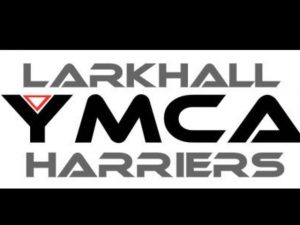
Willie Mowbray refers to an article in the Hamilton Advertiser from 1931 – “Interestingly, in the Hamilton Advertiser article that records the start of the club, (dated October 1931) the correspondent recalls the previous Harriers Club which existed in the town before the Great War. Although it had no connection to the newly formed YMCA club, its members did perform with distinction during the Edwardian era – especially in 1903 when the club won the Midland Districts Men’s Cross Country Championship team title and “reigned supreme in the west”.
The club’s first pack run was held in October 1931 and the first written records for the club are dated from November that year. Founded in 1931, they would not have competed in any championships in season 1931 -32, but by 1932 they were ready.
We can take up the tale in October 1932 There were well over a hundred clubs in membership of the Union and a list of those in 1932 is published here . The cross-country season was usually regarded as starting on the first Saturday in October and followed a definite annual pattern. The Glasgow Herald published details of the various club runs as they had them. Larkhall YMCA was not written up – but then neither were many other clubs: of the 120+ clubs in the country, there were fewer than 20 had their domestic runs printed. Three weeks later, on 15th October there was what the ‘Herald’ called a “spate of novice championships” when 27 clubs held their own novice championships. Larkhall was among them and the winner over a five mile course (which included a sealed handicap) run from Charing Cross, Larkhall, was R Brown in 32:53 followed by A Leckie and C McMillan. The Handicap winner was C McMillan with a handicap of one minute and a finishing time of 33:34, The National Novice Championships were held at Hamilton Race Course on 5th November and Larkhall YMCA made their first appearance there: it was a big meeting with 38 teams entered and 299 runners. Larkhall did well to finish twentieth – with clubs like Glenpark, Glasgow YMCA, Wellpark, Clydesdale Harriers and Victoria Park among the scalps taken. 7th Nov 1932 was another day for the harrier clubs to have their own club runs, handicaps or novice races – in the absence of a detailed racing programme, these made up the bulk of the winter season for most clubs. The Midland District Relay championships were held on 26th November at Saltcoats and was won by Shettleston Harriers but Larkhall YMCA did not compete – it was still early days for the club. Saturday 17th December, however, saw the club take part in the YMCA Championships over the country at Spiers Bridge, Thornliebank, with Suttie Smith winning the individual title and Cambuslang the team championship. With four runners to count for the team placing, Larkhall were eighth, three points behind Motherwell and 41 ahead of East Kilbride.
Into January, 1933 and on the 7th they entertained Hamilton Harriers to Larkhall and two packs covered five and a half miles, and two weeks later, Larkhall went to Hamilton where three packs covered seven miles. The last Saturday was a home run for all clubs in preparation for the District Championships the following week but there was no team from Larkhall YMCA which was probably still feeling its way in the sport. On 25th February, the last run of the month was an away inter-club with Motherwell YMCA where Bobby Craigen was first home for the fast pack. Having missed the District Championships, the club also missed the Nationals at Hamilton at the start of March. However, this first full season could be counted a success with a training pattern established, club runs most Saturdays, inter club fixtures with Bellshill YMCA, Motherwell YMCA and Hamilton Harriers as well as putting teams forth in several events such as the Scottish YMCA championships. There were a few other home runs but the cross-country season was basically finished.
Although the club almost certainly did compete over the summer season, the cross-country winter season was to be their main focus. It was a stronger and more experienced club which started the new winter season in October of that year.
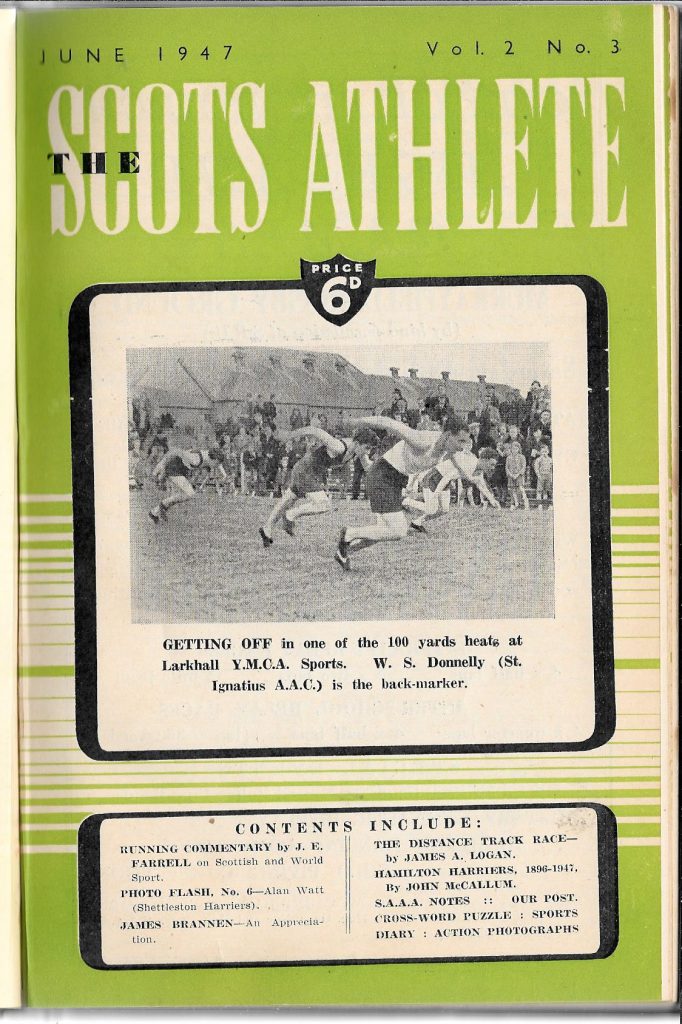
In season 1933-34 they were much more active. Almost all clubs started the season on 7th October with a club run, followed by the club’s novice championship a week later. A novice was a runner, however old and experienced, who had never won a prize and the races were always keenly contested since the ‘stars’ were out of the running. The National Novice Championship was held at Hamilton on 4th November with 37 clubs taking part: Larkhall was 28th, one place behind Maryhill Harriers and one place in front of Dumbarton AAC (founded 1919). On November 18th when the South Western Relays were taking place, Larkhall opted out and instead had a two and a half mile junior handicap from ‘headquarters’. This was won by R Williamson (2 minutes) in 14 min 53 sec, from F Mackie (scratch) in 16 min. The YMCA Championships were held at Dechmont, Cambuslang on 16th December and were won in a dead heat by Kirkcaldy and Motherwell with Larkhall YMCA ninth. Their team was T White 45th, F Mackie 48th, T Stewart 50th and W Miller 56th. The race was won for the seventh time by J Suttie Smith of Dundee from A Dow of Kirkcaldy who also won the medal for the first first-claim member home. 1933 ended with a race from the club’s headquarters on 30th December over five miles with the first arrivals being A Leckie, A Douglas and A Mackie. These runs were typically pack runs with the runners gathering one mile or so from the finish and making a run for home. A week later , 6th January, when the major clubs were running in the Edinburgh to Glasgow relay race, most of the other clubs had home runs or inter-club fixtures. Larkhall YMCA hosted Hamilton Harriers when two packs covered six miles. The first arrivals for the ‘slows’ were A Douglas, J Storrie and J Murphy (all Larkhall); and for the ‘fasts’, A Mackie (Larkhall), P Gaffney (Hamilton) and A Leckie (Larkhall). This led into the club championship over 6 miles which was won by T White (1 minute) in 41:35, from W Miller (scratch) in 42 min 05 and A Douglas (2 min 30) 42 min 25 sec. The club was spreading its wings by now and ne week later they travelled to Bellshill for a run with that YMCA with three separate packs going out: the junors covered 3 miles, the slows four and a half miles and the fasts a long eight miles. Into February and on the third of the month the club had a club run with A Mackie first home. On 24th February, 1934, Motherwell were the guests at Larkhall where three packs covered six miles. The first arrivals were: slows – J Pennell (M), T Purves (M) and A Mackie (L); Mediums – R Devon (M), T Stewart (L), and JM Laing (M); fasts – M Simpson (M), J McDonald (M) and R Craigen (M). The two major championships came in the new year and in the Districts the club took part for the first time and finished 17th; the national was held on 3rd March, again at Hamilton, but there was no senior team forward from Larkhall YMCA, although F Mackie competed in the Youths age group.
It had been an even better season for the club with club runs, inter clubs, races and championships all on their programme. The pattern had been set for the club and it continued to grow and develop. 1935 would see further developments with a team entered in the eight stage relay less than four years after the club was born.
*
The 1934-35 season began with all the clubs holding their own races and club runs on 6th October. For Larkhall this meant a five miles novice championship and sealed handicap over 5 miles from club headquarters. First home were I Steel 32 min 40 3-5th sec followed by R Gebbie in 33 min 15 2-5th sec and J Mrphy 34 min 31 sec. The handicap was won by FMcLachlan (1 min 45 sec) in 33 min 05 sec. A week later and three packs covered five miles. Another week and it was another home run with one pack covering five miles, W Miller being first man home. The National Novice Championship was held on 5th November and Larkhall were out of the medals although their exact position is not known. The Newly formed Lanarkshire Association had their first joint run on 1st December at Bellshill and there was a great turn out, according to the Press, although the clubs taking part were not named, but since there was no home run that day, it can be taken that they participated. The following Saturday three packs covered three miles with T White leading the runners home. The Scottish YMCA Championships were held on 15th December at Motherwell and Suttie Smith was beaten by A Dow and in the team race, Larkhall finished sixth club.
The new year started with a joint run at Hamilton with the local Harriers on 5th January when three packs covered six miles from Hamilton Baths. The club was doing fairly well – well enough to enter a team for the prestigious eight stage Edinburgh to Glasgow Road Relay. The team was 17th but the important thing was that they had eight men good enough to take part in such an event. Most races only required six man teams. The following Saturday they held what they called an ‘unattached three and a half mile service race’ from headquarters. On February 2nd 1935 the club was 17th in the Midlands District at Hamilton while such as Motherwell YMCA, Cambuslang YMCA and Glasgow University did not finish complete teams. On 9th February the club held a four miles Junior championship: Result: 1. W Duncan in 34:35; 2. J McMillan 24:45; 3. W Brown 26:30. Handicap: W MacIntosh (40) 28:15. The club championship proper was held on 16th February over nine miles and the result of that was: 1. J Steel 48:43; 2. S Gebbie 48:47; 3. J White 49:05. Handicap J White 48:15. The National Championships were held at Hamilton on 2nd March and there was more evidence of the club’s progress when complete teams finished in both Senior and Youths races. The Senior Men’s team was 17th (J Steel 83, T White 84, F McLaughlin 89, J Russell 117, J Gebbie 124, R Cumming 146); and the Youths (ie Under 17) team 6th/11 (W Duncan 16th, J McMillan 17, A Berry 35, W Perrie 38). The following week there was a seven miles run at home but after the National the season was pretty well finished. Again there had been signs of improvement – teams forth in both National and District championships, an eight man team in the Edinburgh to Glasgow and a Youths team finishing in the National. That was of course in addition to the usual complement of club, inter-club and YMCA events.
The 1935 season started with the new McAndrew Cup Relays at Scotstoun but Larkhall chose not to travel and instead had their own four mile novice handicap where S Gebbie won in 32 min 03 sec from J Gebbie in 32 min 24 sec. From this point, rather than just list the races, inter clubs, and home runs that the club was involved in, it might be better to show how the club performed in the major championships from 1935 up to the start of the War in 1918.
| Date |
Event |
Team Position |
Comments |
|---|
| 4 Nov 35 |
Novice Championships |
7th/29 teams |
Best ever performance |
| 14 Dec 35 |
YMCA Championships |
5th of 9 teams |
Second team 9th |
| Feb 36 |
District Championships |
C Gebbie 56th |
only one senior |
| 7 Mar 36 |
National |
9th in Youths race |
Duncan/McFarlane/Houston/Dawson |
| 7 Nov 36 |
Novice Championships |
15th of 30 teams |
Wedlock/McMillan/Gebbie/Lyle |
| Dec 36 |
YMCA Championships |
2nd team |
Gebbie 10th club's first top 10 finisher |
| Feb 37 |
District Championships |
15th Team |
Gebbie/McMillan/Steel/White/Perrie/Kilpatrick |
| 8 Mar 37 |
National Championships |
Wedlock 22nd junior |
no senior team |
| 3 April 37 |
Edinburgh – Glasgow |
13th of 16 |
– |
| 6 Nov 37 |
Novice Championship |
26 of 35 |
– |
| 18 Dec 37 |
YMCA Championship |
1st team of 7 |
Gebbie 3/McMillan 4/Perrie 5/Wedlock 6 |
| 9 Apr 38 |
Edinburgh to Glasgow |
14th of 17 |
– |
| 5 Nov 38 |
Novice Championships |
20th of 32 |
– |
| 17 Dec 38 |
YMCA Championships |
7th of 9 |
– |
| 4 Mar 39 |
National |
18th of 23 |
McMillan/Gebbie/Berry/Lyle/McFarlane/Scott |
| 22 Nov 39 |
Edinburgh to Glasgow |
incomplete team |
– |
The club had been in existence for only eight years when the second world war broke out and athletics came to a temporary halt. It had been a period of consistent progress with every year building on the previous one and it was unfortunate that the momentum was halted.
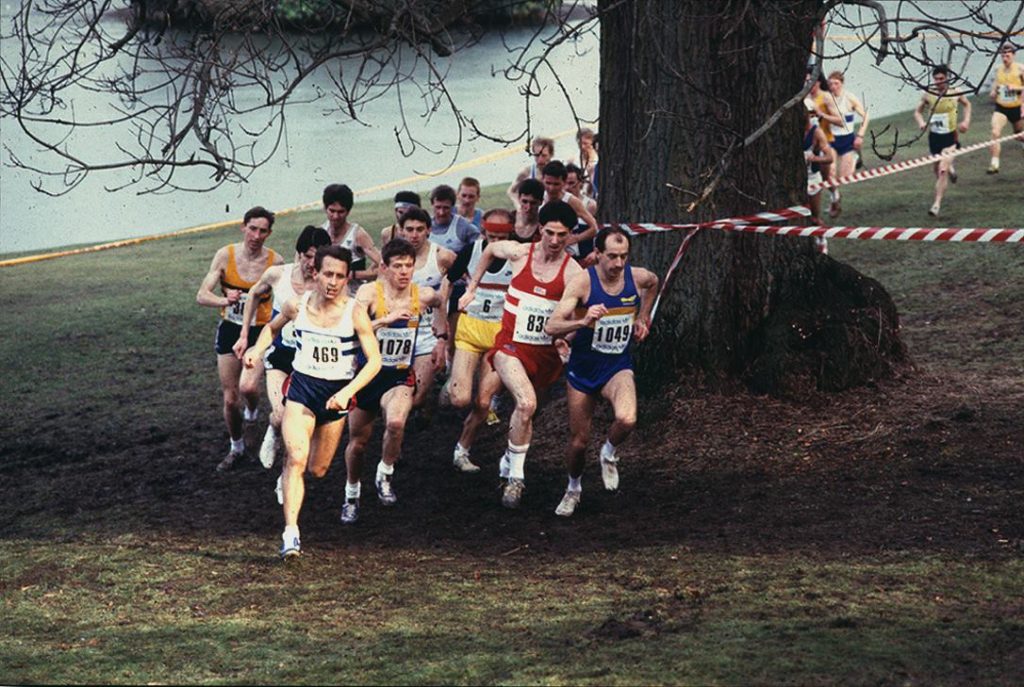
1986 National Cross-Country Championship. Jim Egan (Larkhall YMCA) on the shoulder of Nat Muir (1049).
Others in the shot are Chris Robison, Neil Tennant, Ian Archibald, John Robson, Fraser Clyne, Tommy Murray and Allister Hutton
Nationally there was a war time committee which ran a proramme of events involving clubs and teams from the services. After the war, club activities started up again and there would be many excellent athletes representing Larkhall YMCA. The font of wisdom on Scottish athletics after the war was the ‘Scots Athlete’ magazine and the club’s progress nationally can be tracked there. And that includes the progress of the man that many regard as the best athlete the club has produced – David Gracie. The club as a whole however continued to improve year on year in all the major championships.
The third issue (June 1946) of the above magazine described their idea of a Scottish Clubs League which had points awarded for all athletes in races of whatever distance at any meeting or championship in Scotland. Their ‘league table’ had Larkhall in 18th place of the 33 clubs ranked. The ‘Round the Clubhouses’ item in the same issue had the following announcement:
“Larkhall YMCA have compiled their track championship races for the ‘John Steel Trophy’. Starting from June 11th, the events are 100 yards, 220 yards, 440 yards, 880 yards, Mile 2 Miles, 3 Miles.” Both items indicate that the club had ‘hit the ground running’ after the war and is a tribute to the committee and those organising the club at a difficult time. The ‘League’ continued and in the July issue the club was 22nd of the 42 clubs now included: ie in the top half. By the end of the season there were 49 clubs included and Larkhall YMCA had slipped a wee bit to 26th.
The following cross-country season (1946-47) the club did not appear in the results of the major championships. This is one of the puzzling things about the Larkhall team of the late 40’s and very early 50’s: they seemed reluctant to travel to championships. It was not that they were not producng good runners – they were and names like TC Reid, P Corrigan, D Brown and J Stevenson were of a high standard. Then about 1952/53 the runners started to turn out in slightly bigger numbers. Have a look at these results.
Date |
event |
position |
comments |
|---|
| 20 Nov 48 |
Novice championship |
only 2 runners |
TD Reid 16/P Corrigan 13 |
| 5 March 49 |
National |
No Team |
TD Reid 60 |
| 5 Nov 49 |
Midland Relay |
12th team of 37 |
TD Reid14:45/W Hannah 15:13/D Brown 15:21/P Corrigan 15:21 |
| 4 Feb 50 |
Midland Champs |
No Team |
TD Reid 13/ D Brown 48/P Corrigan 69 |
| 4 March 50 |
National. No Team |
D Brown 30th/TD Reid 9th Junior |
| 16 Dec 50 |
Inter Counties |
– |
TD Reid 20th |
| 3 March 51 |
National Senior |
No Team |
D Brown 17 |
|
|
| 1 Nov 52 |
Midland District Relay |
18th out of 29 teams |
DK Gracie 15:26/W Duncan 14:45/TD Reid 14:25/J Stevenson 14:04 |
| 28 Feb 53 |
National |
No teams |
J Stevenson 10th Junior |
| 6 Feb 54 |
Midland District |
No Team |
TD Reid 24/ J Stevenson 26/ N Duncan 39 |
|
| 6 Mar 54 |
National |
Senior NT |
TD Reid 45 |
|
|
| 6 Nov 54 |
Midland District Relay |
Team 8th of 29 |
I Duncan 17:48/TD Reid 17:53/J Gilfillan 18:19/J Stevenson 17:08 |
| 29 Jan 55 |
Midland District |
No Team |
J Stevenson 13/N Duncan 17/TD Reid 63 |
| 26 Feb 55 |
National |
No Team |
TD Reid 31/J Smith 79 |
|
There was no shortage of talent there – some of these runners were good enough to run in any team for any club in the country. There was initially a shortage of racing though, but we are talking about a period just after the war. There was real austerity then – money was short, transport was much more difficult than it is now, but the numbers started to pick up again after about 1953. The relay team of November, 1954, which finished 8th in a field of twenty nine club teams was a good one which ran well on what was a relatively long trail for a relay in those days.
Meanwhile the track men had also been in action. In addition to the local sports meetings the Scottish UMCA championships were held annually in May. The article in the ‘Glasgow Herald for 22nd May 1952 read: “DK Gracie (Larkhall) was the outstanding athlete at the YMCA championships held at Helenvale Park, Glasgow, on Saturday. He retained his “quarter” title in 52.8 sec (1 sec worse than his winning time a year ago), and earlier in the programme he took part in the half mile for the first time and won in 2 min 3.9 sec.” That was the entire article – apart from the results. With teams from Motherwell, Irvine, Glasgow, Greenock, Kirkcaldy, Paisley, Kirkintilloch and Grangemouth all taking part it was a good meeting. Other Larkhall success came in the Youths age group where JM Smith won the 100 yards in 11.2, N Duncan won the 880 yards in 2 min 20.4 and the club won the relay in 1 min 38.3 sec. The reference to the previous year is that Gracie won both 220 yards (25.8) and 440 (51.8) but reports did not cover the Youth or Junior events that had been held. There were still severe restrictions on newsprint and sports results were cut to a minimum. If you add in that the third weekend was a busy one for athletics (regular meetings on that date were School and University championships, League Matches and invitation matches were fashionable (ie in 1951 there was a Glasgow Highland Games at Celtic Park) then coverage of the YM championships was often scanty with only senior events being covered. That did not detract from the fact that the YMCA championships were a fairly big meeting with athletes from all over Scotland competing – and Larkhall took part in it. In 1953 Gracie again was the only athlete reported on when the meeting was held at Alloa on 16th May. This time he had won the 100 yards (10.9 sec) and the 220 (24.8) and the word was that they would have been faster under normal conditions. There were more victories for the club in the Junior Relay and in the Youths events where D Thomson won the 100 yards in 11.1 sec. Progress continued and in 1954 Larkhall YMCA had seven successes at the Scottish YMCA Championships which were held at Kilmarnock on 22nd May. By now Gracie was British record holder for 440 yards hurdles and a Scottish and British internationalist and he had been competing at the White City in London the previous weekend. It says a bit about his club spirit that he took to the track at Kilmarnock. He won the 100 and 220 yards events, and also ran the last (440 yards) leg for the winning medley relay team. The other winners from the club were N Duncan (Senior 880), W Smith (Junior 100 and 220 yards) and Junior Relay team. Gracie did not run the following year but the club again did well with seven first places over three age groups and distances ranging from 100 yards to 10 miles. In the Senior events, J Smith won the 880 (2 min 3 sec), N Duncan won the Mile (4 min 44.2), J Stevenson won the Two Miles (10 min 16 sec), TD Reid won the 10 miles 56 min 10 sec, and the Relay team also on; among the Juniors DR Thomson won the 100 (11.1) and 220 yards (25.1); and G Leggate won the Youths 880 yards in 2 min 15.2.
By summer 1955 the club was starting to perform well on the country and also in track and field. There was also a very good team spirit in evidence with athletes like TD Reid, N Duncan and J Stevenson all turning out in all disciplines (Road, country and track) and even David Gracie turining out for them in YMCA championships when he was at the top of his form.He had run the first stage of a winter relay, the last stage of a medley relay as well as in his speicalist events. Willie Mowbray can tell us a bit about some of the others mentioned above:
“For most of that decade Thomas Dempster Reid set new standards in many of the club’s road and cross country races. In February 1951 “Dem” was part of the team that won the Scottish YMCA Cross Country Senior Men’s Team title for only the second time in the club’s history – a performance that earned both him and D. Brown places in the Scottish team for that year’s British YMCA CC Championships. Four years later, in March 1955, “Dem” and John Stevenson formed part of the Scottish YMCA team that won the British title in Manchester, with “Dem” finishing in a magnificent second place and John a highly creditable fourteenth. That same year “Dem” also became the first Harrier to go sub 18 minutes in the Fairholm Road Race and sub 22 minutes in the Xmas Novelty Road Race, running them in 17.55 and 21.48 respectively. Indeed John was also a top class athlete who, in the season 1951/52, became the first club athlete to make a big impact at Youth level. That winter he won the Youth titles at the Lanarkshire, Midland District and Scottish YMCA Cross Country Championships. Strongly fancied to complete a clean sweep by lifting the national cross country title being contested at Hamilton Race Course in early 1952, he was stricken by a cold in the week prior to the race which restricted him to finishing fourteenth. That was a cruel blow for John, and the club had to wait for more than twenty years before a member at last won an open cross country title at national level. “Dem” died in the mid-1990s and John moved down to Ayrshire”
Any club that is successful owes its successes as much – possibly more – to the committee which provides the vision, the impetus and direction of travel for the club, and to the coaches who work directly with the athletes, encouraging, instructing and inspiring them. This was true of Larkhall in the 1950’s and 1960’s.. We have to turn to Willie Mowbray again for the following information:
“The successes of club members throughout the 1950s were largely down to the work of Tom Smillie, whose enthusiasm, knowledge and experience were key factors in the period 1943 – 56. Indeed, as has often been the case before and after Tom’s era, the key individuals who have kept the club going throughout its history frequently multi-skilled – doing so long before the term was coined by management theorists! Tom emigrated to Australia in early 1957, with his long and fruitful association with the club being duly recognised at a farewell dinner dance held at the Grange Hotel in Hamilton. During the 1960s and 1970s club training became even more organized and structured – this revolution being largely the work of A.B. Perrie, who read widely and attended many coaching courses over this period. He studied the writings of the great coaches of the time (e.g. Lydiard, Cerruty) and adopted many of their principles into his training routines for the club athletes. Although the records for this period are also lost, we know that the standard in track performances in events from 800 metres upwards, as well as the road and cross country performances in general, rose to such an extent that for the first time ever club athletes on a regular basis competed at or near to Scottish “open” class in middle and long distance races. In 1960 William Morrison won the Scottish AAA half mile title (to this day he and D.K. Gracie remain the only club athletes to have won SAAA Senior individual titles) and the following year he won a Scottish track vest.”
Willie Morrison was an interesting character
| Year |
Event |
time |
Rank |
|---|
| 1959 |
440y |
51.5 |
23rd |
1959 |
880y |
1.58.9 |
24 |
1960 |
440y |
51.2 |
23 |
1960 |
880y |
1.53.9 |
6 |
1961 |
440y |
50.7 |
20 |
1961 |
880y |
1.52.2 |
4 |
1961 |
1M |
4.17.8 |
16 |
1962 |
880y |
1.53.8 |
7 |
1962 |
1M |
4.19.2 |
17 |
1963 |
880y |
1.54.9 |
16 |
1964 |
880y |
1.54.7 |
9 |
|
His championship record was also quite impressive – in 1960 he won the SAAA 880 yards, in ’61 he was third, and in ’62 he was also third. Internationally he represented Scotland v Wales in August 1960 when he finished third in the half mile in 1:56.8 (less than half a second behind second place) in a race won by John Wenk for Scotland in 1:55.7. Again, despite running for Sheffield University for a spell, he was a good club man having been 71st in the Senior National in 1959, 63rd in ’61, 83rd in ’62.
Off the track, in 1960 TD Reid was 109th in the National, 51 places behind Bryce NcRoberts in 50th. Bryce was a well known figure among endurance runners in the 1960’s. He raced a lot ensuring that the club vest was seen and recognised. He was rumoured to be a ferocious trainer; at one time he was said to be training with the crack Motherwell YMCA squad and doing the sessions better than Andy Brown! The high point for Bryce in the National was in 1963 when he was 30th finisher sandwiched between Graham Everett and Donald Macgregor.
The club won the Junior National Cross-Country Championship in 1969-70 but these things do not happen in one season and we could maybe look at the progress leading to that victory in the years leading up to it from 1966.
It was a remarkable story of the development of a squad of boys with pretty well all of them being brought from Under 15 right through to second year Junior. The team of 1970-71 was unlucky not to repeat the win of the previous year: they were beaten to the title by only three points, Shettleston totalling 112 to Larkhall’s 115. As a reward for his excellent running, Willie ran for Scotland in the ICCU Junior Cross-Country in 1971 and 1972.
They were still producing good athletes away from the spotlight too. In the 1970-71 National there were two Youths running J McLuckie 11, A Gilmour 15. McLuckie went on runnng for the club for many years but unfortunately after running well for the club for a number of years, Alex Gilmour moved to Cambuslang Harriers where he had a wonderful career as a cross-country and road runner and formed a formidable partnership with Eddie Stewart. The ’70’s were a good time for Larkhall and when the Thistle Awards were first trialled, Larkhall was one of the clubs involved. They were part of a scheme for encouraging and developing young athletics talent. Every event on the athletics calendar was included with points awarded for performances achieved. To get an award (either a certificate or a badge) the athlete had to total points from his his/her best three performances and then read off from the table whether he had achieved a gold, silver or bronze certificate with blue awards for those who were not in any of the first three categories. Athletes could get as many awards as they had groups of three events to total. Willie Mowbray again: “In the summer of 1974 the club took part in the SAAA’s inaugrual Thistle Awards Club Competition with 10 athletes taking part in almost every track and field discipline. In what was a great team effort the two most outstanding contributors to Larkhall’s cause were Jim Egan and Walter Deans who won 5 awards each; Jim winning 4 golds and 1 silver and Walter winning 1 gold and 4 silvers. In the autumn the club were announced as the overall winners of the men’s section, beating off strong competition from clubs based all over the country. The then national coach, Frank Dick, in due course came along to the club to do the official presentation for what was one of the SAAA’s showpiece projects. To date this is the only time that the club has won an award of this nature, making it an unique achievement in the club’s history.”
Second the women’s side of club was producing some very good performances indeed:
Larkhall YMCA was by the end of the century a well-established club, respected on the Scottish scene and it had produced top quality international class athletes in ever decade since the was – Gracie in the 50’s, Morrison in the 60’s, the Junior team in the 70’s, Jim Egan in the 80’s were all athletes that any club in the land would be pleased to have in their ranks. They were only the tip of a solid club structure that saw many a youngster introduced to the sport by the club and then progress through the age groups to the senior ranks in events ranging from the 100 yards to the marathon. Since the 1980’s they have had many very good female athletes representing the club in events up to and including the marathon. But it would be wrong to forget that the whole structure required generation after generation of good club administrators, officials and coaches and names like Tom Smillie, Alex Perrie, Dave Nugent, Willie Mowbray and Tom McTaggart should all get the credit that they are due.
It is also appropriate to point out that the ‘YMCA’ aspect of the club is recognised and I quote Willie Mowbray’s excellent club history again:

